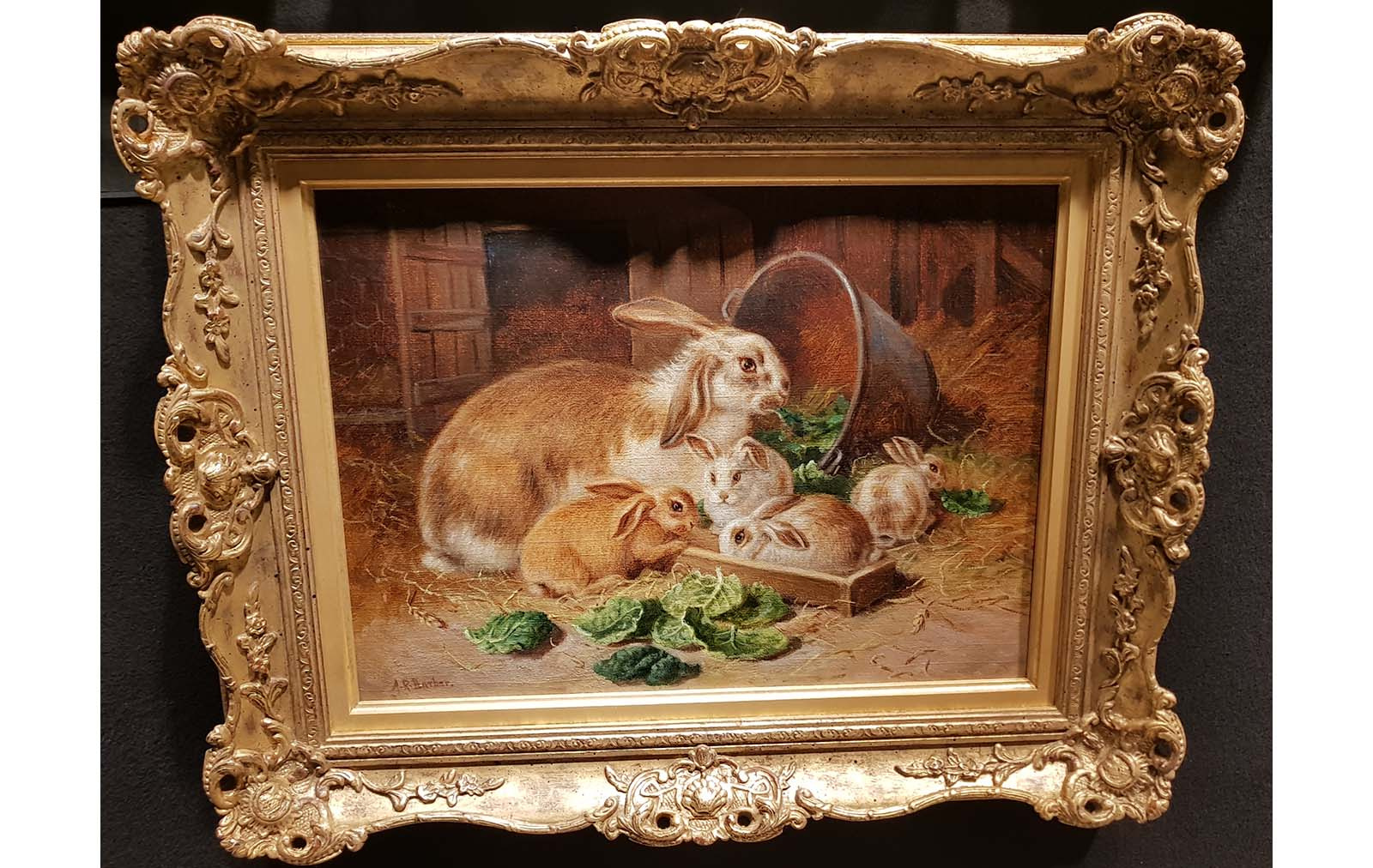March & April 2019
Heidi Klein
Heidi Klein hosts some of the most creative Swimwear that you will find anywhere. With concessions in Harrods, Selfridges and Harvey Nichols and select online outlets such as Matches Fashion the Outnet the brand has gone from strength to strength since it's foundation in 2002 by Heidi Gosman and Penny Klein as the UK's first luxury one-stop holiday shop. The duo aimed to re-invigorate resort wear with their Notting Hill branch resembling a retreat form the US eastern seaboard. Where they have really made their mark though is in the cut and fit of swimwear, bringing fresh ideas to a global audience.
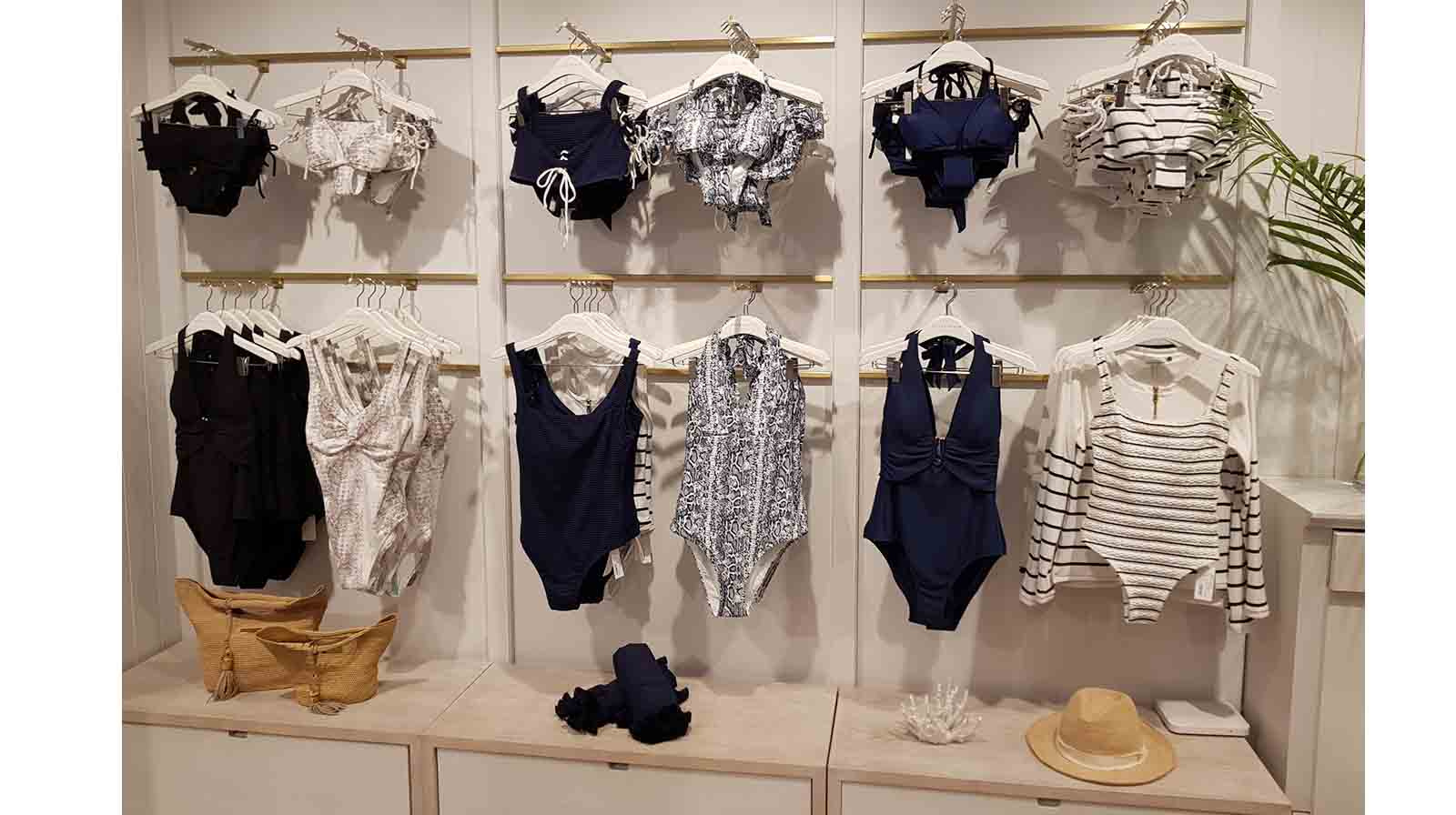
Colour is a key feature of the collections with naval Blue, White and Red heralding a bold marine presence. A Lapis Blue bikini features escalloped border detail on the top above to the right hinting at the movement and beauty of the life within the ocean can be worn with bikini bottoms or possibly shorts. A full swimsuit is also available in the same fabric for a more relaxed alternative and Heidi Klein are very good at making sure favourite fabrics are available in a multitude of different styles to wear. An attractive hand painted design shows the spontaneity and charisma that the brand encapsulates. Freehand lines and dots in light and mid Blue echo the carefree summer days of the seaside and childhood drawings and illustrations. This small bikini size is a daring cut but a very handy grab for the suitcase or weekend bag for those with curves to show off.
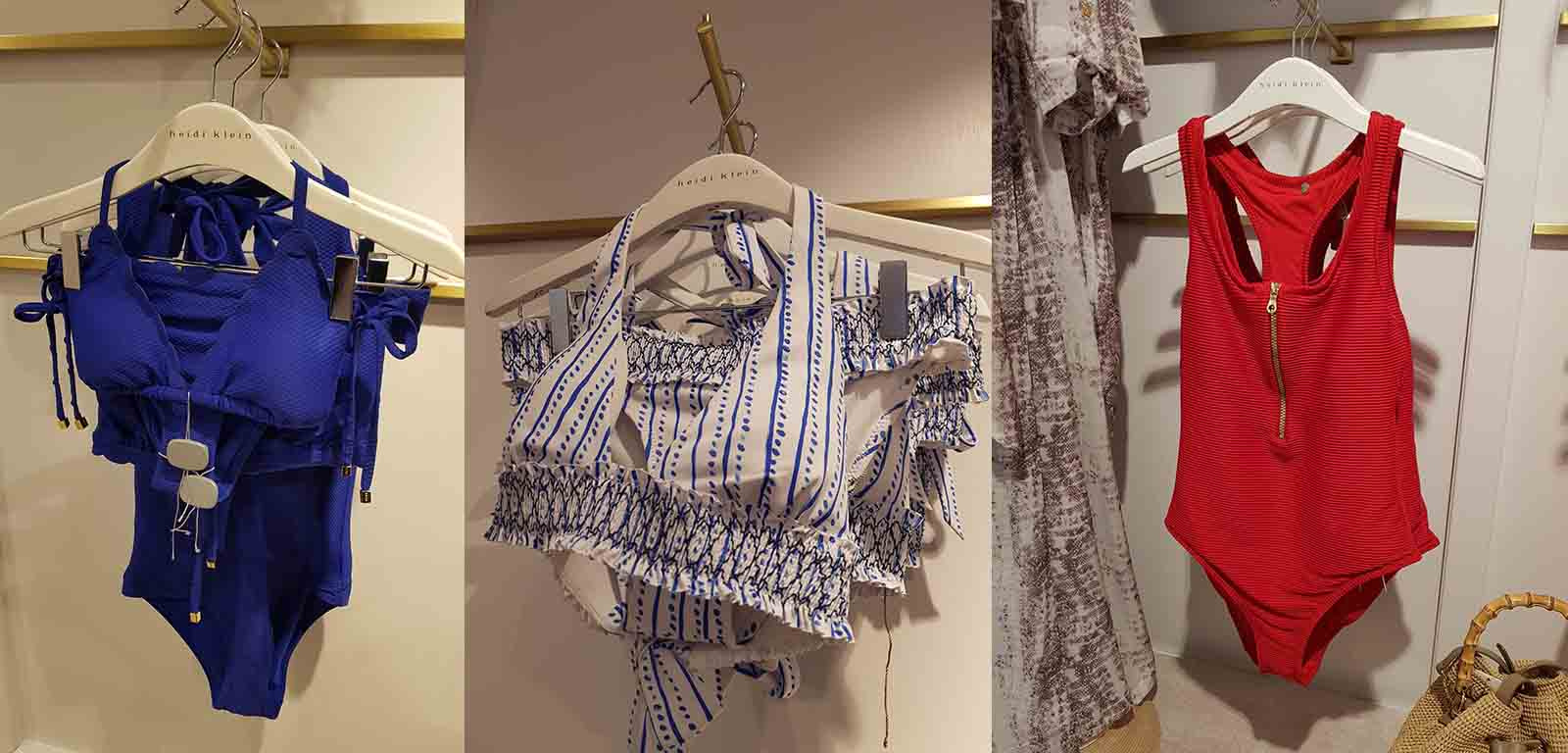
A Scarlet swimsuit with a front fasten zip is a perfect sport/leisure suit for swimming and surfing or wind surfing. It;s bikini counterart is accented with a sweet fold over tie at the lower neckline. Like many looks in the collection, you can easily spot resortwear pieces to coordinate and loose flowing kaftans and gowns in variable lengths are easy to wear and light as a feather in the travel bag. Below you can see variations in two bold prints that can be particularly complimentary when worn with single block colour swim pieces. As ever Heidi Klein are also in a fine form with hats and weave clutch bags this season. They are the super-easy pieces to grab when you're heading off the seaside or pool to spend time having fun and relaxing.
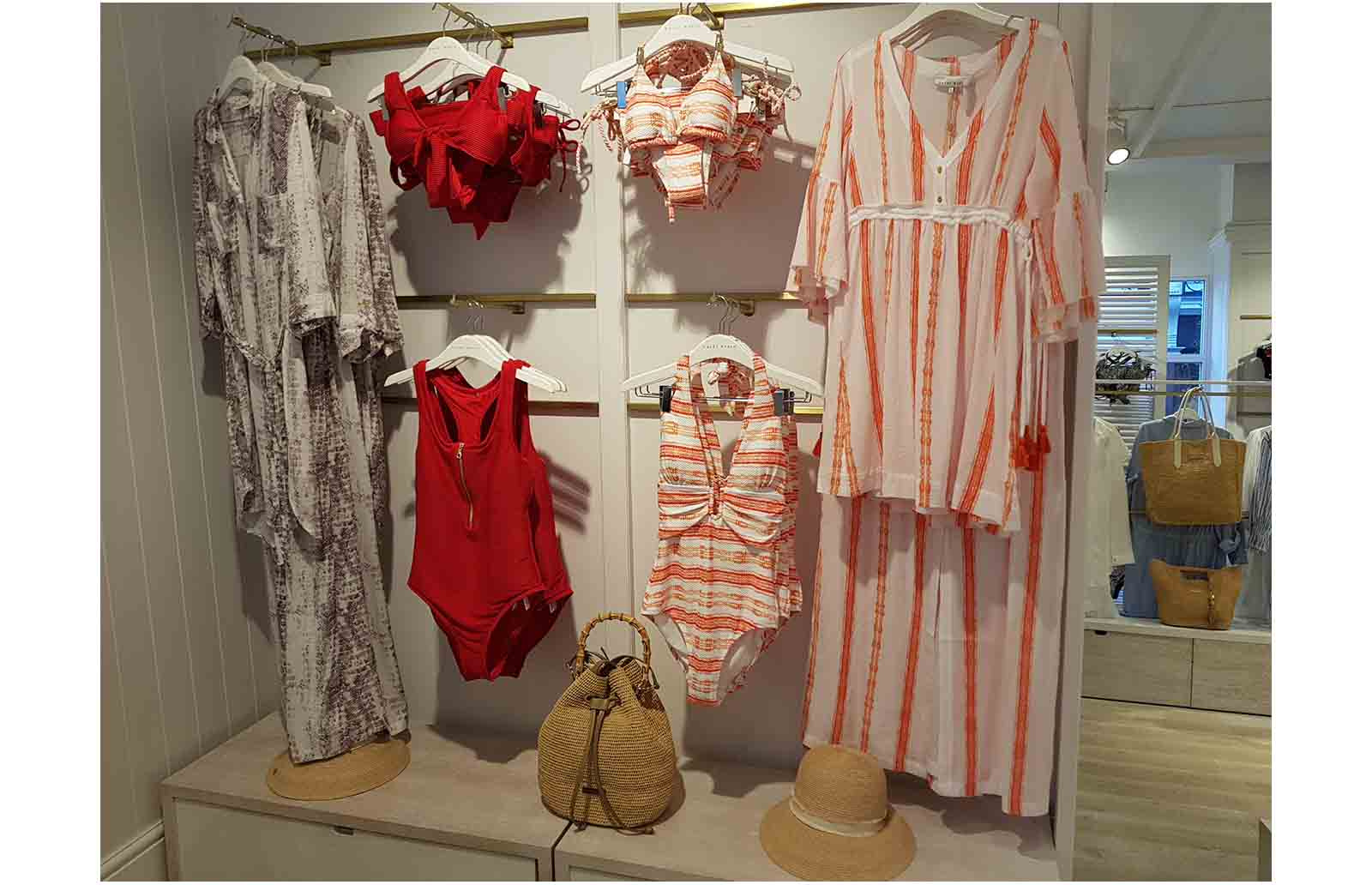
A subtle Emerald/Teal makes a statement addition to the new season collection for Summer 2019 and comes in both bikini and swimsuit variety. With a sense of cool classic elegance about it, it makes a discreet statement for the Summer season wherever you may be spending it around the globe. Swimwear for the home pool and local dipping spot is also worth investing in to enjoy and help you relax to the fullest. The plunge of the V neckline is accentuated with a gold bar that forms a central symbol of strength as well as defining the line of the garment. Not to be missed is the Black woven small ‘grab bag’ that would be an easy to style piece across the seasons at work and play in general. Subtle like much of the collection, it would make a lovely gift for a special person and bring a smile to their face.
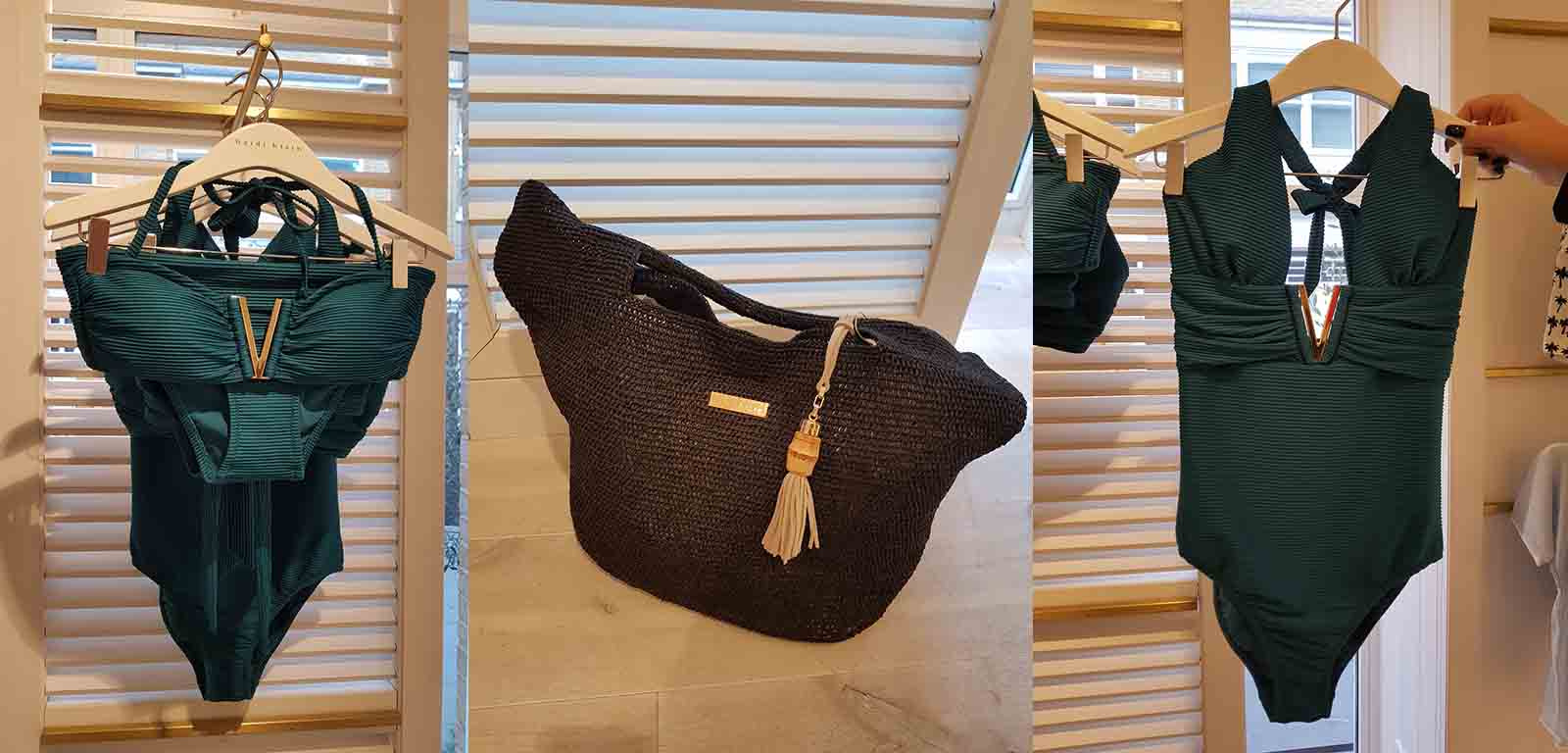
Easy wear pieces to wrap yourself in beach side, poolside or anywhere you wish is one of the areas of the Heidi Klein collections that are the most versatile. This season they have a selection of garments in White cotton Broderie Anglaise as well as the mesmerising Chambray Blue that have formed into a series of light and easy to wear garments including dresses, kaftans and shirts. A light sky Blue that brings thoughts of bright sunshine days, makes a perfect colour choice for picking up a new garment and worked into both Bikini and Swimsuit shapes, it’s an easy elegant look.
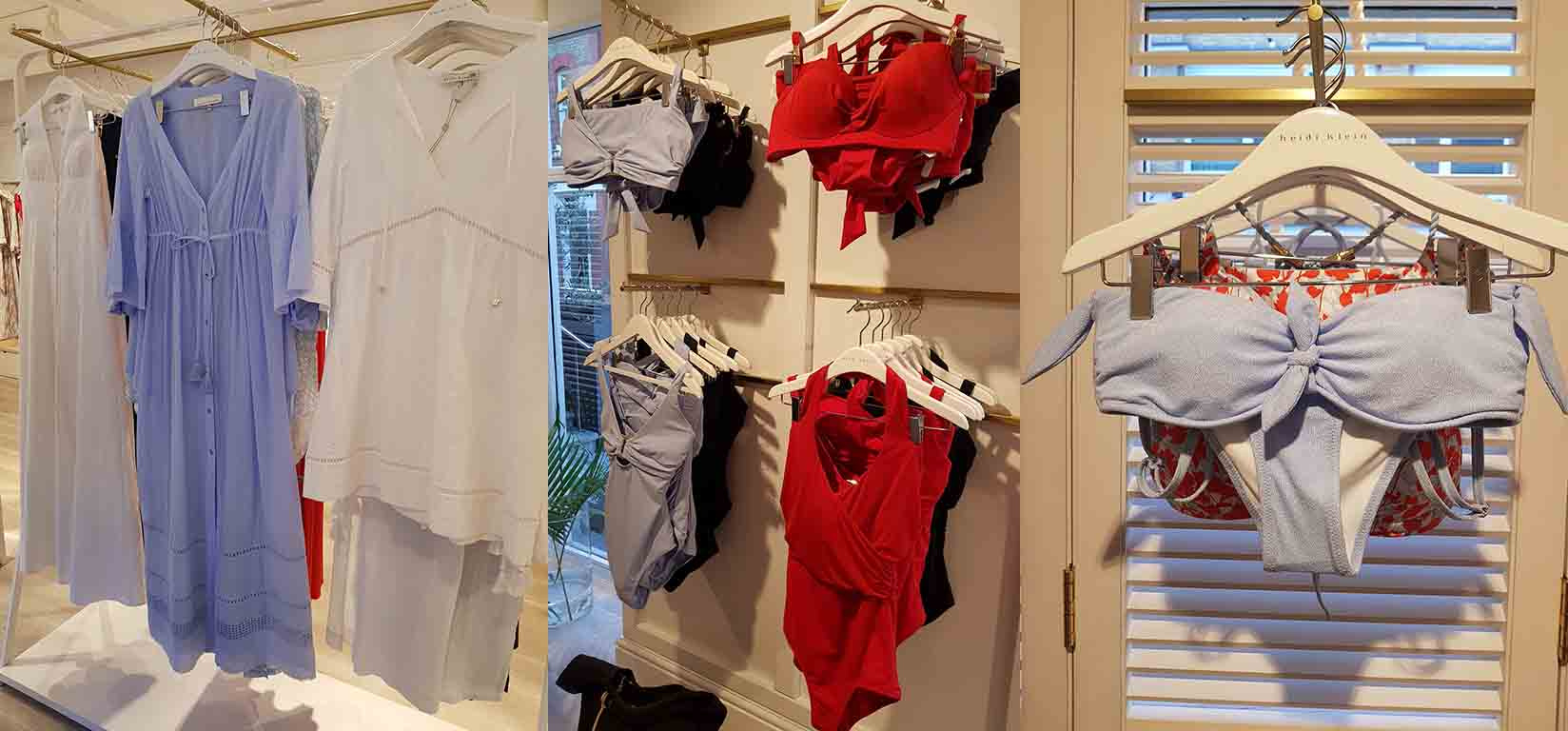
Bold Scarlet also returns in Bikini and Swimsuit shapes with plain Black also behind as a neutral colour option. Several of the pieces feature a sweetheart toe detail around the neckline of the garment and add a sense of prettiness without seeming childlike. A bandeau bikini with super soft fabric highlights the versatility of a classic colour mapped onto a series of different style modes.
An Umber-Red floral print dresses makes a loose easy to wear addition to a Summer and travel wardrobe and blends in a perfect clash/contrast with a Light Blue Chambray woven fabric Swimsuit. Smock detail around the waistband cinches the garment in around the figure gently as well as creating pretty design feature. The pieces look crafted rather than designed and it adds to the aesthetic of not trying too hard but looking composed and natural.
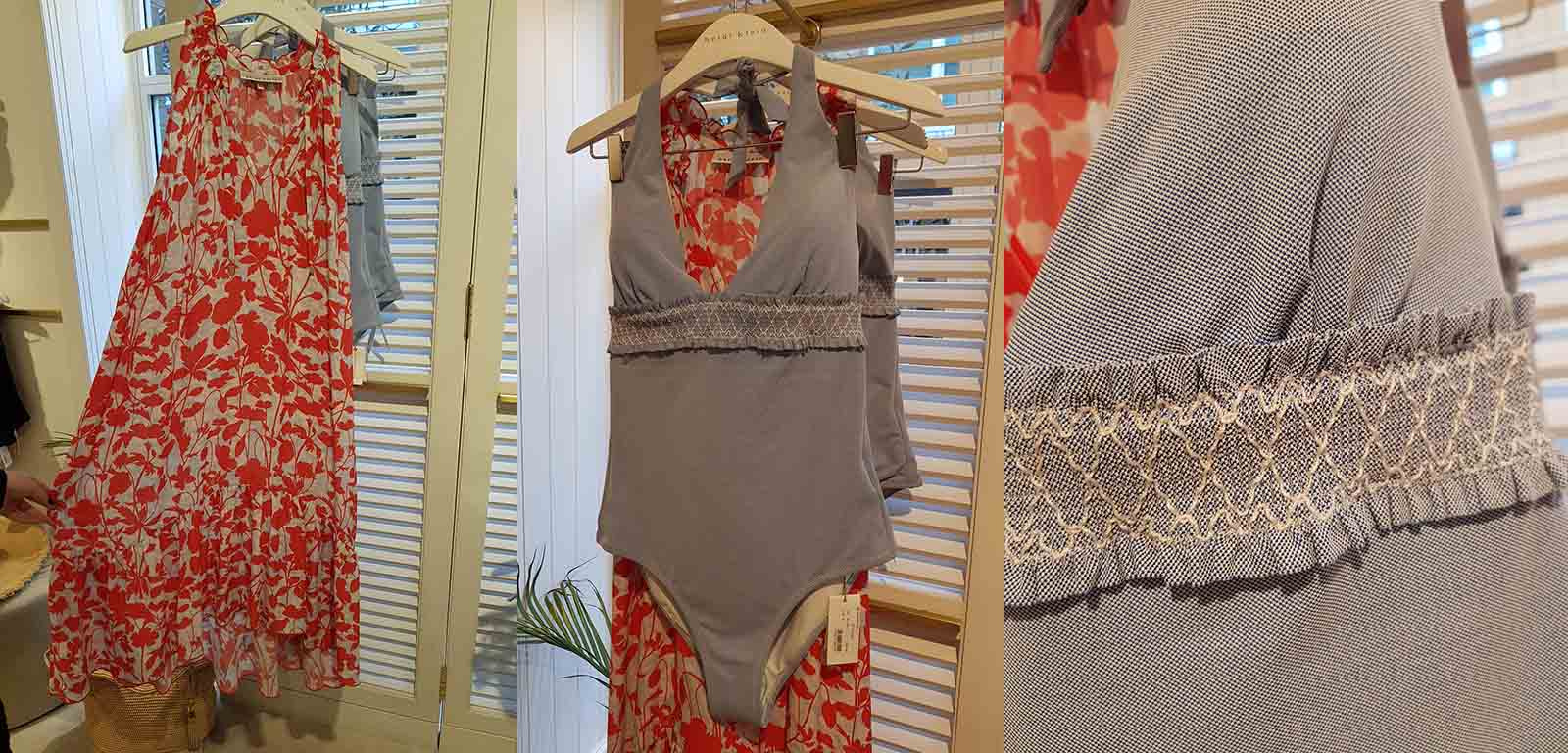
The hand stitched inspired design appears in several other colourways of the signature V neckline design including Navy Blue and Scarlet. Adapted to both Swimsuit and Bikini shapes, it creates the subtle design contrast the forms the appearance of elegance in the mind. Bandeau tops also appear in Scarlet offering another option for leisure wear and above and below you can see examples of more the ‘must-have’ Heidi Klein totes that are as much on the ladies wish-lists as the swimwear themselves.
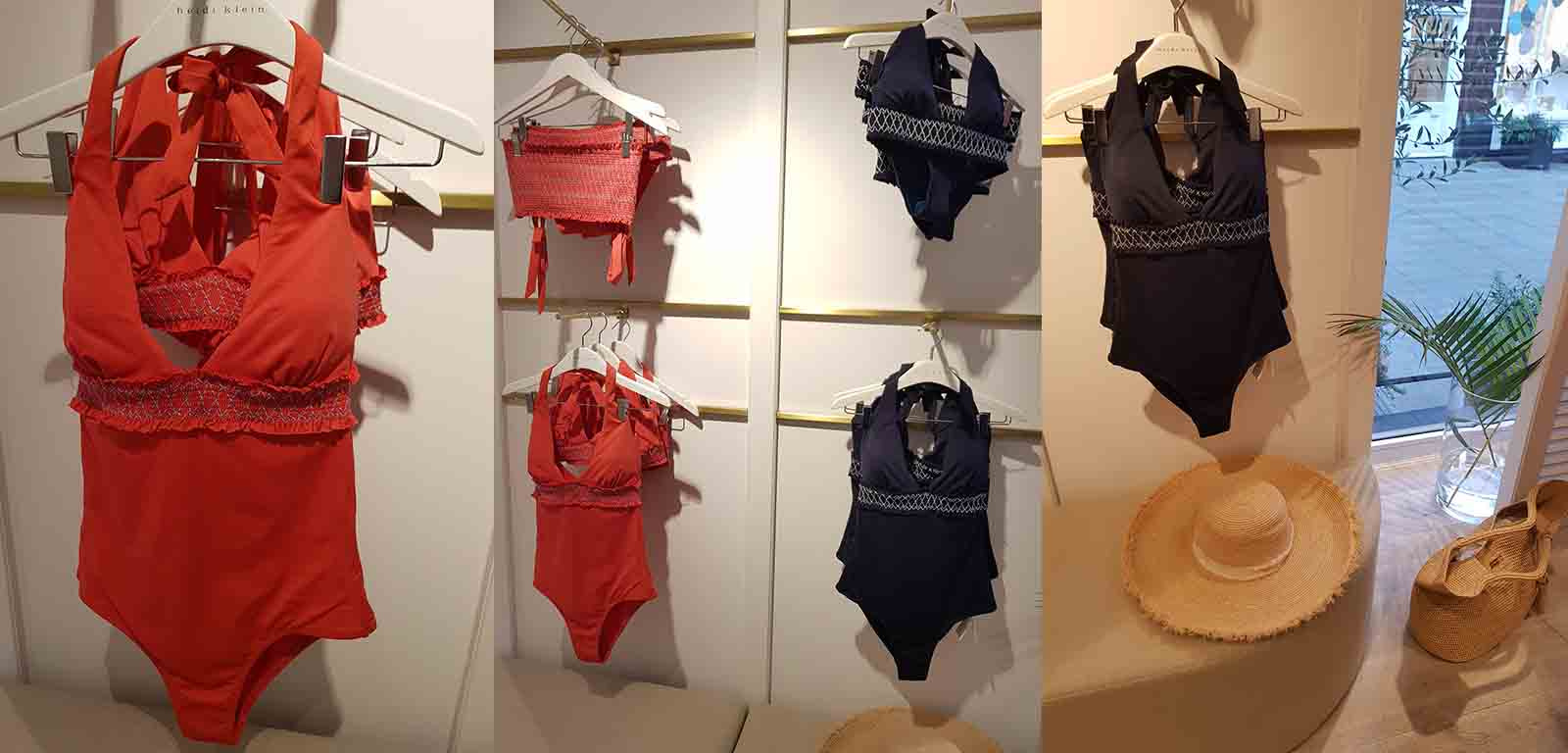
Hints of craft also appear below in a White quilted design bordered with Black piping. A Swimsuit features an attractive back bow tie and the Bikini top is cut along the lines of sportswear to emphasises an active lifestyle. The look doesn’t become utilitarian though at any point and the ensembles still retain a feminine appearance. To the right a Black Swimsuit sculpted at the neckline in a moulded metallic arch draws the thick sashes of the centre of the centre of the garment in a bowed shape. If animal print is your thing (not mine), the snakeskin Swimsuit to the far right brings out the patterns in a soft delicate form. Beneath, two more handy woven beach and travel bags that you could take anywhere through the Summer.
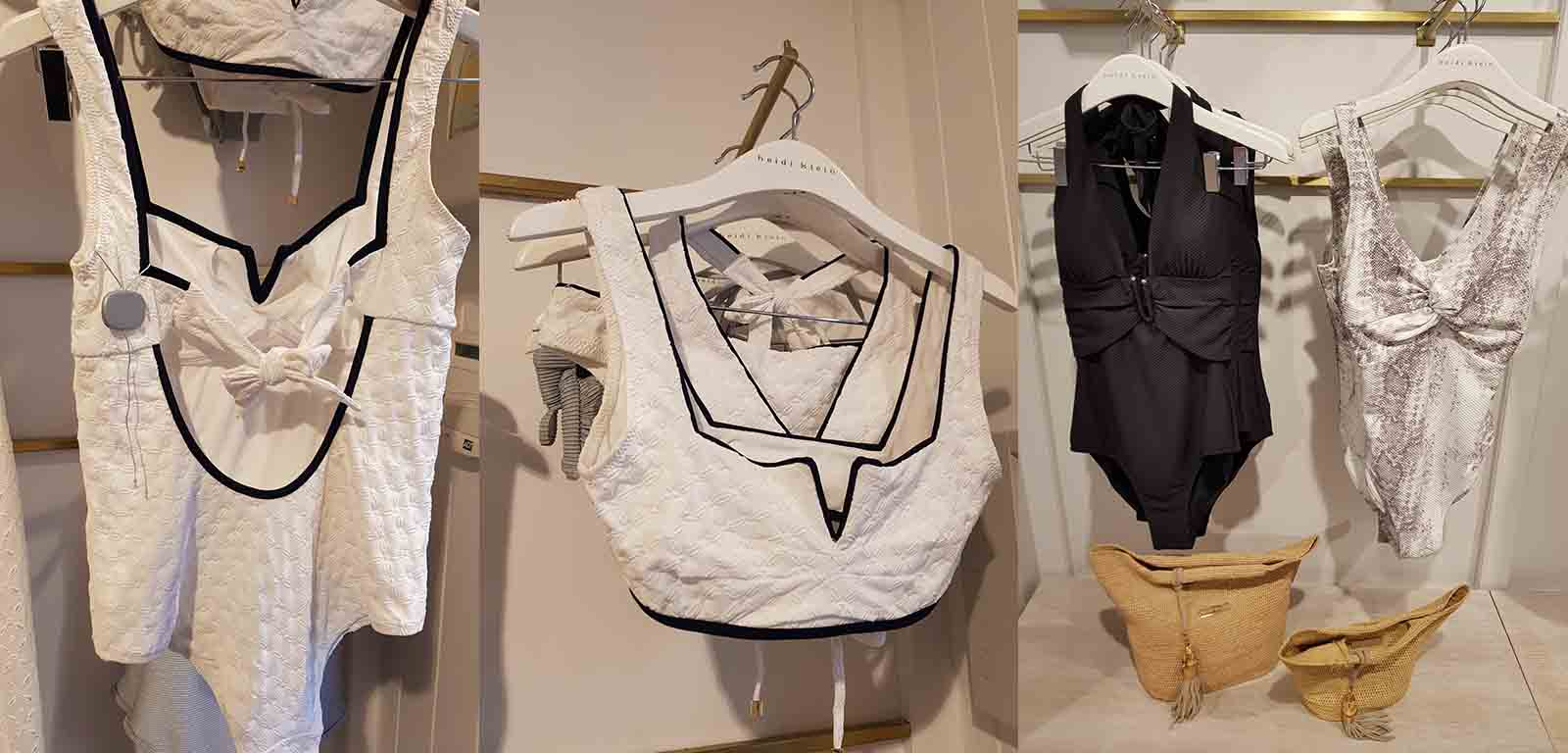
A playful contrast between the sweet and sporty is created in the suite of Baby Pink Swimwear pieces that feature lace-up detail. This nautical hint also echoes the ties on sails and rigging with its thin White woven tubing and eyelets. The fabric itself is woven in a ribbed style that also reflects the weather proofed fabrics that kit out boats and fine their way into boating gear. It somehow blends the cute and the action-ready into one and creates a look of beautiful strength. The open threaded back also gives a glimpse into the care taken in the structuring of the garment and the simple sports-style Bikini top centre above. To the right, the front facing garment shows the effect of well-cut simplicity that the design creates. A modern classic and again, as with many of these pieces, they would make a special gift for a relative or a friend.
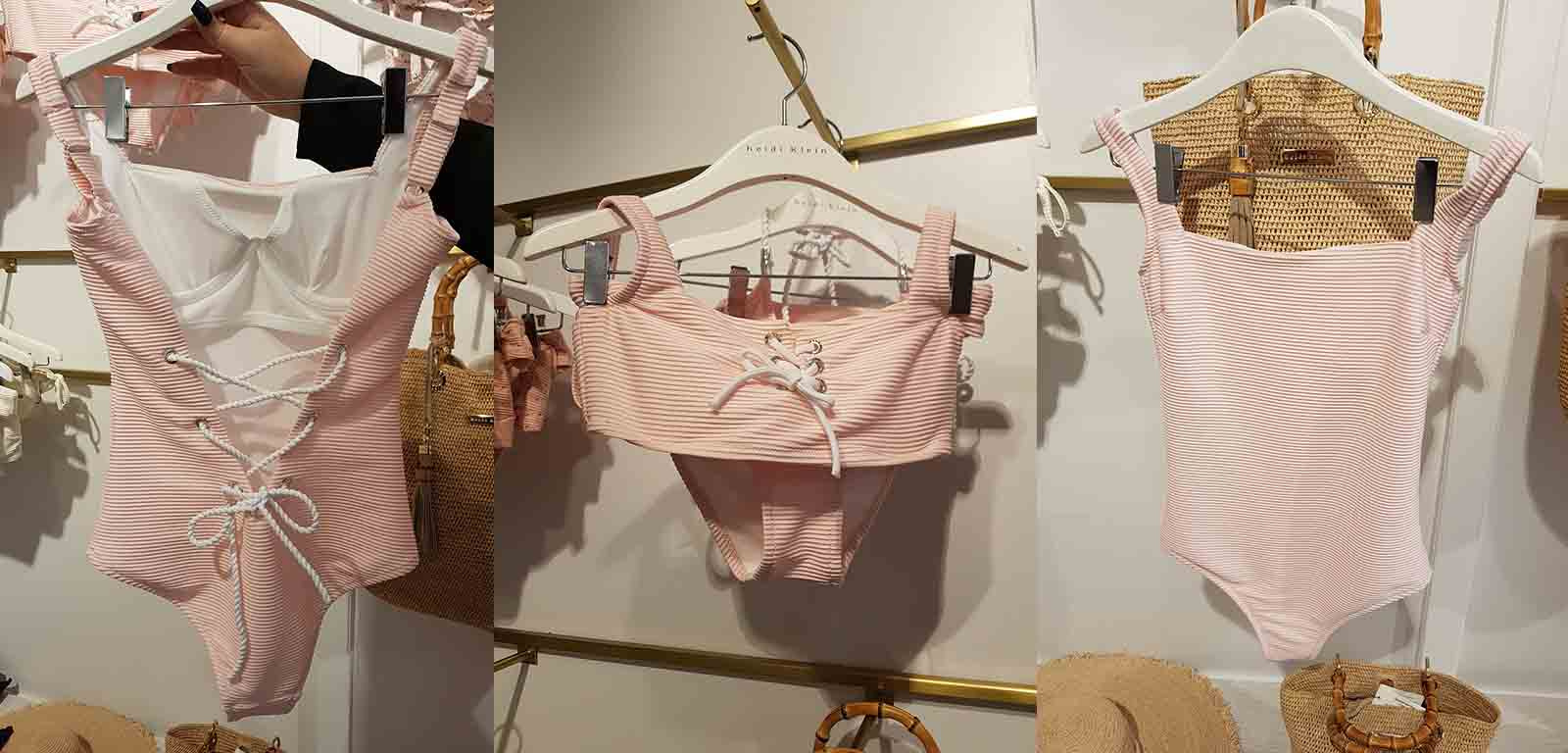
The Baby Shell-Pink continues through into several styles with a crochet style appearing in a beautiful light bikini set that features small cut away detail backed by an underlying fabric that gives an opaque appearance to the garment. A simple Brown running stitch-like print crossing the surface of a Bikini sits on top of a clever 3D White cube design offering an optical illusion. It also features in an easy to wear ankle length dress to offer another style match to suit your mood by the water. Generally Heidi Klein pieces have the knack of suiting women across all ages and it’s another universal fun look to wear.
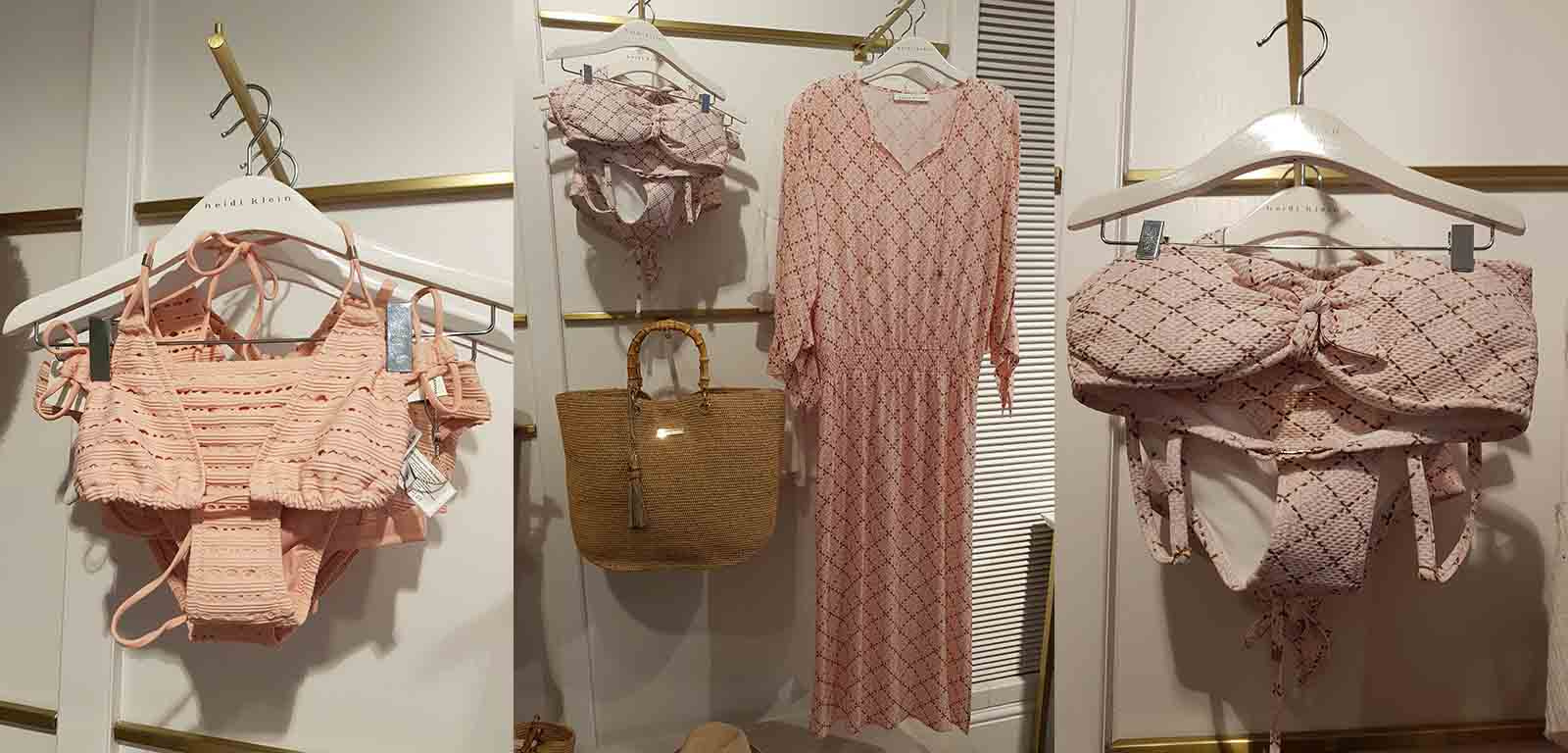
The classic marine Blue and Cream-White colour scheme offers a perfect starting point for designing both accessories and swimwear pieces. Tightly woven raffia work creates a soft base for the design of two clutch purses that you could wear anywhere during the warmer Summer months and would also make wonderful gifts. Synching perfectly with a neighbouring Cream coloured Bikini it shows how mix and match is a central core to the Heidi Klein collections. A bamboo wrap clutch shows how the classic style can be adapted to a sustainable wood source and bring in echoes of warm places and sunshine days. It’s a good depth and you can fit several things such as car keys, money and a phone in so super-handy for an evening out.
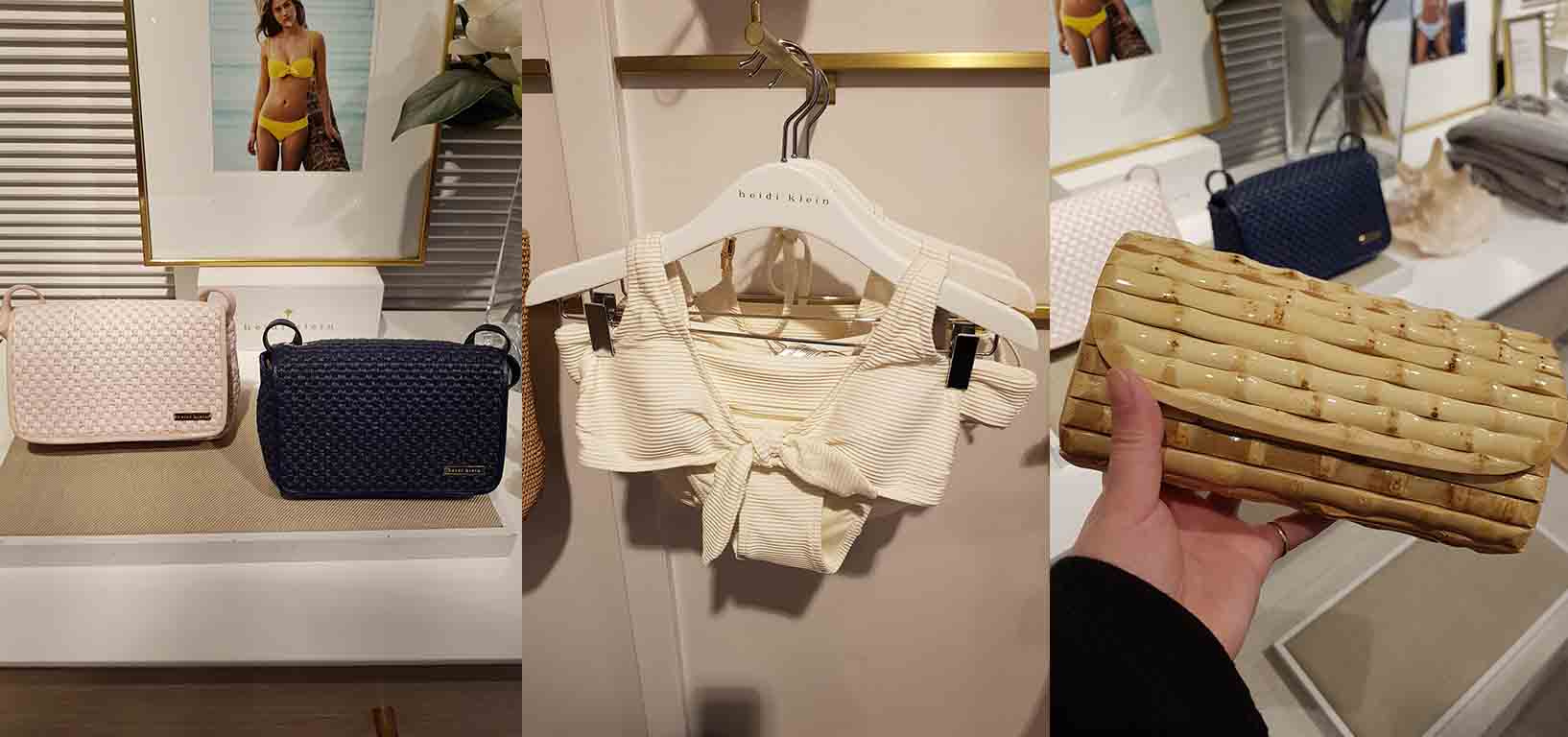
Broad checked cloth is another Summer staple harkening back to vintage scarfs and picnic blankets for beach barbeques and reading in the sunshine. It carries the fresh light carefree feel that the brand encapsulates and whether you’re on a beach in Cornwall or New England, it’s a fun option to add to a bright sunshine day. A Swimsuit with a broadly stitched open back and a Bikini bordered with the same thick White band offer two different ways to enjoy the colour scheme. To the far right you can see three colourways expressing the nautical theme in very different ways. A light crocodile print style captures the power and energy of the mighty river creature in both Swimsuit and Bikini whilst Navy Blue in the two style options forms a composed classic. Harbour stripes in Navy Blue on a White background make a classic option for Swimwear or comfy casual pieces and Heidi Klein capitalise on this with a light sweater with round neckline looks ready to hit the beach or shorefront town.
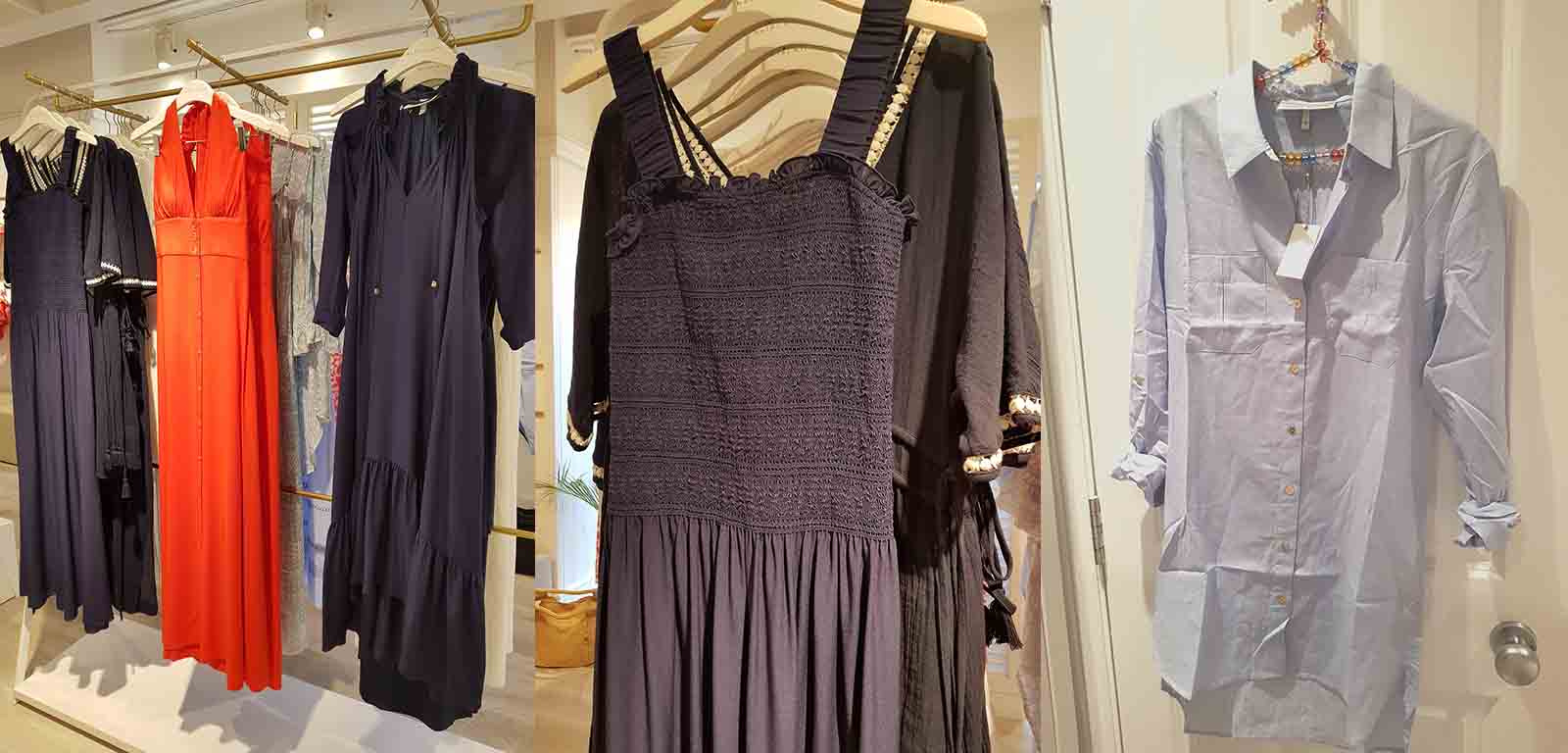
Heidi Klein leisurewear is really beautiful and an easy addition to make to the wardrobe. Above to the left you can see two long Navy pieces that stole my heart with more further options behind. Dresses ready to billow in the breeze on deck or onshore capture volume effortlessly in their lengths and centre above a close-up of the ruched gathered smock detail that brings this traditional aspect of design up to date in tired layers beneath the neckline. To the right, pre-Iron and crumpled by me, a beautiful blouse I was gifted from the Heidi Klein team which will be worn with pleasure this Summer in the sunshine. The light cotton feels pure and almost silky as, in fact, the finest woven cotton should.
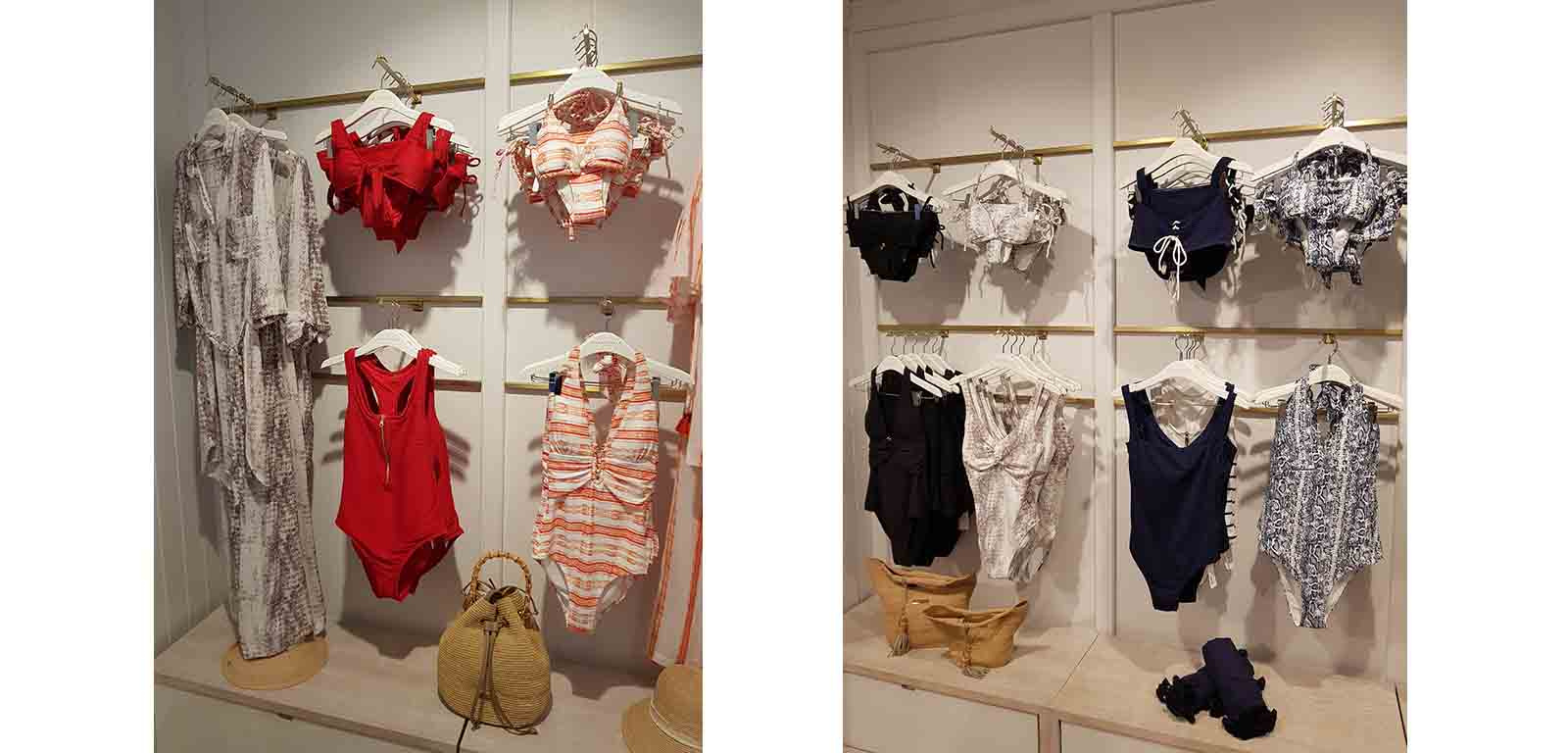
To close a look at some of my favourite pieces from the offering for the coming season that show a variety of ideas for the way that you can style looks to enjoy in and by the water. I’m a water baby and love sea swimming but wish I could do it more often. Add to this the bountiful offering from a designer that takes their Swimwear very seriously and the core of their business and something makes me want to head to the sea very soon.
QUEST Craft hosted by Halcyon Days
Halcyon Days is a traditional British enamels specialist that preserves the tradition of handmade fine craft in the United Kingdom and, just as importantly works to develop and maintain the skill base that enables production of these objects to flourish and endure. This Spring from the 5th to the 15th of March the Halcyon Days store at the Royal Exchange in the Heart of the City of London showcased the work of Harry Forster-Stringer as Queen Elizabeth Scholarship Trust scholar who has gone on from the program to found a carer producing the most beautiful engravings, enamel and also developed his work as a Gold Smith. He began enamelling in 2000 and his first pieces where rings and pendants that will coincidently often be one of the most requested items from clients.
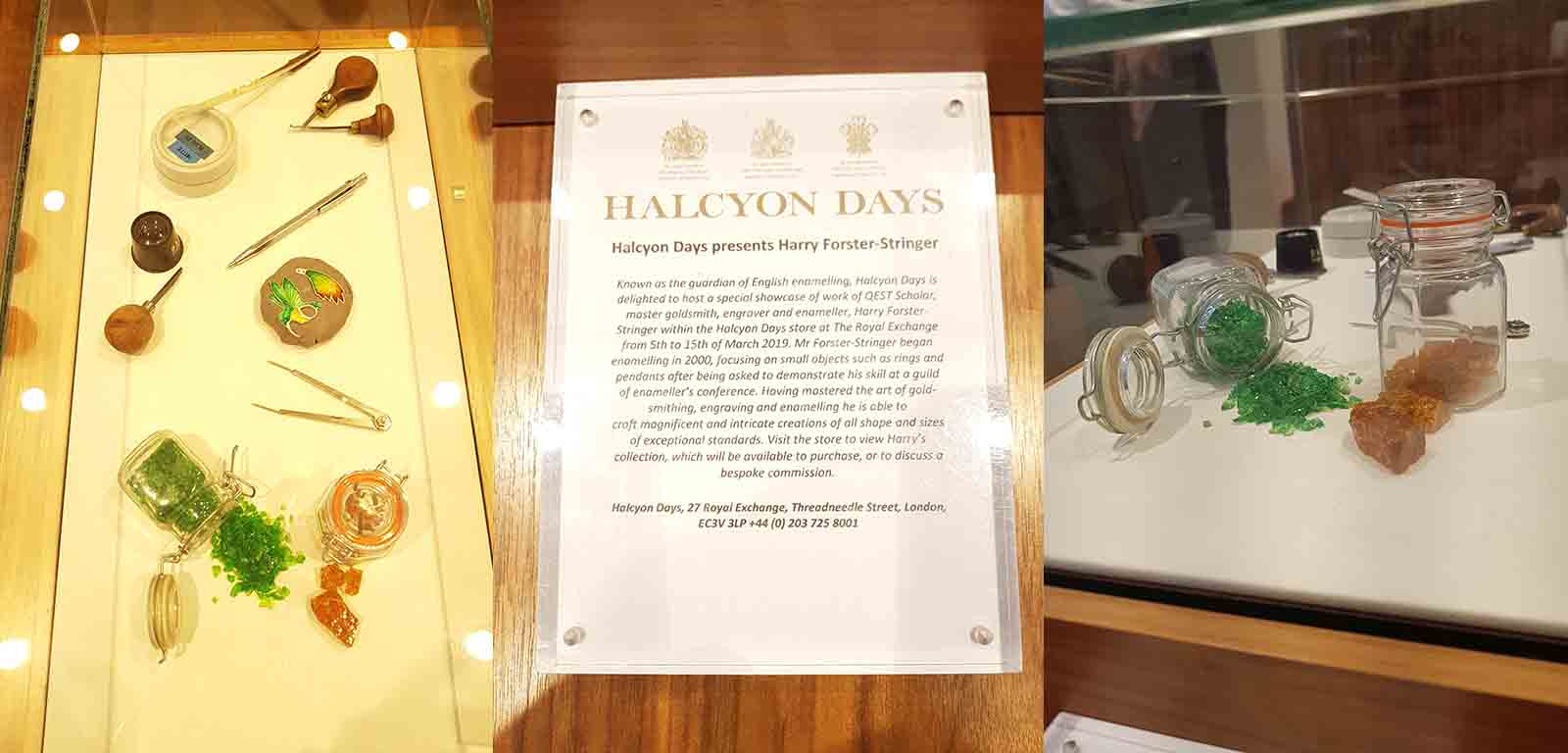
Below the tools of Harry’s trade are placed in cabinets so that visitors to the store can appreciate how faithful to traditional tools and technique the crafts of engraving, gilding and enamelling are to the past. The pestle and mortars, the chisels and even the quill. How many people in 2019 can still say that they work with the same instruments that were used 400, or even 1000 years ago, in their profession? I would imagine not many.
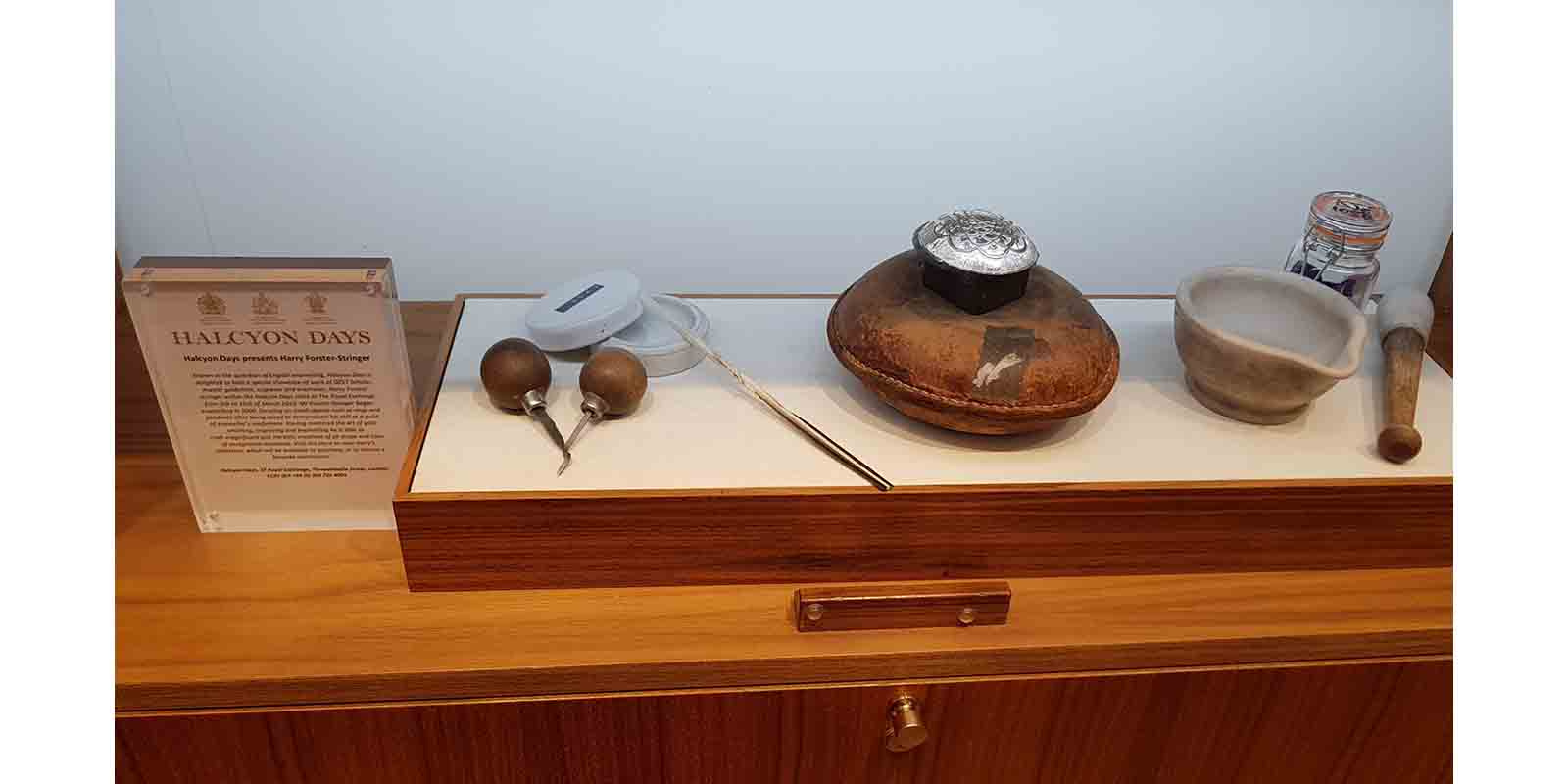
It’s like alchemy and watching magic being created. You can understand why people with knowhow and craft have been revered and honoured for thousands of years for turning base metals and crushed glass into something superb and timeless. Seeing the brightness of the glass pigments in a jar and then the beautiful hummingbird articulated and brought to life in the guilders hand.
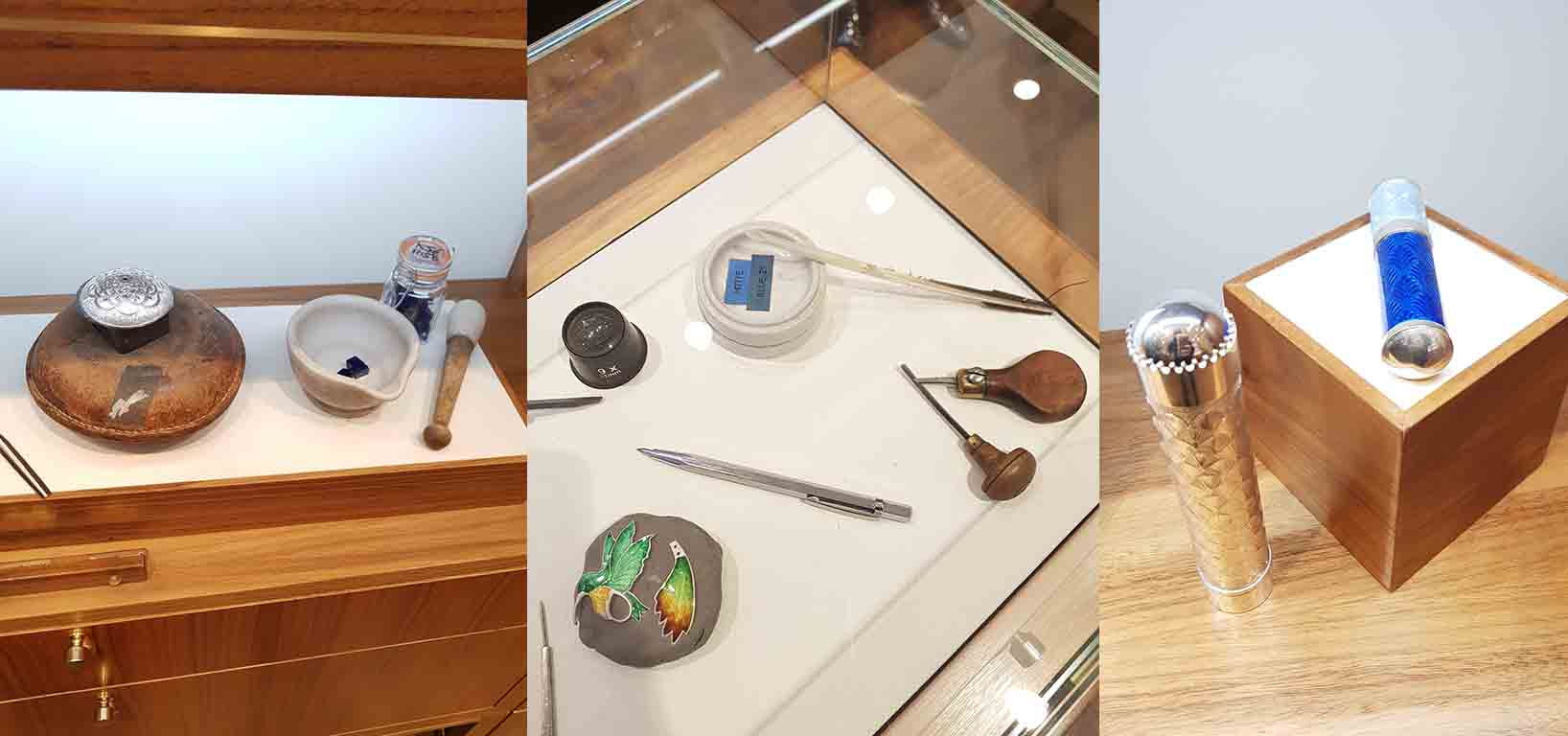
The colours and the shine that come from the enamel pieces are what makes them so memorable. It’s part of the charm that has attracted people’s eyes for centuries. Below two small trinket boxes and a lid displayed to show the detail of the working of Gold and Azure Blue together into one swirling dream. Look at the detail in the lines worked through the colour to give an impression of texture. A selection of cuff links again demonstrate the tremendous power of the clarity of colour harnessed through the enamel craft process. To the right three pendants with Mother of Pearl tones matched alongside Green and Teal again allow you to own a piece that would show the technical expertise of a craftsman like Harry to full effect.
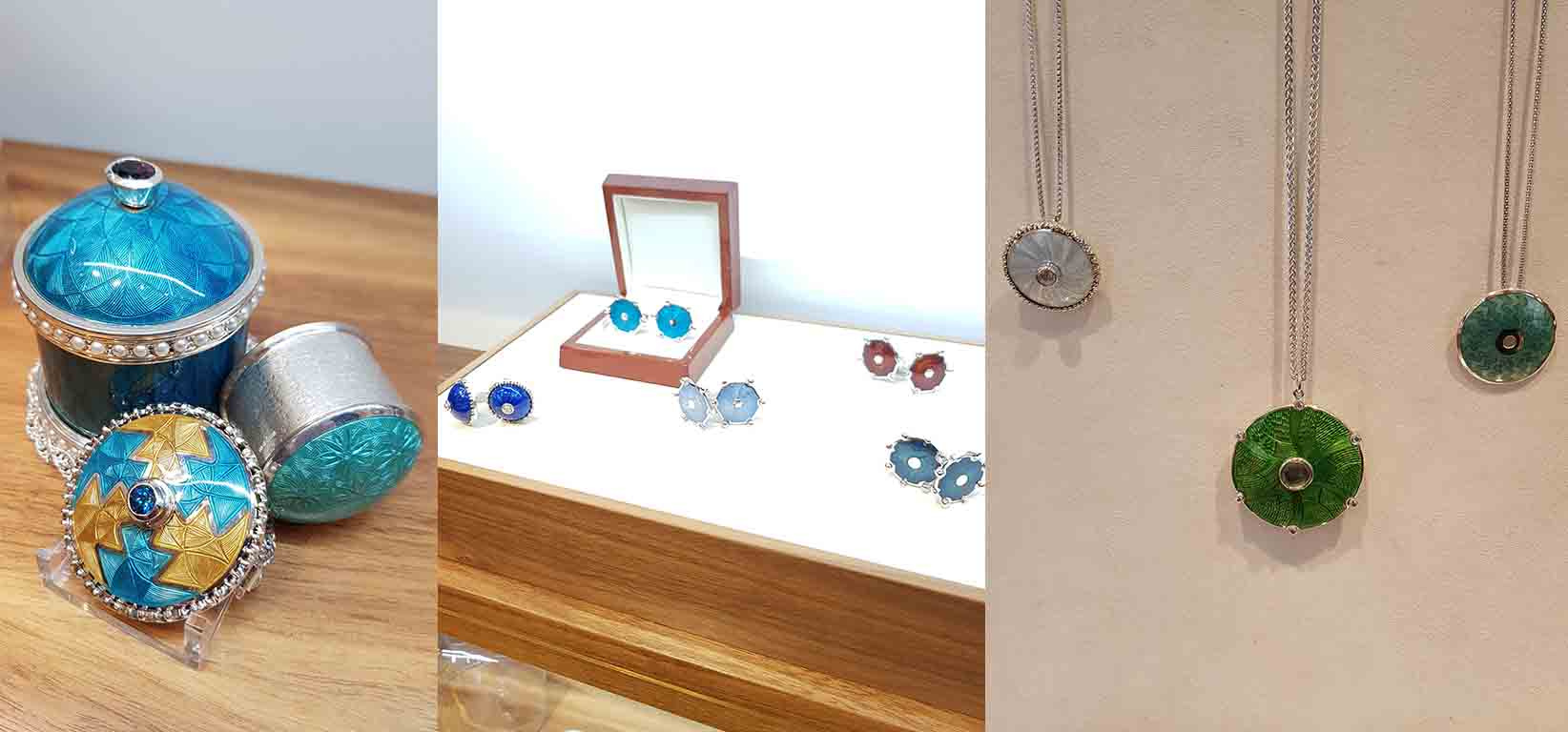
His works have a feel of individuality and you can see why clients choose to commission special pieces from him. To the right and left close up images of two pendants show the beautiful effect of marbling and movement, I’m almost lost for words to find a way to describe the patterning, that appear in the body of the pieces across the surface. Things of beauty have attracted the eye of clients and connoisseurs for centuries and their appeal is genuinely timeless. Speaking of eyes, the lucky Blue Eye amulet shows in high relief the clarity of detail in the composition of the amulet’s form.
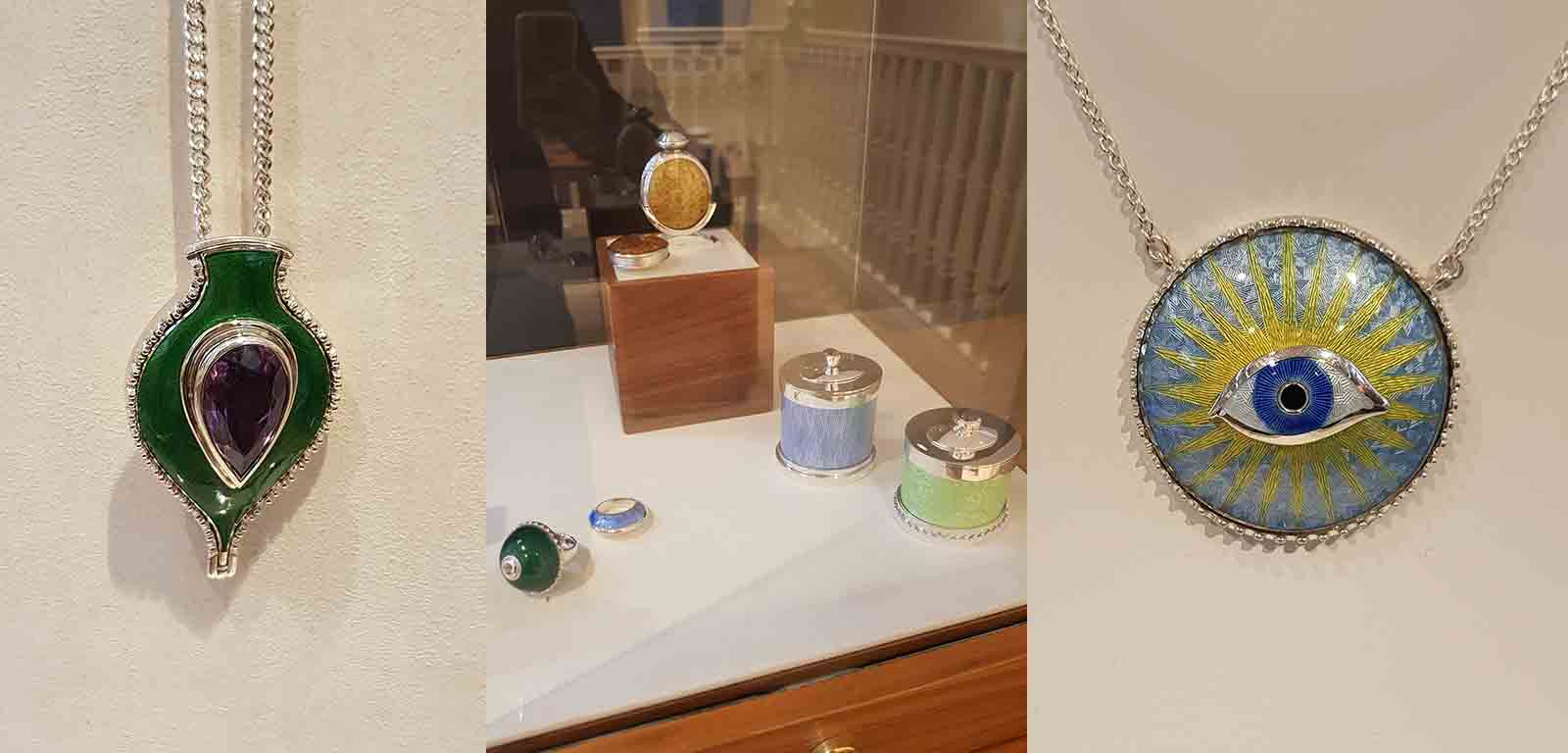
Golden rays of sunshine span out across the clear Blue sky and the clear light Blue features across several other pieces. Two jars in Blue and light Green that could hold votive candles are perfectly accented with strokes to create patterns and swirls. The magic of the night sky is drawn to earth with the moon and the stars represented on the surface of a pot. Almost shaped like a magic lantern it’s something beautiful to make a wish on. To the right below you can see some classic Halcyon Days designs that clients keep coming back for, a pastel parterre plate and a pill box sit close to a Primrose tea cup and saucer from the Castle of Mey collection.
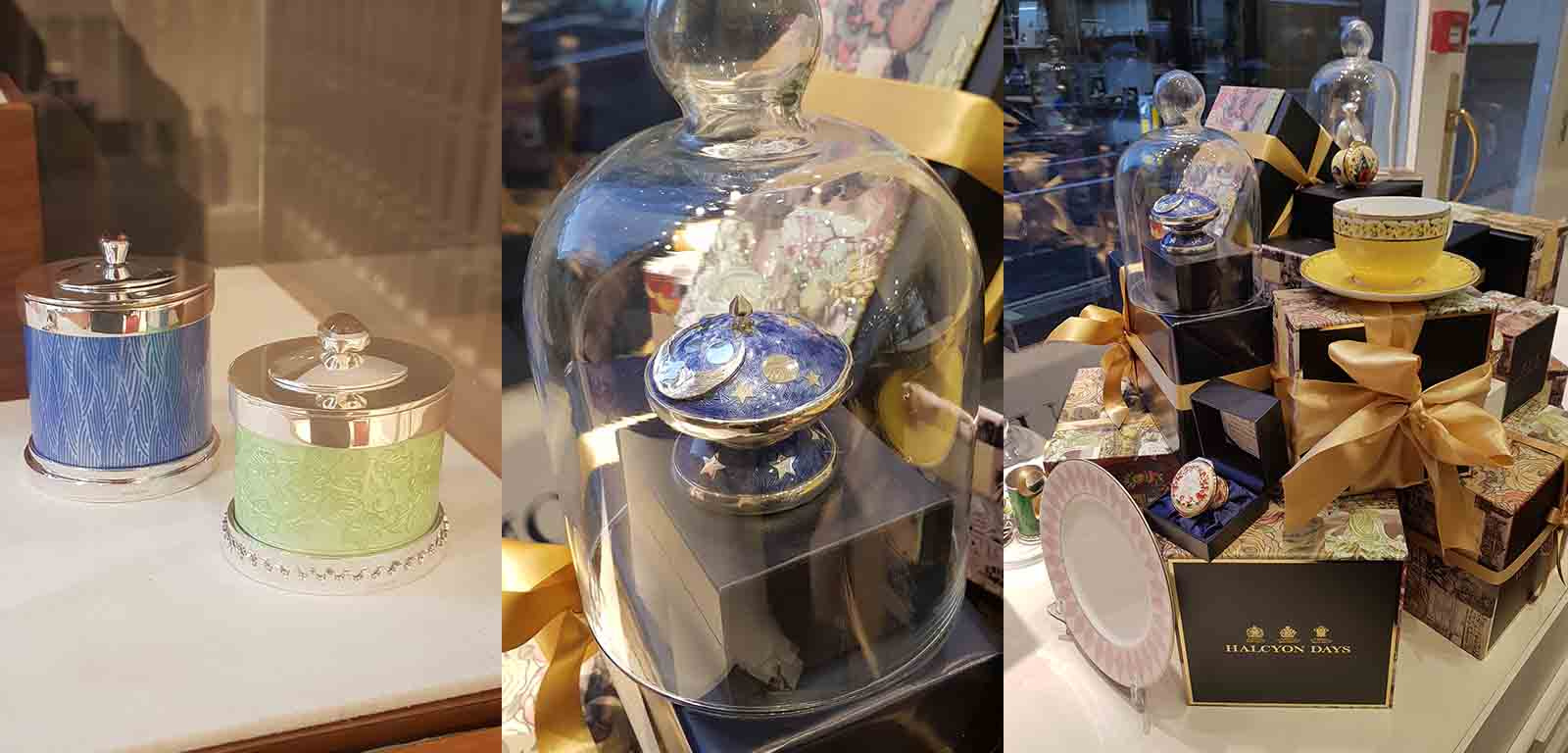
Mary Quant at the V&A
She helped a fashion revolution get going and dressed two generation of women across the globe defining an era. That’s quick to say in one sentence but the change that she made to women, their lives and their voices within the fashion industry was completely historic. At a time when British industry was coming under threat she employed large numbers of men and women in the garment industry and she founded a British designer label that was one of the first to be able to reach women across all areas of society and give them the freedom of readily available choices. The clothes themselves are easy to move in support the carefree liberated feeling that swept through society in that era.
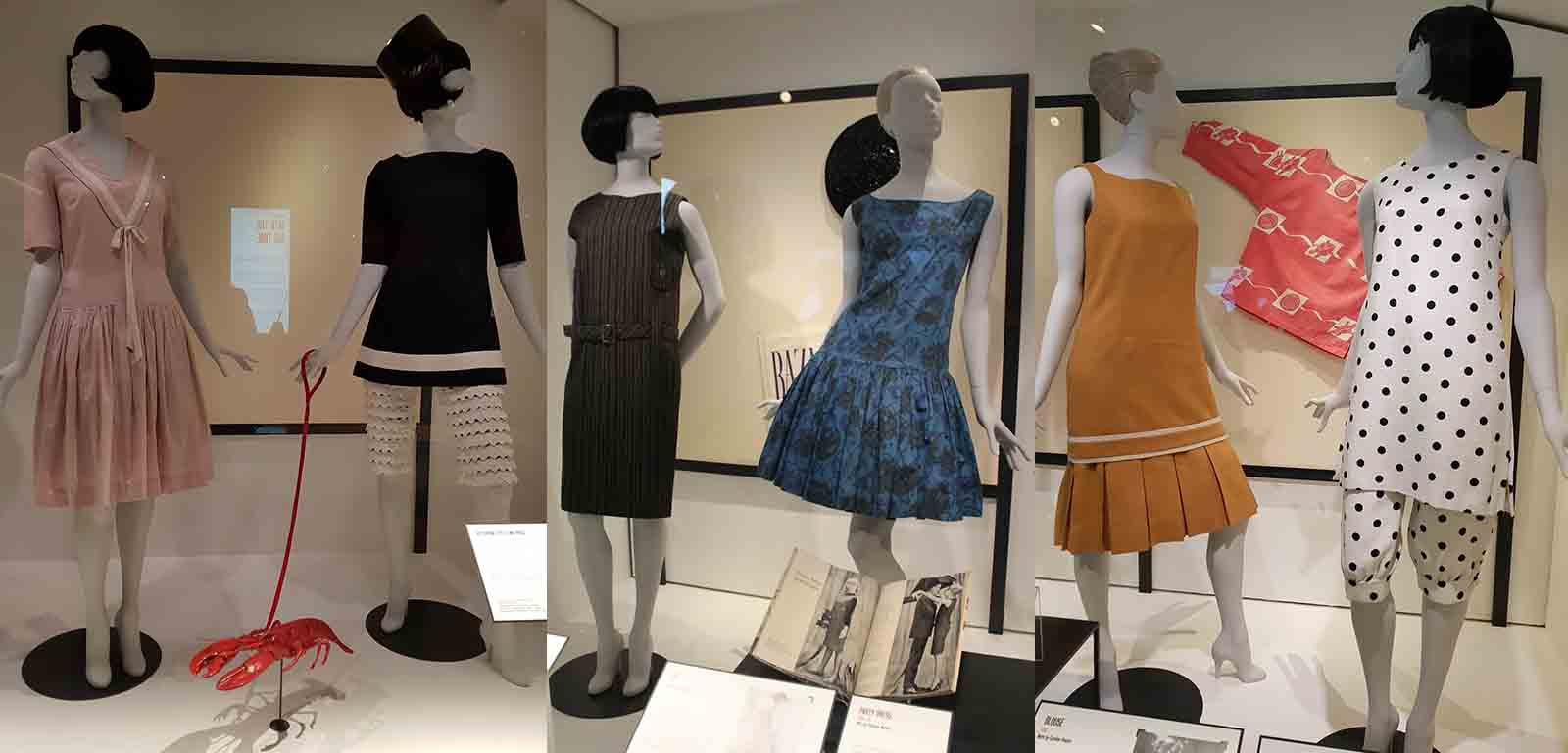
Clothes that where easy to wear fitted straight into the lives of the wearer. A Rose pink sailor style dress could be worn on sunshine days across the world and hits the mark in creating a fun look for Quant’s burgeoning young client base. Fun and practicality are two things that return as recurring themes again and again. Although Quant was determined to take on the fashion Houses of Paris and show that all women could aspire and be fashionable aside from the rich few, she does perhaps make a nod to the irreverence of Haute Couture pioneer Elsa Schiaparelli in the swimsuit piece showing the model walking a Lobster on a dog lead. The combination of the Victorian bathing suit and the impossible idea of a sea creature pet perhaps speaks to the ludicrous history of women’s fashion; for centuries women had been dressed by men, largely for men.
Women of all walks of life had had little choice and were in the advanced guard of a generation experiencing economic independence. Interstingly whereas the 18th century had brought many women freedom to travel and own businesses and work, the 19th century and following decades of the early 20th seemed to keep women in a guilded cage of sorts. Quant was dressing a young generation of women, many of whom were working and buying their own clothes with a freedom that their mothers and grandmothers may not have known. The designer knew that she was dressing women with busy lives who also wanted to enjoy themselves. There are lots of pieces that we now describe as ‘day-to-evening’ looks and a grey dress emulating the pin-stripe look in it’s linear weave shows the modern women ready for the world of work. A dropped waist cocktail dress in Blue floral print combines the best of the simplicity of the 1920's that was brought back in the 1950’s, 60’s and 80’s to memorable effect and this dress could be easily worn today. The dropped waist is used with a pleated skirt in a mustard Yellow has hints of the tennis and croquet uniform of the summer whilst looking appropriate for the office and a drinks party too. A relaxed polka dot pyjama suit is another look that could be worn through the summer. Also although made nearly 5 decades ago the power of Quant’s influence is very evident in that this outfit looks like it could be seen in a boutique today.
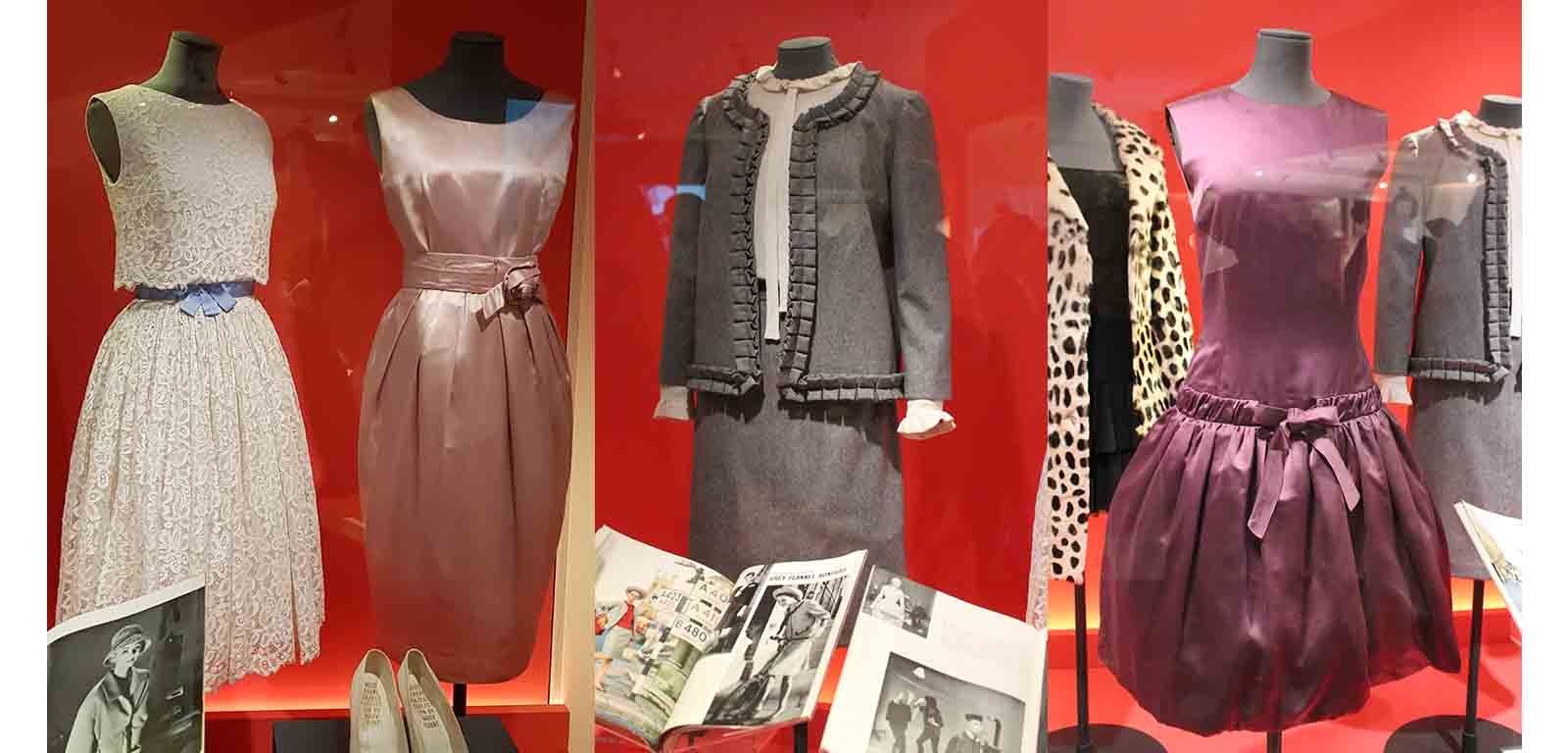
A White lace cocktail dress tied at the waist with a Baby Blue ribbon is perfect piece of occasion wear that is genuinely timeless, you could wear it today and in years to come and if pieces like this are still out there in the world, hopefully they are in number, it could be passed through a family and cherished. A Rose Pink satin silk cocktail dress tied as the waist with a sash featuring a Rose knot at the waist side creates the magic of the Haute Couture atelier at a fraction of the price for the client. This look could have been bought off the peg with minimal fuss after a try-on in store and worn straight out to a party or put into the case for a weekend away in the country. It would hold its own against any designer pieces when it was created and even still today, which is quite an achievement. Many designer dresses from the 1960’s can be worn as vintage but few look as contemporary as this does and those that do, I would say Dior, Balenciaga and Givenchy Haute Couture will be quite expensive to acquire now.
A Grey skirt and jacket suit with White blouse set underneath is a clever smart option that would fit the bill for both work and slightly more formal social commitment such as fine dining and afternoon tea. It has the kind of playful vintage vibe that would make it desirable to wear today and this plus the aforementioned pieces had myself and fellow journos at the press day keen to order. To the right a deep purple cocktail dress with a ruched dropped waistline descending to a puff ball skirt was one of the star pieces that people wanted to reach into the cabinet and take out and wear. This could make a welcome addition to many wardrobes today. This dress could have been worn in 1920 or be worn in 2020 and would still draw that same compliments for the wearer. This and the Rose dress to the left where my personal favourites of the whole V&A Quant exhibition.
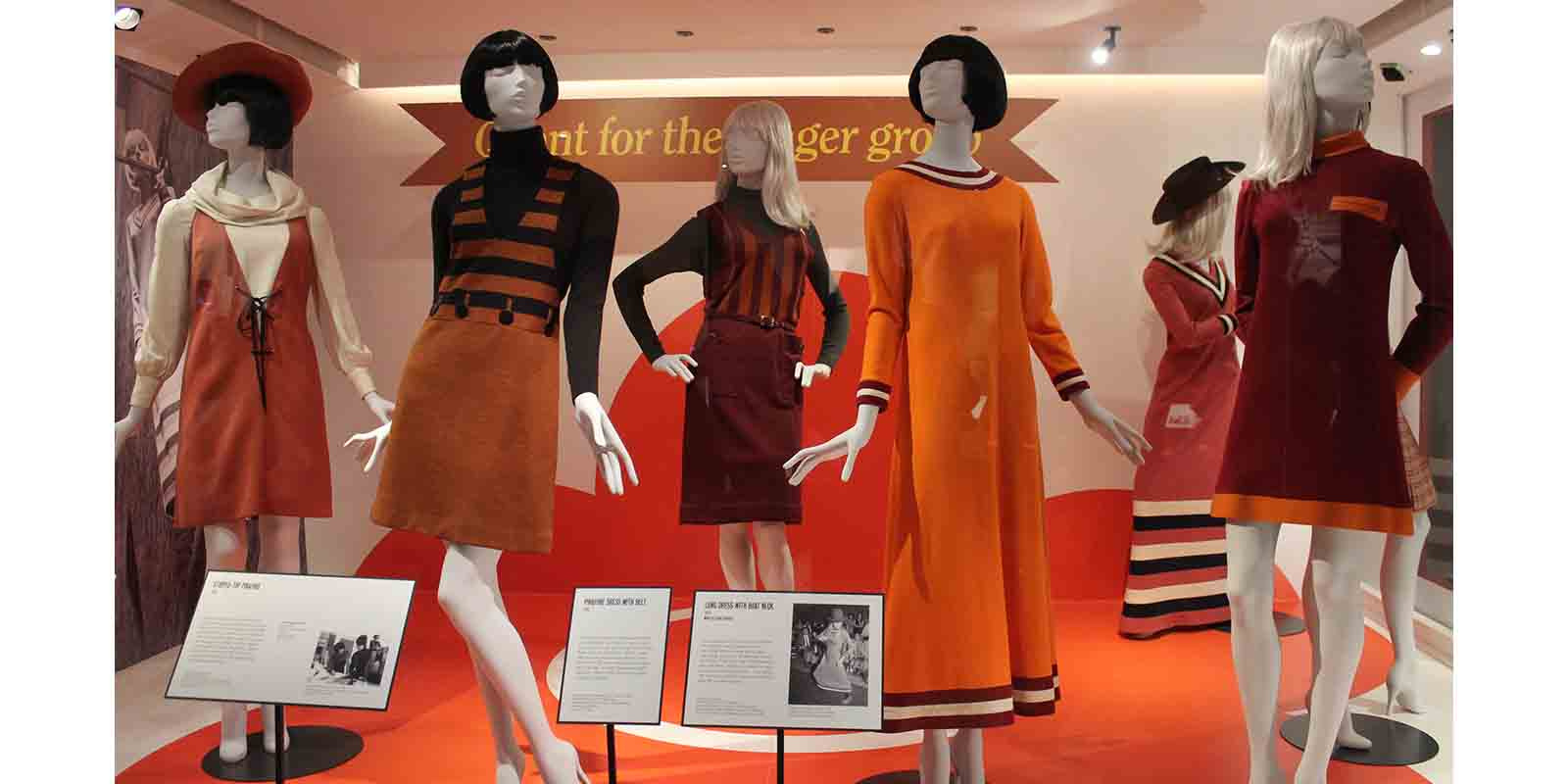
Mary Quant thought about the lives of her clients. She knew they would be very busy whether they worked in a store, office or where a Chelsea party girl. Many where at least two of these things but the ripple outwards of the ‘London Look’ the new easy mode of dressing with confidence in new styles that where easy to slip on and out of as part of a busy life where crucial. Quant wasn’t just a saleswoman or designer, she was on a mission to really help women and give them something that would make their lives easier. A Cream blouse with a cowl neckline sits under a dress formed of one piece of fabric falling off the shoulder looking like a partly sewn leather seam. The carefree nonchalance of the complete typifies the bravado of London in the 1960’s.
Stripes pop up in several places and are an easy statement of confidence to place at the heart of a collection. Whether forming a dress bodice that creates a contrast to the lower skirt or bordering the hemline and neckline the eye is drawn by the colour contouring and it speaks to the confidence of the wearer and a sense of energy and fun. Toward the back of this frame above an ankle length dress with a bold border reaching from below the knee to the floor recalls the sharp V neckline drop and circular cuff border. There’s an echo of 20th century school and sports club uniforms for both boys and girls. Furthest to the right a dress that really is a Jersey dress in the most literal sense is composed of Claret with Orange banding around the hemline and neckline and sporty/formal delineation of the breast pocket. After decades of careful curation of colour tones and demure looks, these pieces where bold and strong and represented quite a break with the past. A new generation was very visually breaking through.
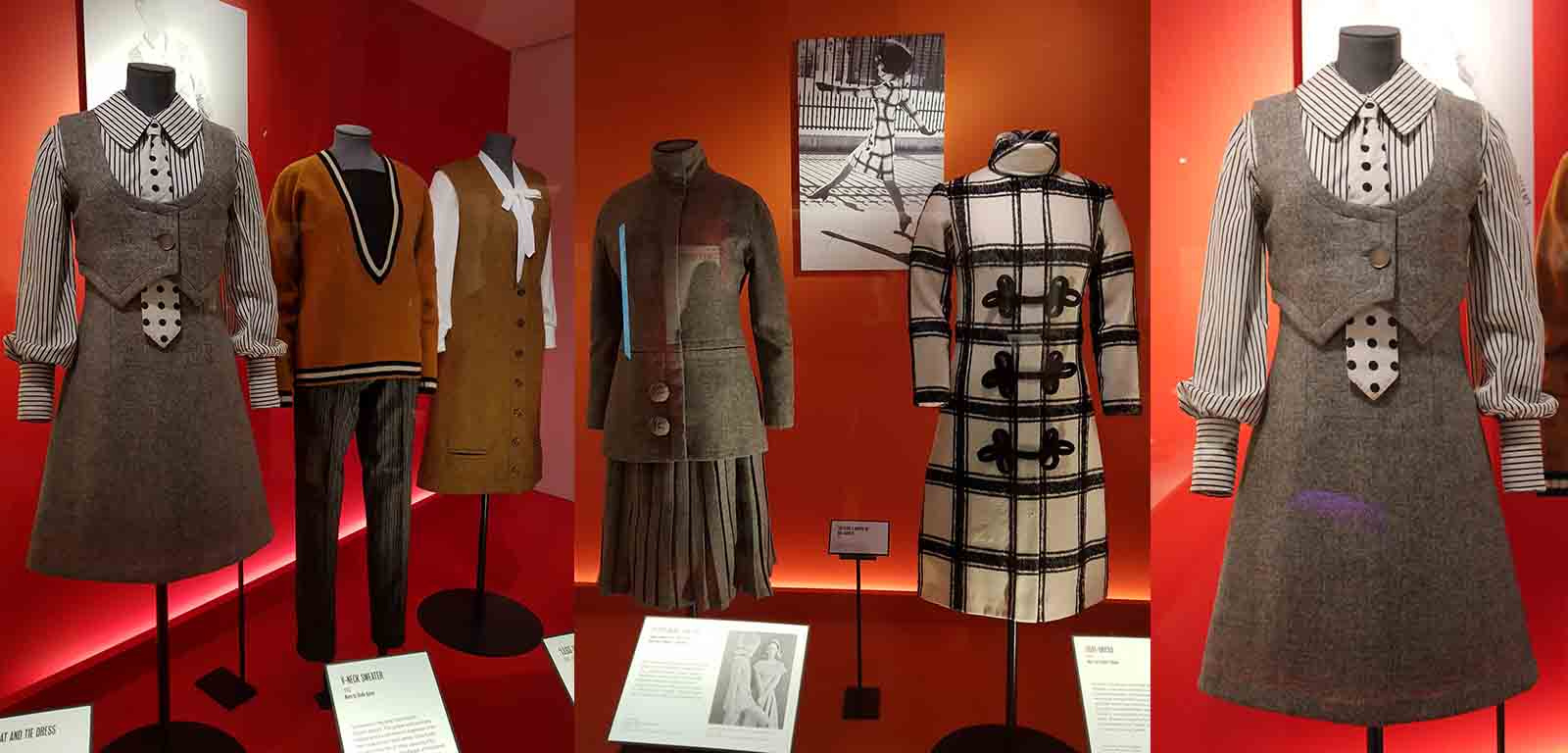
Quant was very strong at creating looks appropriate for formal settings and adapting the nuance of formal-wear to more casual looks that reference and slightly poke fun at the traditions and fixed structures of the establishment of the post-war era. Mary Quant’s woman wanted to work in a bank as well as enjoying the swirling party scene of the 1960's and why shouldn't she? A Grey dress composed of skirt and buttoned waistcoat bodice is woven in wool as a handy winter warmer for offices in pre-aircon days. The finely tailored pinstripe shirt underneath and clashing large polkadot tie take a humorous swipe at the narrow conventions of the mid century City of London style. Reaching further into the men's wardrobe, a deep V neckline sweater with varsity stripe borders transforms the traditional men's sports top. Combined with pin-stripe trousers this is an easy casual look for wizzing around town or relaxed days in the country. Further to the back of this picture a Mustard sleeveless dress with pussy bow tie White blouse underneath forms a slightly more classic elegant look for work and leisure. Compared to the contemporary thin fabrics often found in high street work-wear lines, the thick material would keep the wearer warmer.
That winter staple, the woollen coat got an imaginative re-working in the hands of Quant with two large buttons dropped below the waist and a circular collar taken from the men's shirt. Combined with a below the knee pleated skirt in the same fabric that strikes a conventional tone to bring the outfit back to the line of classic sensibility, you can see that Quant is shifting perceptions and making gradual change in consumers minds rather than creating a radical aesthetic that may be rejected or a 'flash in the pan' moment. To the right another of my favourite pieces from the collection, a White coat with broad lined check square and military insignia styled buttons and rounded collar. The photograph behind depicting a woman marching in this uniformed style would have shown the viewer the contrast between what women where capable of and what they where allowed to do in the 1960's.
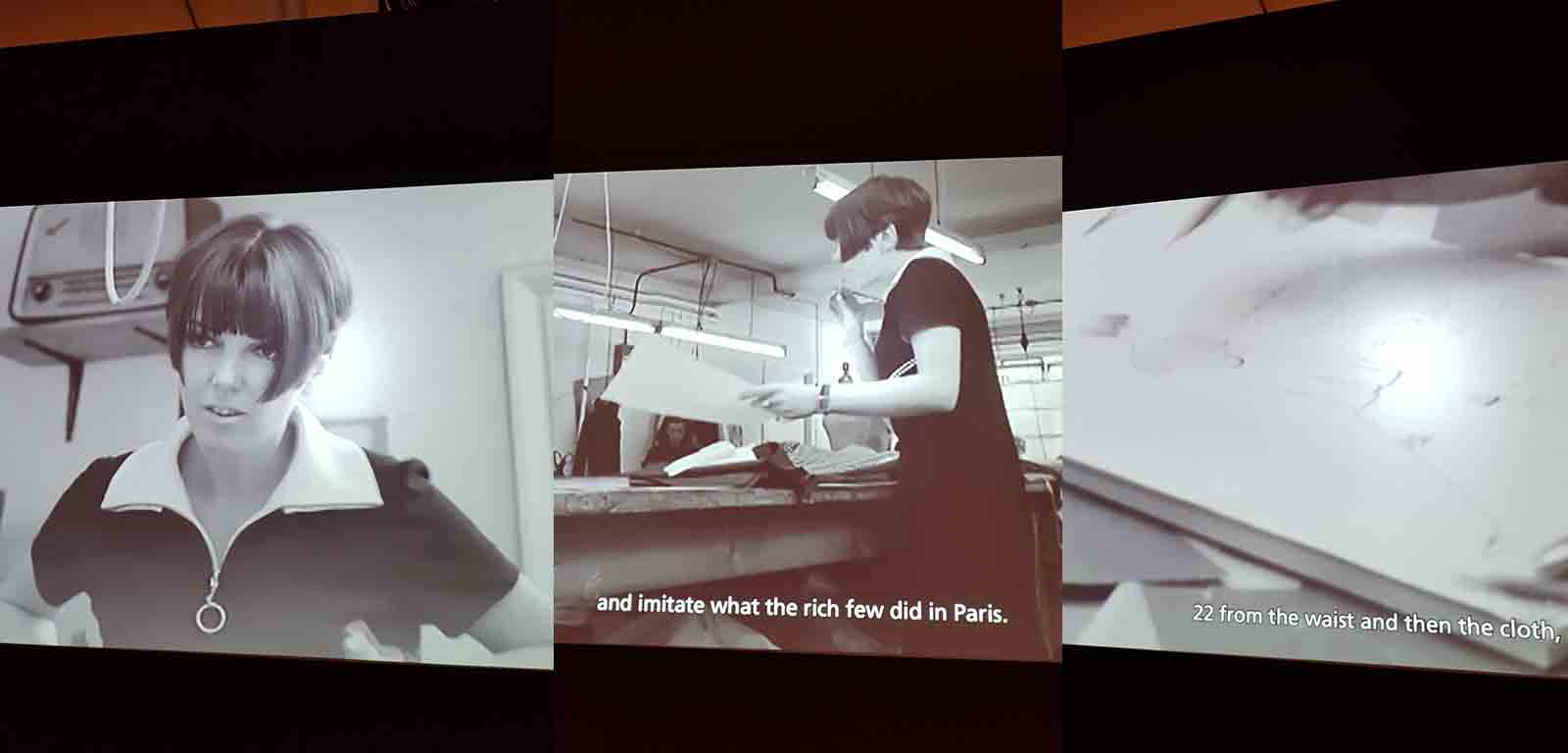
With her signature Vidal Sassoon bob cut by the man himself she set the tone for an overall look for a generation of women, many of them independent, working women beyond even fashion itself. People could see a design firm, a business being run by a woman from Wales, a daughter of two teachers, who believed that nothing was impossible if you worked hard enough and passionately believed that she could make change for women. She was someone who followed her ambition and creating work and freedom for others as well as becoming a household name across the world.

Strength can be illustrated through many mediums and one of the most potent that Quant always understood is colour. To the left above, the dropped waist style of the 1920's flapper dress, complete with simple tie echos the school uniforms and tennis dresses of the early 20th century. Quant is channelling the era that saw the most radical breakthrough in fashion away from the corset to clothes structured to give women back the natural freedom of movement that their bodies would explore. A Scarlet dress with a small fitted bodice cut gently close to the figure and reaching the ankle is a beautiful evening-wear piece that would be snapped up by many clients, stylists and buyers today as a vintage or vintage inspired look. Centre above a Black dress references the restrained lines of corsets in dresses of the Victorian and Edwardian era's with a sculpted finely pleated bodice descending to a skirt with thin pin-tucks around the dipped waist to create volume. The clown costume is evoked in a cheerful look with a tired ruff broad collar and circular rosette buttons down the centre. To the right a dress in bold striped print fabric could be worn in the day or on summer evenings. It's side-tie sash puled into a bow echos the relaxed style of dressing gowns that where also worn in the day at home during the 18th and 19th centuries. Light and versatile it speaks to the ease of dressing that Quant cherishes.
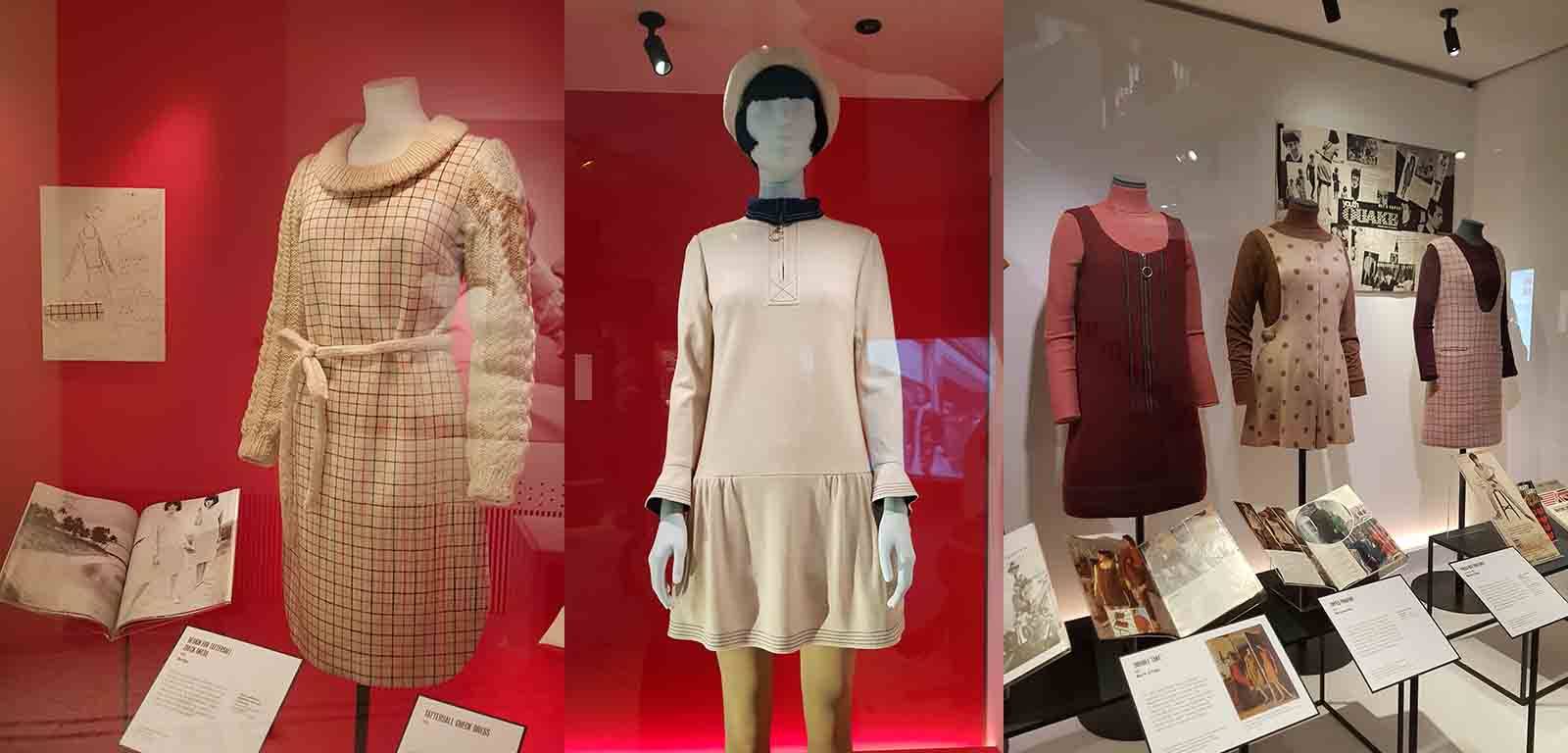
A bespoke plain check in Black, Red and Grey features sleeves of thick cable-knit wool, found in classic sweaters and a rounded collar and belt chord. It's a bold style hinting at the challenge to convention but at the same time something practical and warm that could be worn in country houses from September through to April. Behind a sketch of the dress and a sample of the cloth to be used. Seeing it draws you close to the design process and it's what I've believed for many years, that people want to see. Centre above a Jersey dress with high collar and matching beret is a classic 1960's look and one that my Mum certainly remembers seeing around on the age group above her when she was growing up. With it's sporty zip at the neckline and folded round collar, the slightly fluted cuffs and skirt hem also give a distinctly naval appearance. To the right above a range of three mini dresses typify the mini skirted dress look. Note how they have a sensible long sleeved top underneath them? They could be styled with or without tights according to the weather but Quant was keen to observe many of her clients went to large cold country houses at the weekend, or even generally lived in them and in these two layers, worn over under garments the wearer could lock in warmth as well as following the new trends. It should be noted as referenced by Tristan Hunt, the Head of the V&A, that Quant didn't invent the mini skirt, no one knows for sure who did, as it was an emerging trend that literally began to appear on the capital's streets and hemlines gradually rose and rose.
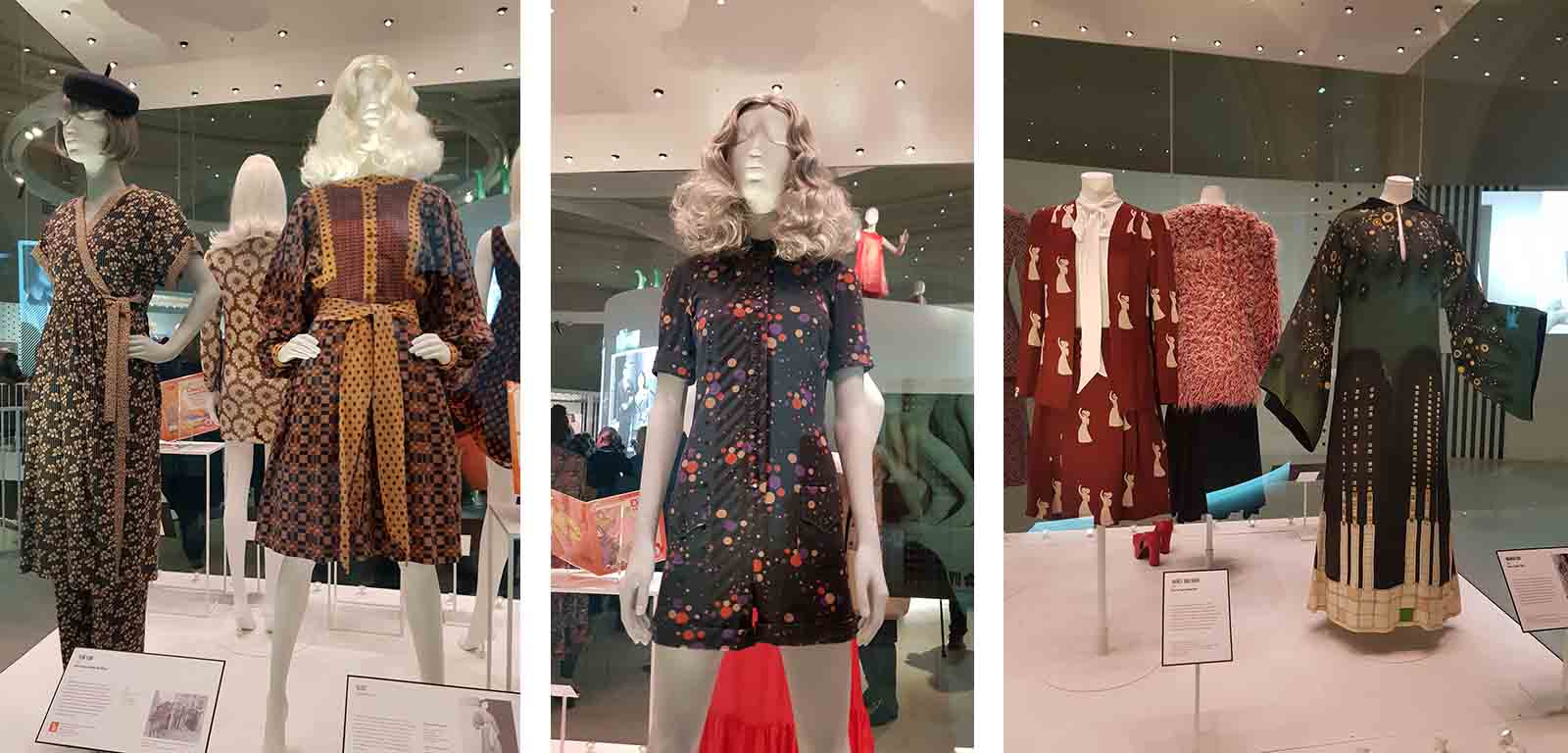
As the 1960's moved on new styles began to emerge with complex prints and more muted earth tones taking a leading role in collections. This came partly from the psychedelic culture, sadly inspired by drug use and also by a re-invigorated interest in the natural world and it's environments properties not know since the Victorian era and boom in the leisured wealthy's interest in the natural environment. The love of plants and nature and contemplation of it was not confined to the rich and romantic or rural workers though now, it spread all across society and was part of a new collective conscience. Simple wrap around dresses taking their cue, as I mentioned earlier from the old dressing gown of previous centuries and 'play suits' using the lines of Edwardian Swimwear and one-piece knickerbocker suits are simple styling classics that mean you can concentrate on work and play. The play-suit above with it's colourful cluster bubble print is another piece that to my eyes is one that many people would like to wear today. To the right a skirt suit and full length dress show the taste for experiment and exploration that the label encapsulates. A Burgundy suit with a cream coloured silhouette of a Victorian woman set against the base colour poses a graphic illustration of the difference between the constraints of the past and freedom through modern cloths that Mary Quant wanted to give. It must be the most starkly illustrative piece in the whole collection. A Black dress with wide cut kimono style sleeves translates the style of Morocco into the woman's wardrobe. Melding both geometric and floral patterns across it's length, it is a bold style that captures a spirit of adventure.
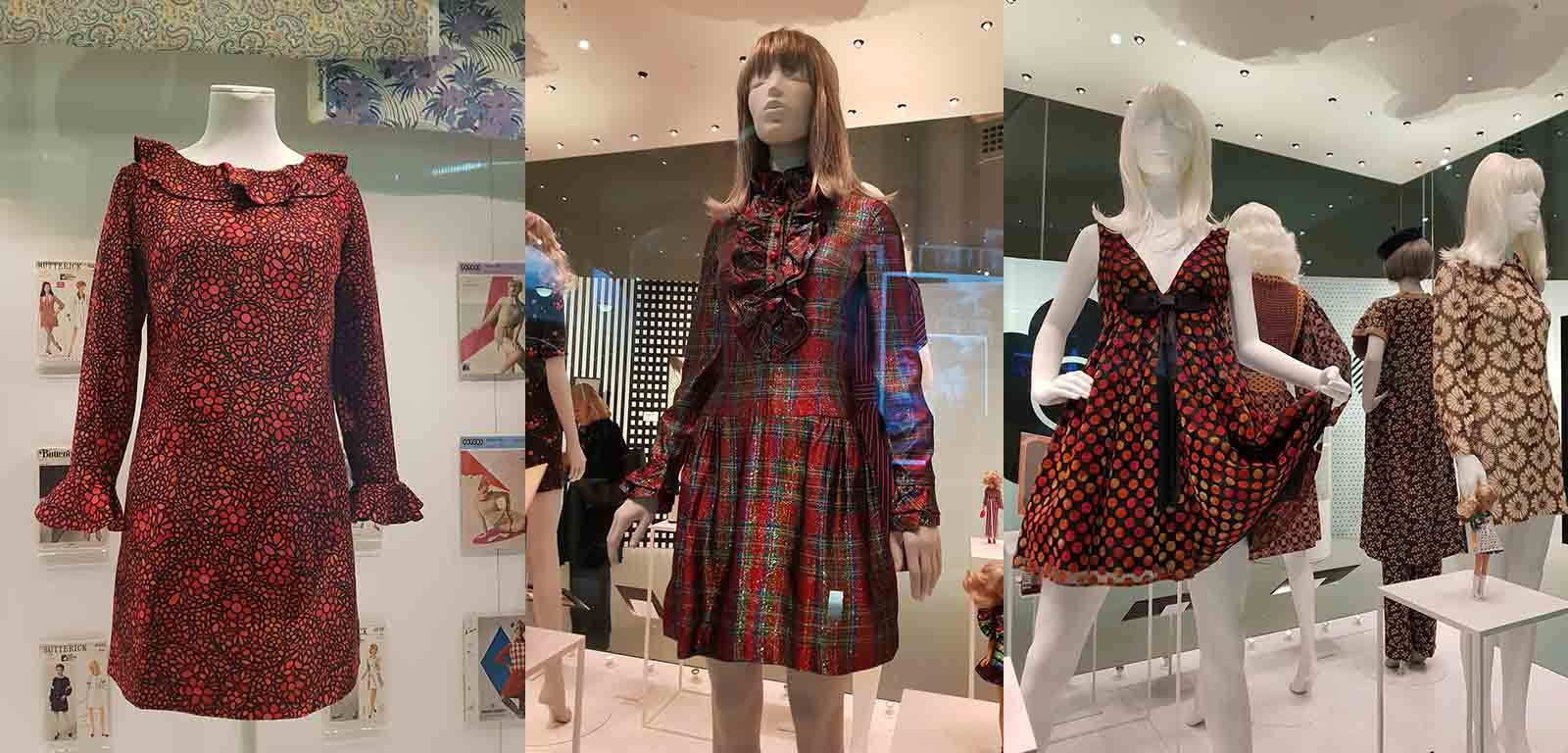
A bold patterned dress above to the left hints at the new direction taken by contemporary art and little flourishes of ruffles around the collar and cuffs prevent the look from becoming more minimalist. One thing that Mary Quant achieved was to pare down style without loosing feminine details and she and her team did this to perfection over many years. This essence of a distilled modern femininity is what has dominated women's fashion in the last six decades since she opened her business and brought her concept forth to the world. Centre above a celebration of a Scottish highland dream with a taffeta dress featuring detail from the men's tuxedo before descending to a mini skirt. The perfect part dress for Christmas or any time, the fabric is woven with an iridescent thread running through it to reflect any light that may be around it and help the wearer dazzle. To the right a classic mini-dress for smart parties, 1960's style. The debutant and her submissive coy dressing was long gone and girls from wealthy families wanted to express their own personality and identity rather than that of their (male) ancestors names. A two tiered dress with round Yellow, Orange and Red circles on a sheer outer shell sits on top of a Black mini-dress. The V neckline swoops down towards a Black bow drawn under the decolette with a Black ribbon tie length descending most of the way to the above the knee hemline. Another look that would be snapped up in a store today. To the far right a mini-dress composed of daisy flower print in a tessellation form across the surface again blends geometry and floral in a clever way hinting at the complex maths behind the beauty we perceive in the world around us.
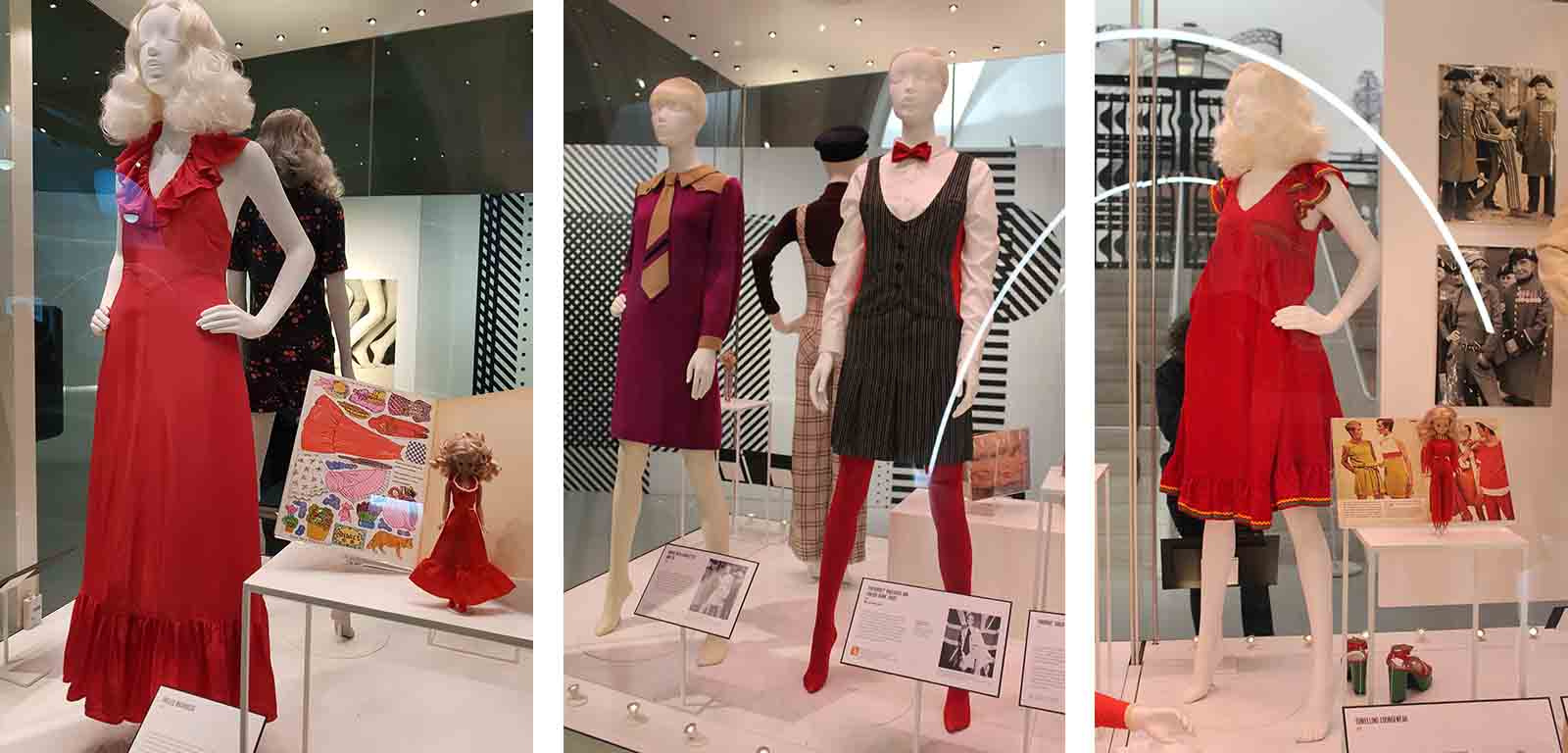
Red is one of the undeniable Power colours for women and above to the left and the right a floor length maxi dress and a power mini-dress have subtle impact. The floor length dress is a perfect look for high Summer Black ties, if bare shoulders permitted, and the high hemline with peplum ruched detail is something that you see in dresses that have been worn in the recent summers. This look is so popular even Barbie is copying the Mary Quant woman and wearing a mini version next to the model. To the right a more casual look opens doors to a playful summer of fun in the sunshine with a knee length dress bordered at the hemline and shoulder with Lilac and Gold celebrating the colours of the rainbow. Two mini-dresses centre above display the versatile nature of the look whilst both taking aim at appropriating the staid masculinity of the City in rich purple accented with a tie, collar and thin shoulder pads and a Charcoal Grey pinstripe tunic features a box pleated skirt and a Scarlet back emulating the silk of the waistcoat and jacket linings of Bankers and Brokers.
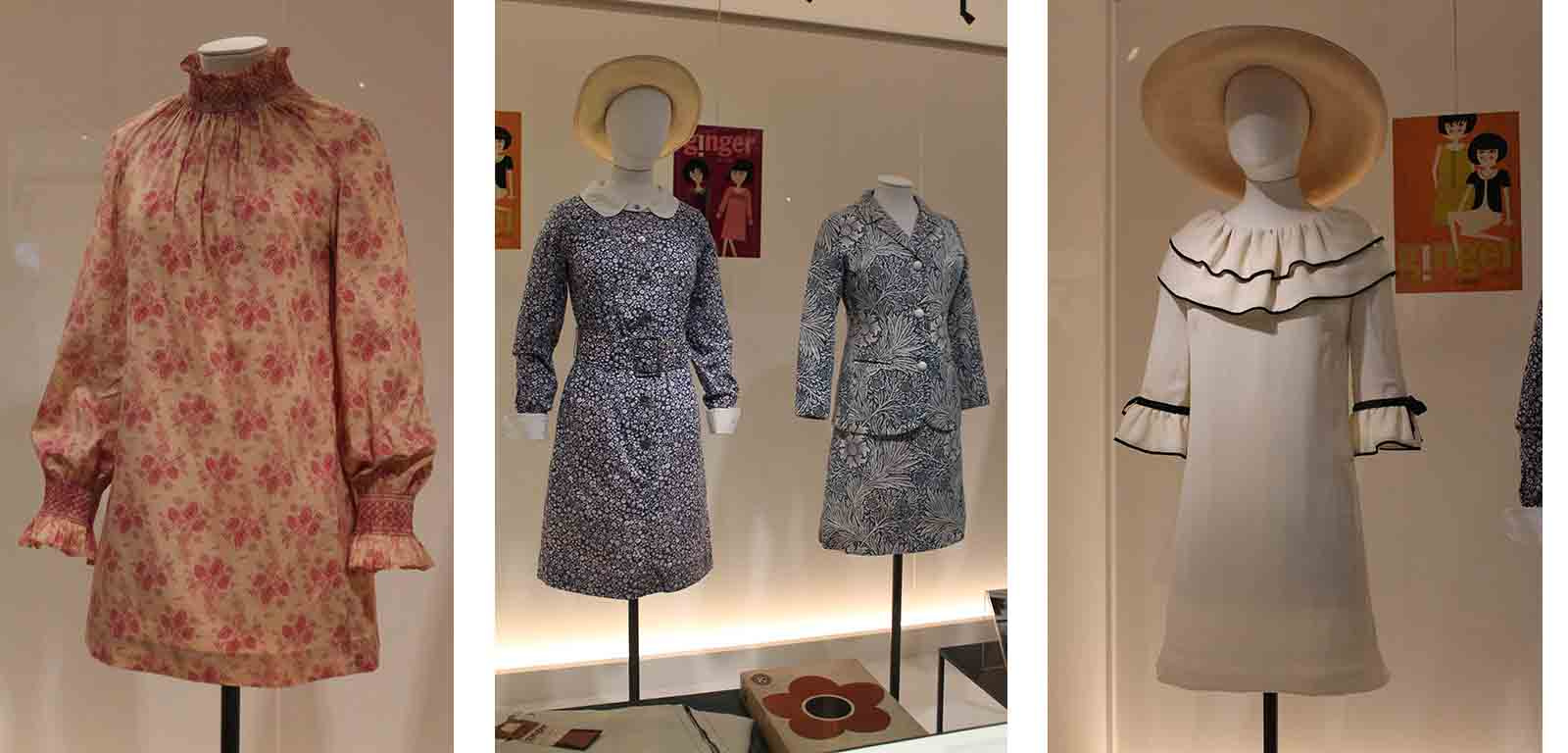
Traditional prints made their way into wardrobes en masse as the 1960's progressed into the 1970's. Nature and it's strength and beauty formed a main back bone of many style designs and clients across the generations where charmed by it's appeal. Above to the left raspberry print and a gathered elasticated smocking at the collar and cuffs gave a small contrast to the loose flowing fabric. Centre above the allure of ink-Blue and White of the willow pattern china or former generations is translated into contemporary floral designs running across fabric of a dress and skirt suit. Botanicals where stylish ans thought provoking on several levels and far from being horrifying to the parents and grandparents of the young crowd in the 1960's, I think that some of grannies who remembered the Edwardian era may very well have liked them and appreciated the designs and ideas behind them. To the right a White dress has hints of the sailor suit or possibly that of the clown. It's difficult to come down on either side, but perhaps there is no need to. Quant didn't design to be analysed, she simply created what women needed with flourishes of style for them to enjoy. These outfits made you smile inside and out.
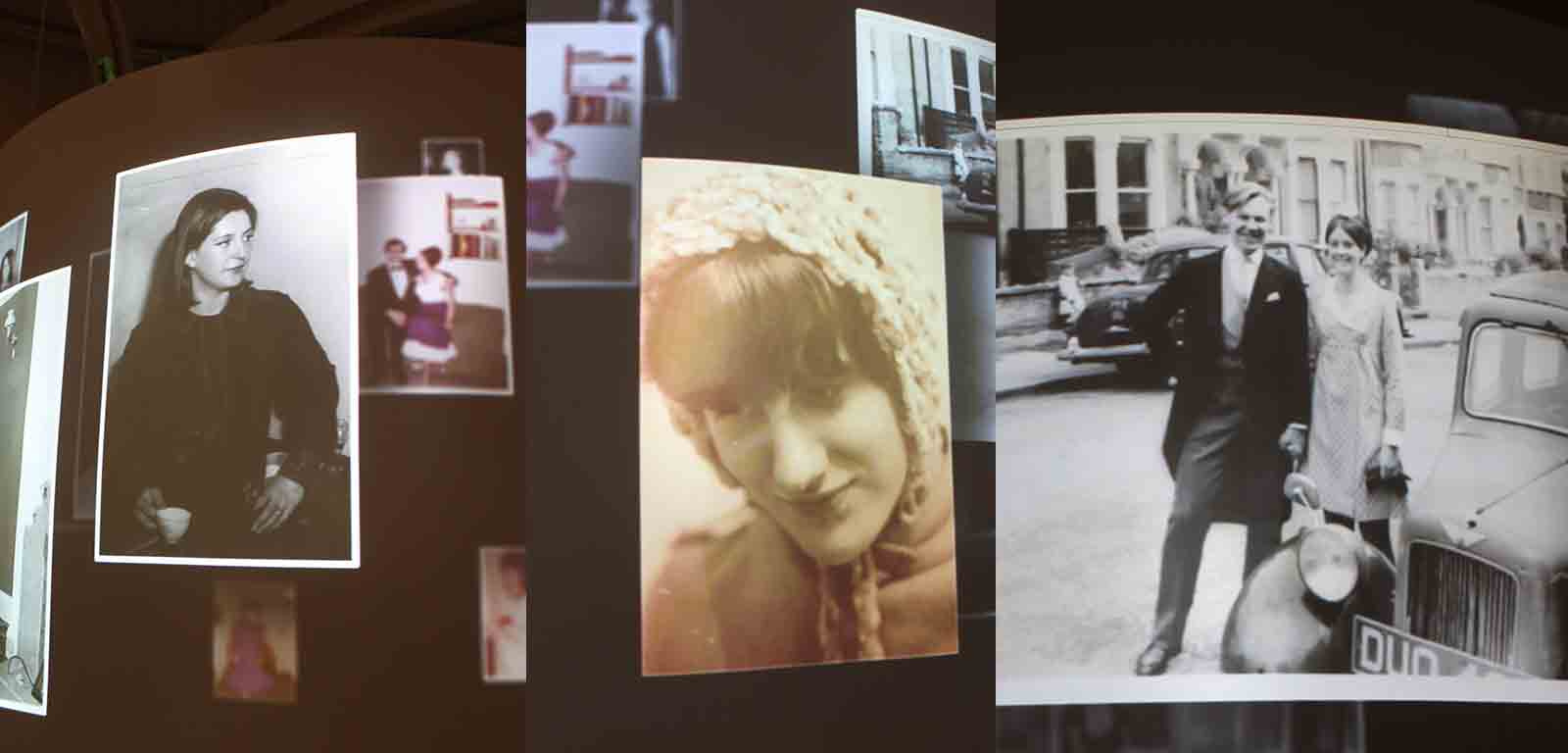
In the upper gallery a rolling reel of images of women from the UK and beyond plays on a loop. They answered the call of 'We want Quant' put out by the V&A and thousands of women sent images and offered the loan of their dresses for the exhibition. To whittle this down to the several dozen that where shown was no mean feat by the curatorial team and the gallery showing the touching moments of lives of the wearers, there are many wedding snaps amongst these, captures the significance of Mary Quant across one possibly two generations of women. It's hard now in such a global media culture to describe the power of the 'London Look'. People would arrive in London off the plane from the word's fashion capitals; Paris, Milan, Rome, New York, Tokyo, Copenhagen and know within a short time from looking at people around them that something was very different here, a popular change was taking place.
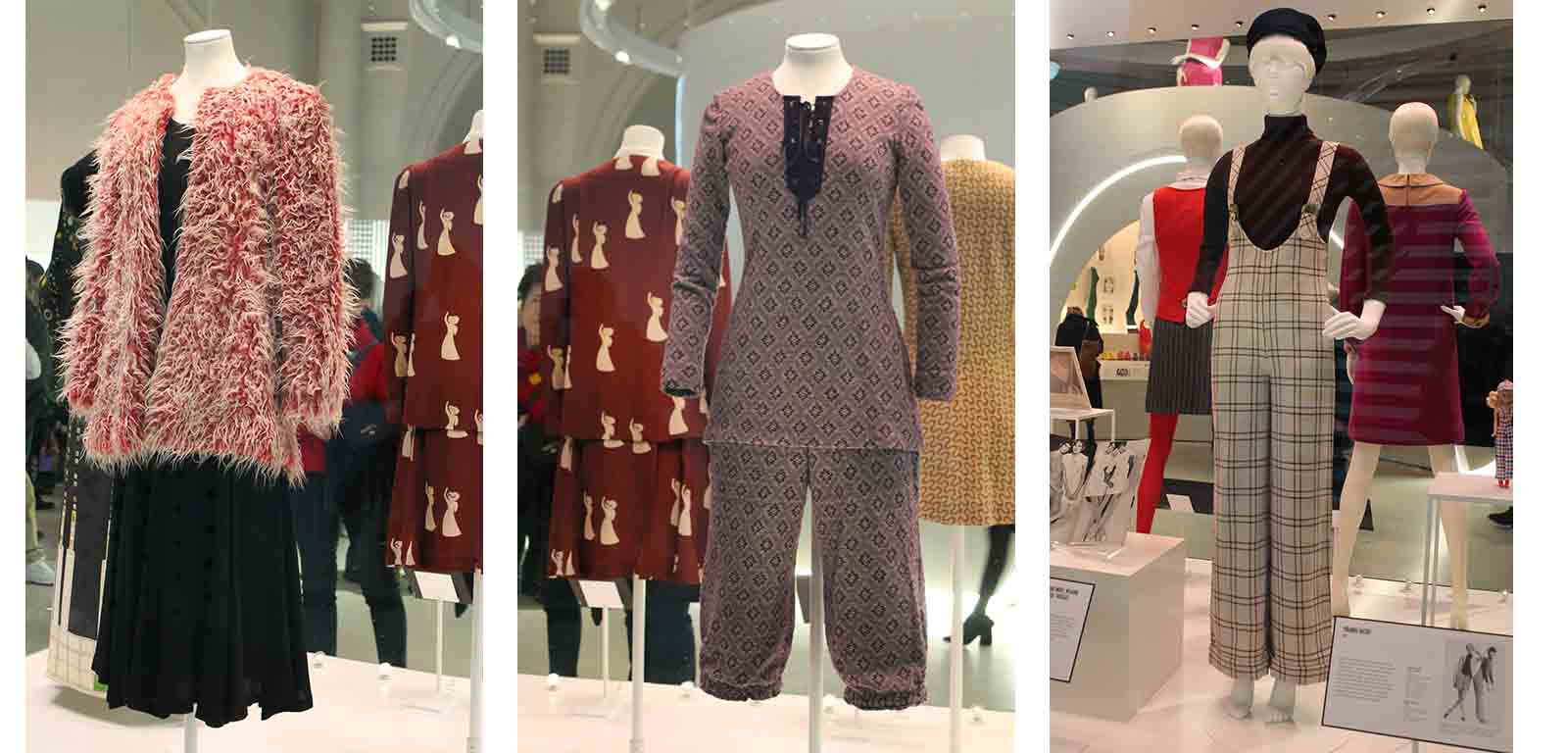
A long fibre jacket is frosted in wisps of White growing from the Red jacket surface with a long line black dress underneath reaching to the mid-calf. Flowing gently down the figure, this look captures easy elegant glamour and would be suited to evening wear or a possibly a day time formal event in Winter, however the coat feels very much like an evening piece. It sits softly on the figure and is a far cry from dresses that women had to squeeze themselves into in decades before or since. This outfit is about the woman, not a man's conception of how she should be. Centre above a play-suit could also double as a pyjama suit and the paisley print is instantly recognisable as a cosy staple from the 1970's. Dungarees where another key look from the Mary Quant era and above to the right in tartan check of Caramel - Burgundy completed with a matching polo-neck and beret the image is relaxed, stylish, practical and warm for the wearer. More clothes to enjoy, feel good about yourself in and be seen in.
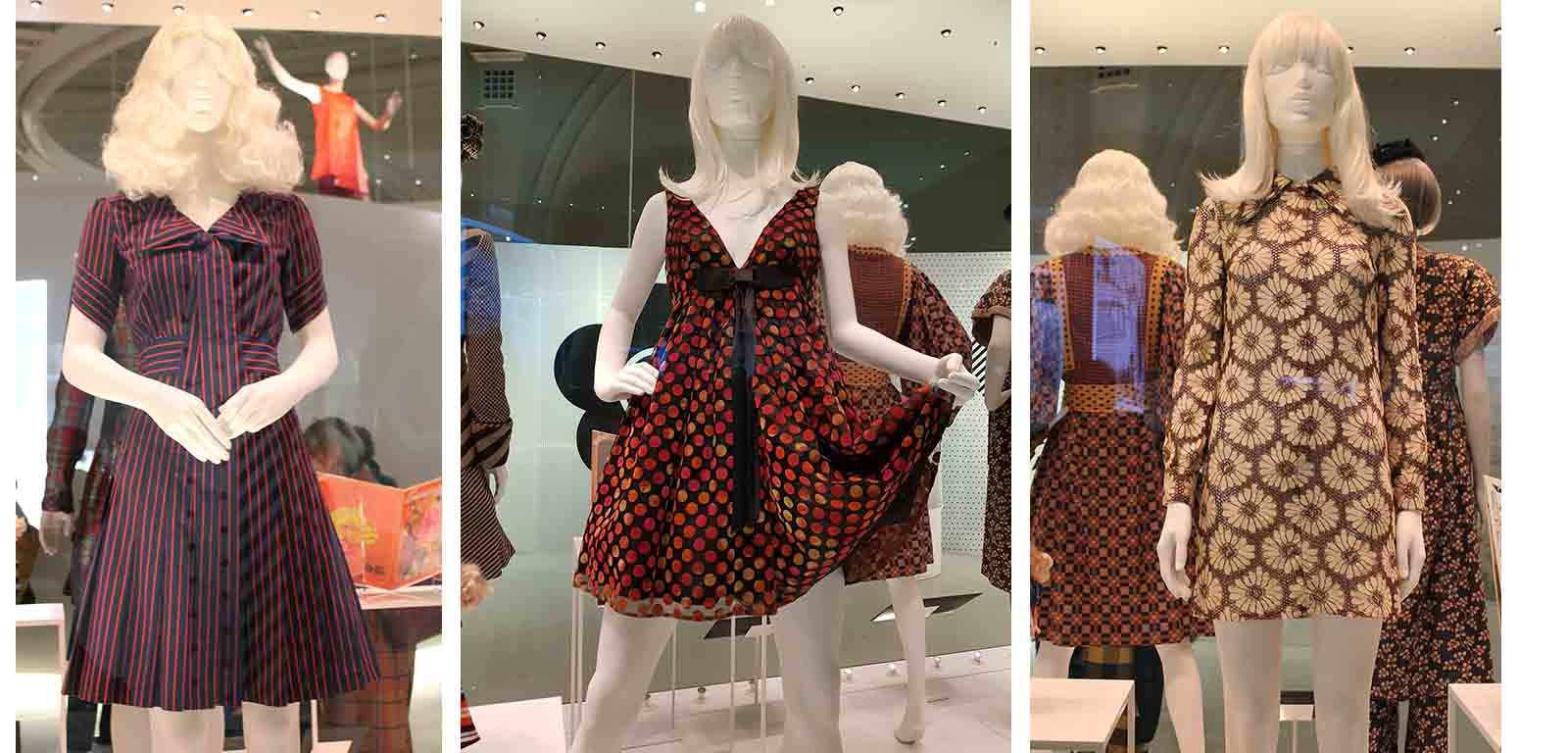
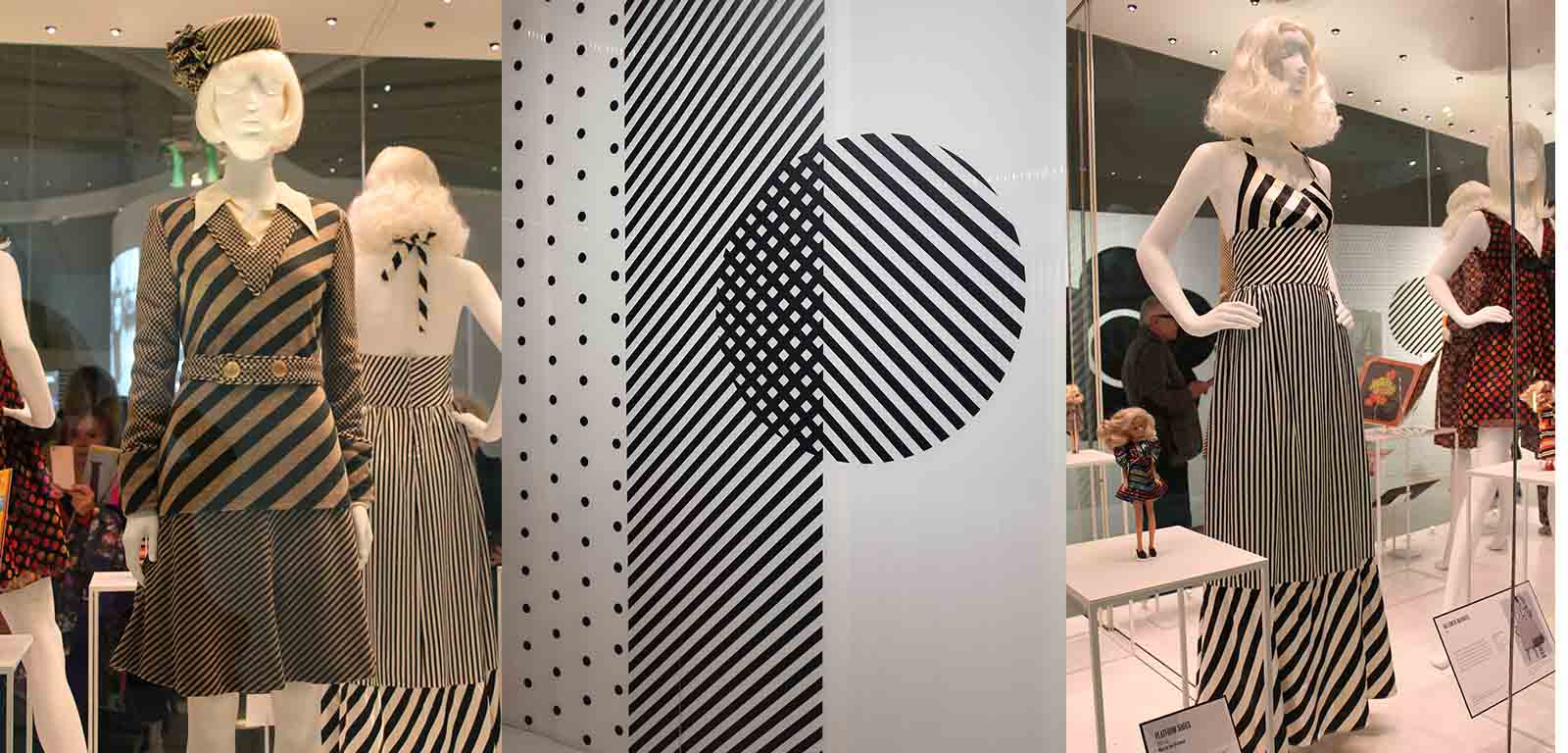
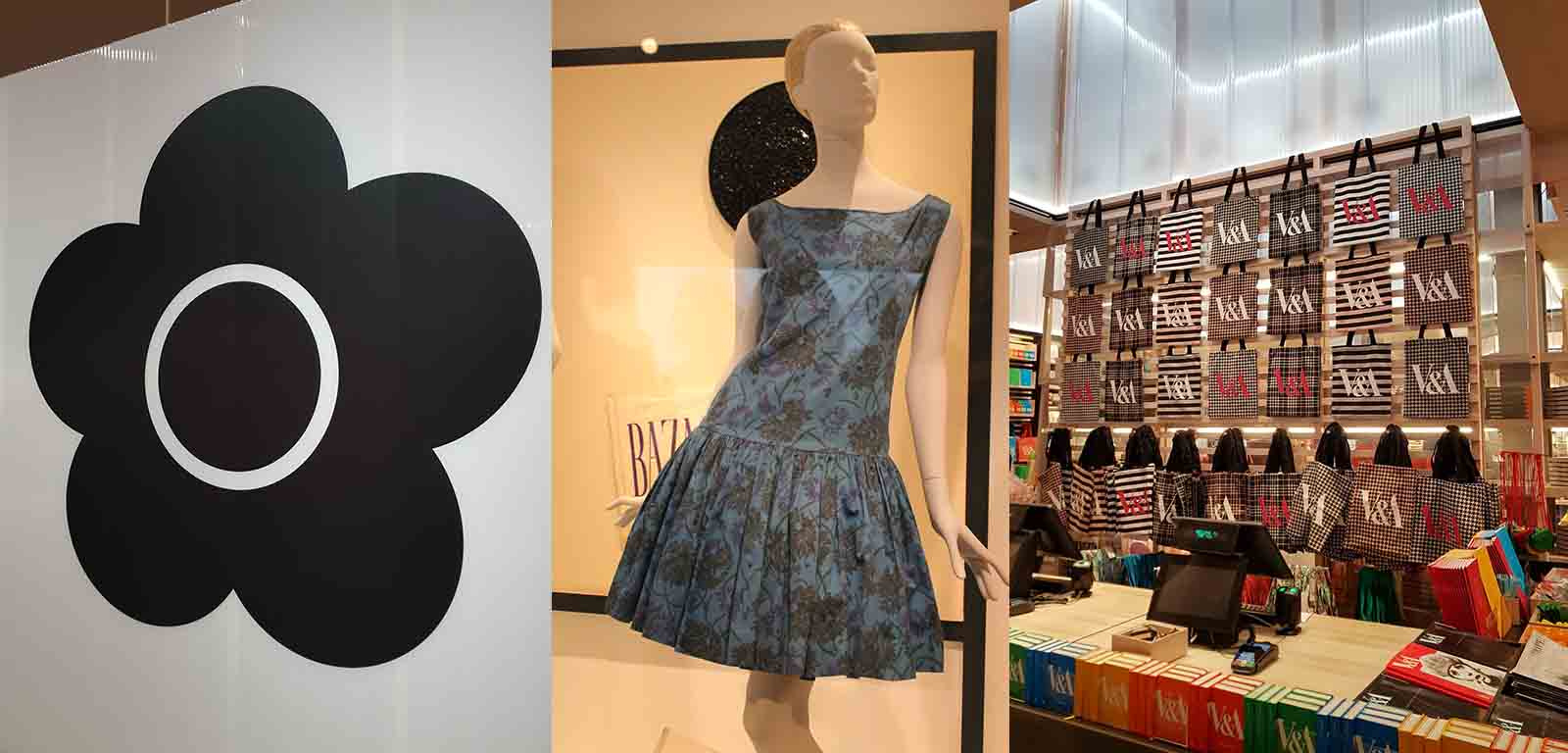
At the V&A again for the opening of the refurbished Jewellery Gallery supported by the Bollinger family.
The Victoria and Albert Museum has many strings to it's bow and amongst the array of collections, the jewellery objects that span several thousands of years of history in technology, art and craft are a feast for the thoughts and a journey through creative heritage. Upon entering the gallery a jewelled wheel of colour greets the eyes and is a draw for most people entering the gallery. The wheel of rings turns before the in an outward moving spiral that starts with a Rose-Pink heart and journeys to Blues and Marines. It also has a spiritual aspect for some and the stones for some people give a feeling of calm. So many shapes and settings that show the different ways that you can create a piece for someone special in your life.
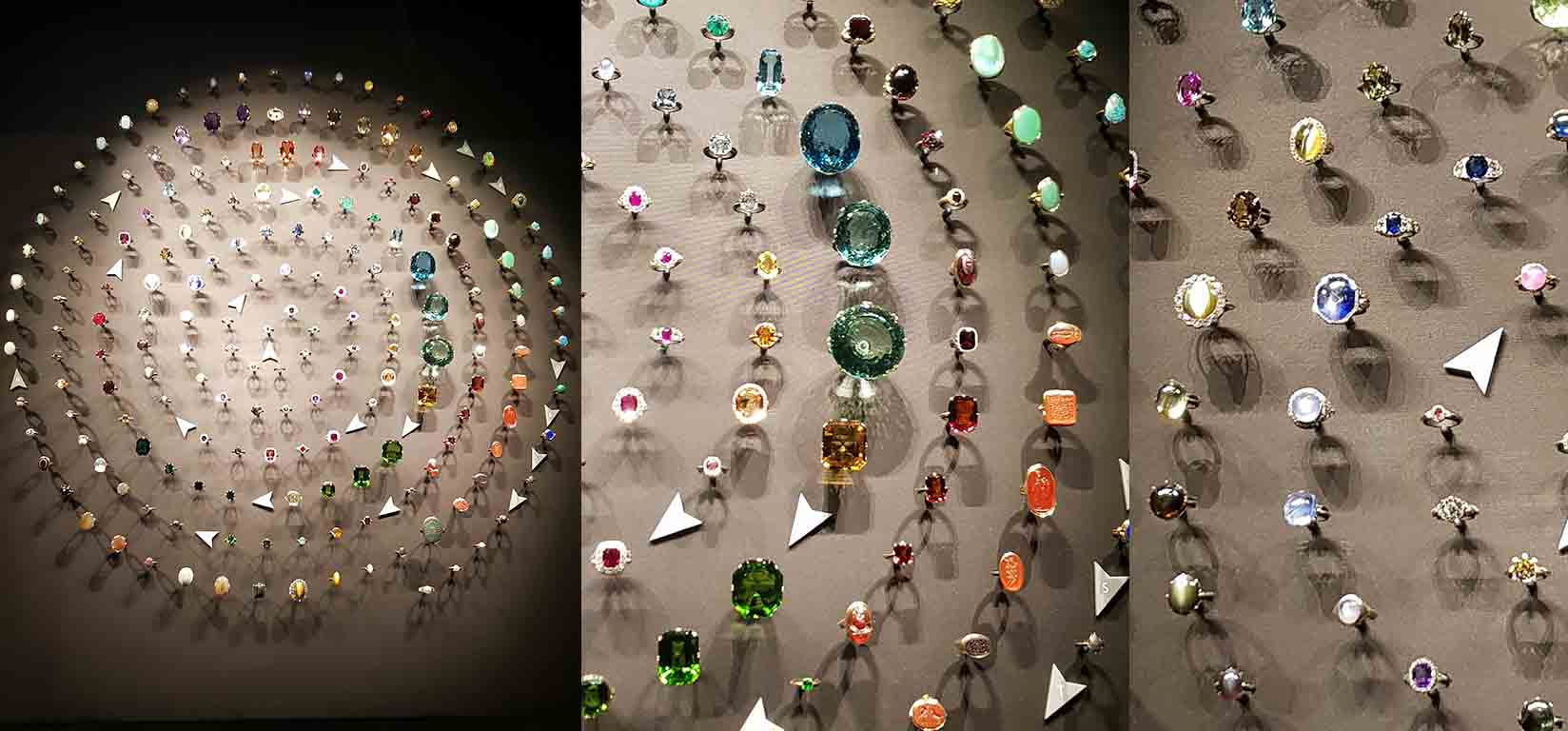
Mid-way through the gallery a central focus of the collection is the coronet that was once worn by Queen Victoria after her husband the Prince Consort designed it from her family jewellery collection. Some of the stones have a captivating Blue depth and clarity and some have wondered over the years if Sapphires of the Stuart family of Henry Benedict Stuart's collection, where used in it's construction. It's possible and perhaps a mystery that may be solved one day and this piece with it's constituent parts brought together by Prince Albert was treasured by Victoria. She wore it through her lifetime, sometimes in an innovative way encircling her chignon as in the well known painting by Winterhalter and later it was passed to her great-granddaughter Princess Mary and worn by her family until being bought for the nation and placed in the William and Judith Bollinger Gallery.
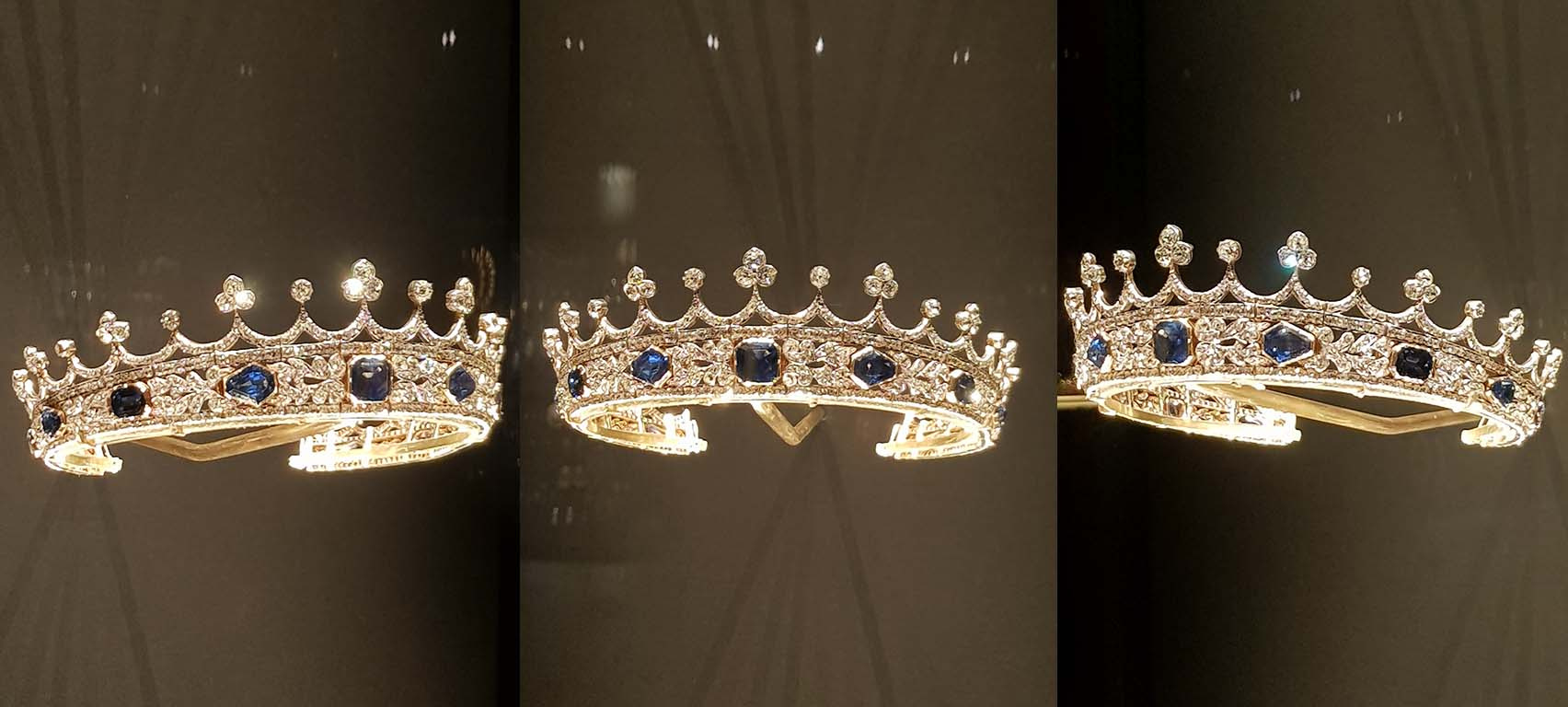
The stones seem to have a magical property, expertly cut with the White light shining from the diamonds matched to the ocean-deep Blue of the sapphires. The piece is articulated so that it can be worn closed or open in bandeau form and it's diminutive size relative to other tiara's at 4.5 inches when closed, make it appear like a jewel in itself. It's was made by Joseph Kitching of Auld and Kitching and perhaps also heralds the era of Victorian Gothic in it's fine scrolling detail. It would have been an easy piece to accessorise with Diamond and Sapphire earrings and a necklace. Worn simply in itself though, it's a beautiful object. Something about the clover leaves resting on escalloped waves above the base diadem looks like a simple classic design with enduring appeal.
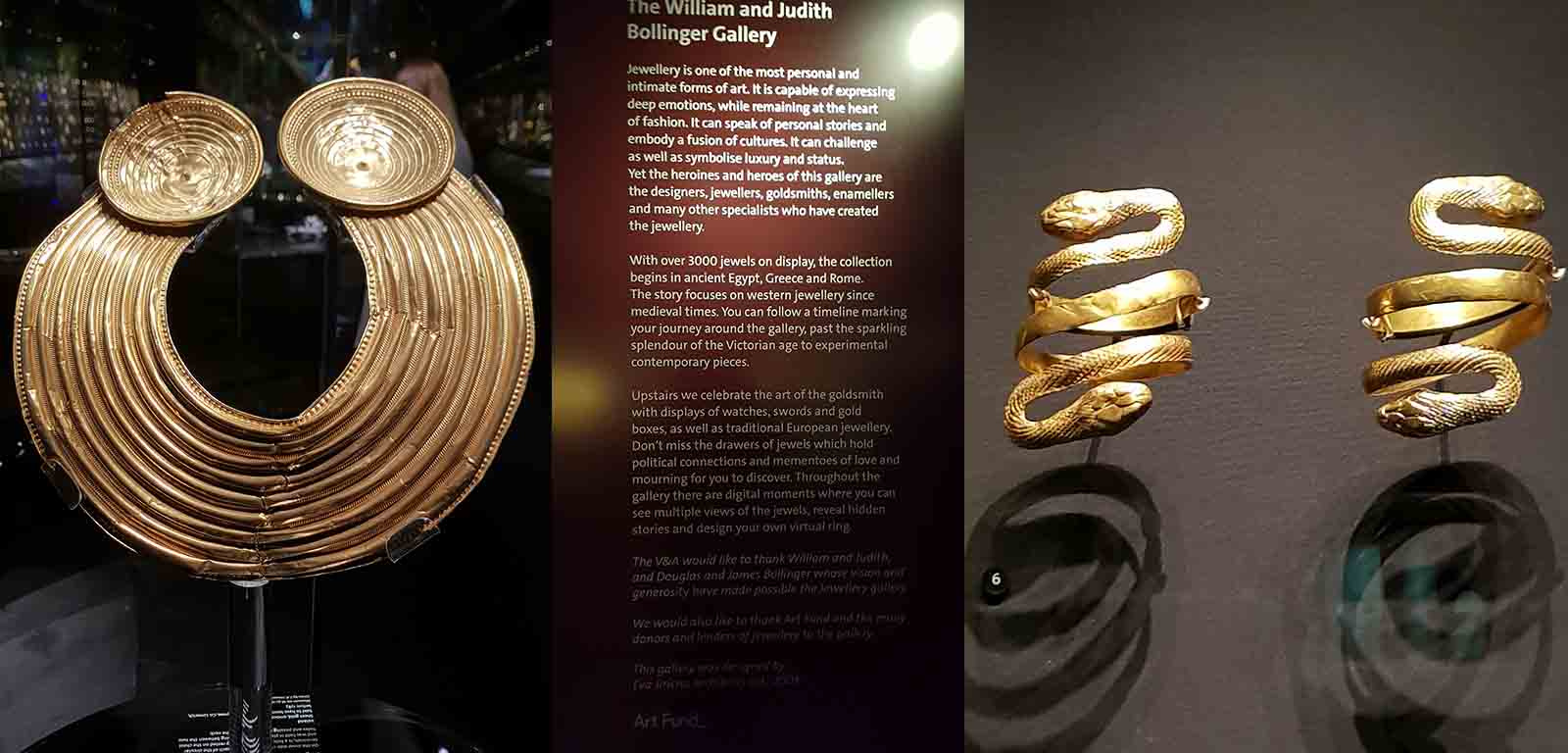
The gallery has been re-lit and the glass in the casing has been chosen to be minimally reflective so that the viewer sees mostly the objects and not a reflection of themselves. It's a subtle but important feature that enables you to see and remember the pieces. To the left the Shannongrove Gorget is a collar produced between 800-700 BC that illustrates how and why Ireland was one of the most revered centres for the production on Golden Jewellery in the world in the Bronze Age. This example was found in a bog in Ireland and at least 10 similar pieces are known to exist. (Some Irish Bronze Age Golden objects have been found in Cornwall as the tip of the peninsular offered an already ancient major trade route to the shipping lanes to the Mediterranean.) The circles look beautiful and elegant and the chased detail through the piece draws the eye to a sense of decorum in the horse-shoe shape. To the right a pair of Golden bracelets shaped with snakes at either end show a popular feature of ancient art spanning the Celtic to Egyptian and Greco-Roman. The snake wasn't seen as bad necessarily, it was often a symbol of knowledge and wisdom passed down.
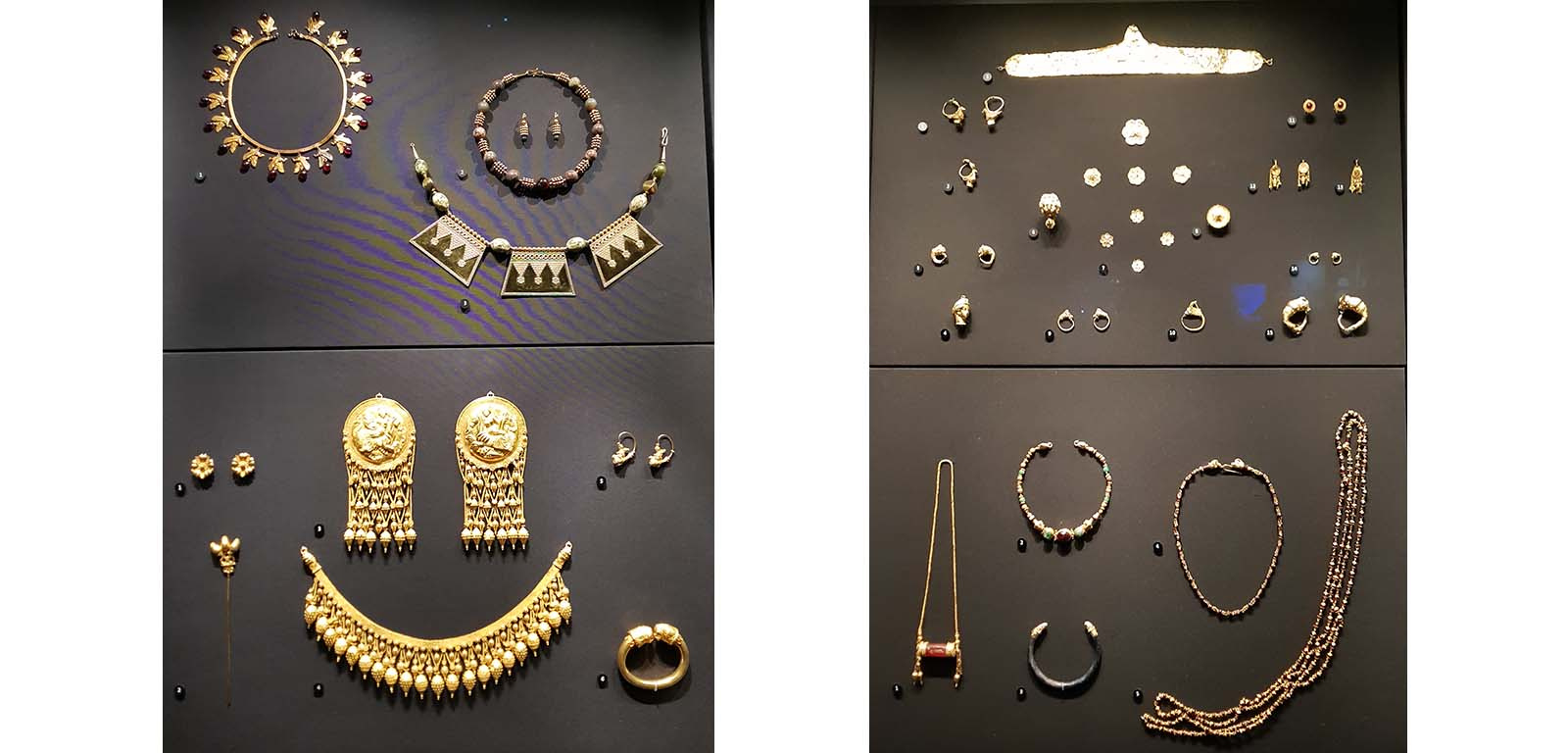
The form and style of jewellery of Royalty of the ancient world was replicated in the Regency era before and after Queen Victoria's birth due in part to the discoveries of archaeology ironically driven by the armies of scholars that followed Napoleon's campaigns on the back of the 18th century grand tour travellers. Many discoveries unearthed in Italy, Greece, Anatolia and Egypt gave the world an insight into the vast cultural heritage and know-how that lay beneath sand and soil waiting to be discovered. The Bronze Age looms large with cleverly hinged necklaces featuring intricate metalwork and unique design. Here their descendants fashioned in the early 19th century are pieces that many people would like to wear today. I think many visitors to the gallery, which is freely open to all could imagine wearing these ancient pieces or be transported back to the time when they were first created.
The trapeze shaped plates in the necklace above are timeless statement jewellery pieces and to the left the gently carved grape-like stones that drop from Golden Cranes that appear in Egyptian art. These items where above left crafted in Italy took their cue from what was coming out of the ground. Lower in the frame, the cameo style of the earrings typifies one of the most popular Greek and Roman revival aesthetics that continued into the 20th century. It's matching necklace is also strung with beads of increasing size and look like it could have been uncovered excavating the layers of Troy. Aristocrats such as Michaelangelo Caetani commissioned jeweller Castellani and with his sons they crafted pieces over decades across the 19th century.
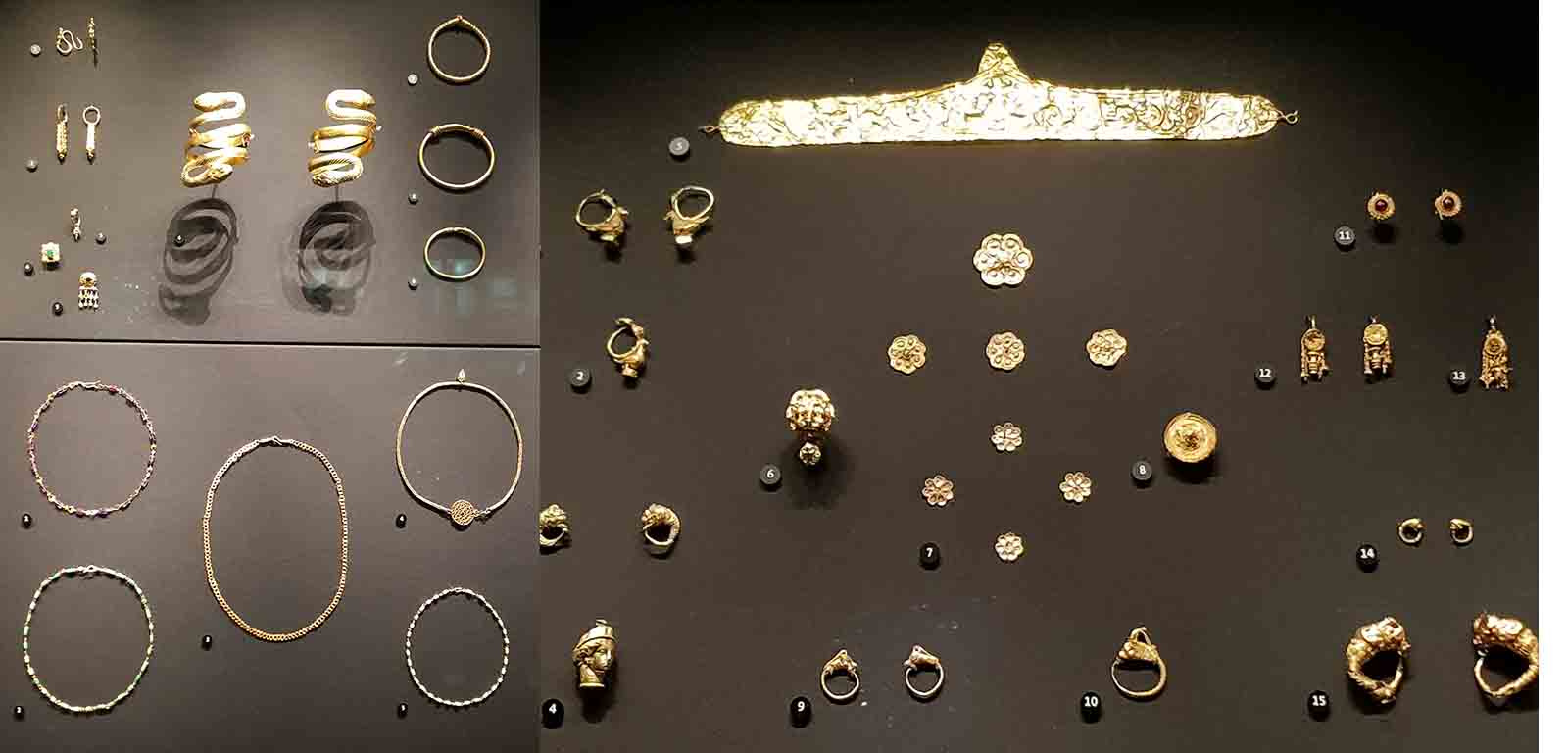
In the era of the Roman Republic between 509 - 27 BC ostentatious displays of wealth where frowned upon by the authorities and the amount of Gold that could be worn by a woman was limited by legal statute. During this era jewellery took a lot of stylistic inspiration from Greek and Etruscan jewellery traditions and the affluent new rich eager to show their wealth ignored government guidelines. A distinct Roman style developed in the centuries following the establishment of the Roman Empire as a stronger sense of national identity politically and culturally overtook the notion of the Romans being descendants of other earlier great civilisations. Jewels favoured where ones that could be found within the Empire and strongly coloured classics such as Emeralds, Sapphires and Amethysts. Symbols of devotion and affection personalised the pieces such as rings and earrings.
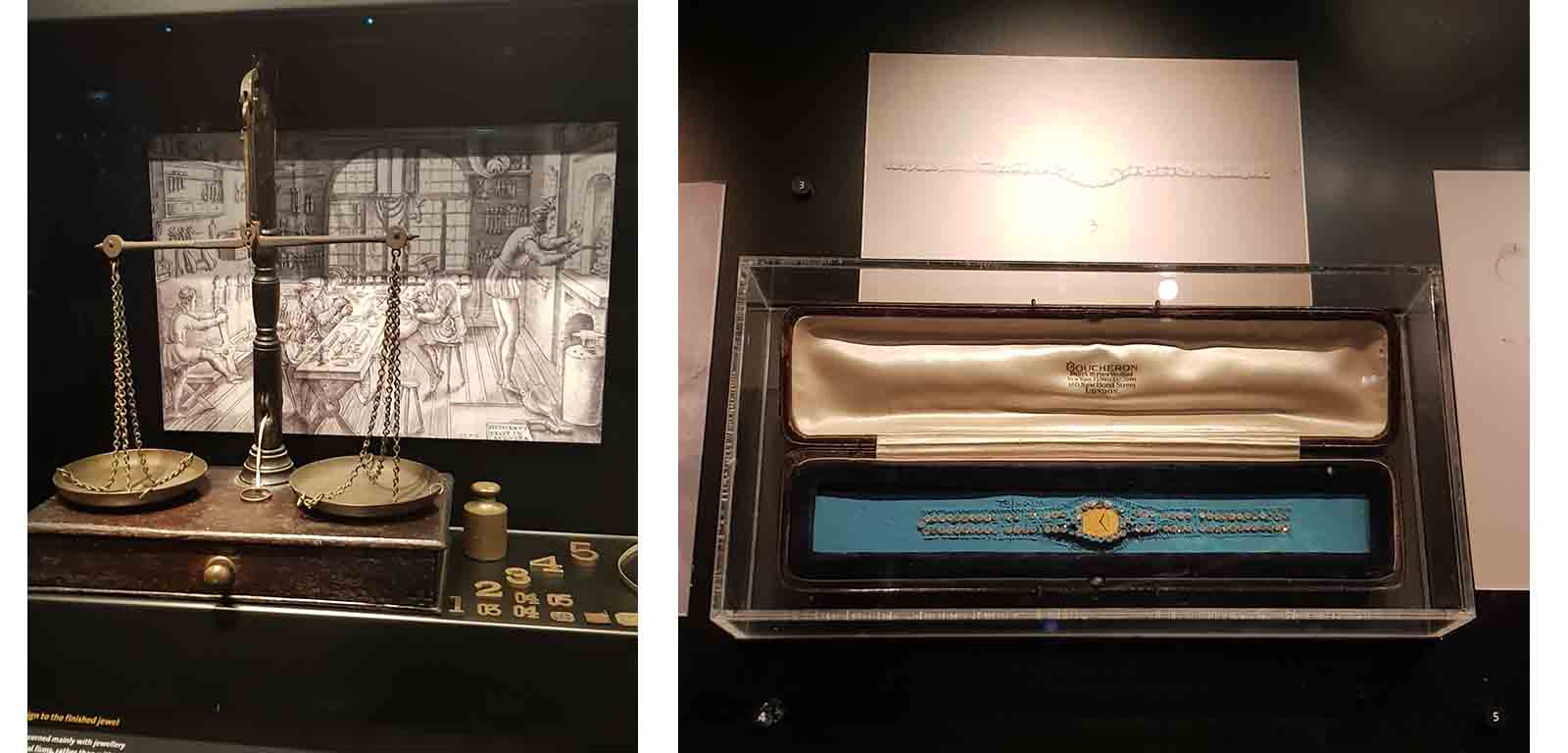
Behind the scenes craft is justly paid a tribute in this exhibition with the weights and measures scales heralding the ancient tool of measuring that brings the world into order and helped cement our present financial trade system. I liked to stare at the printed illustration behind it and think about the hours through which people worked to create these objects as part of their livelihood. To the right a watch set with diamonds made by French House of Boucheron. It's simple design of diamonds circling a Gold panel is a universal statement that could be happily worn by clients today and long into the future. Ii hope that if it has 'siblings' out there, they are being lovingly cared for by families.
The art created with a piece of jewellery extends beyond the item of jewellery itself. Below an engraving plate shows the hard work and preparation that goes into the creation of the illustrations before the execution of the decorative piece or parure even begins. To the right below a gouache of a necklace illustrates why, for some people, these items are also worthy pieces of art to be collected in their own right.
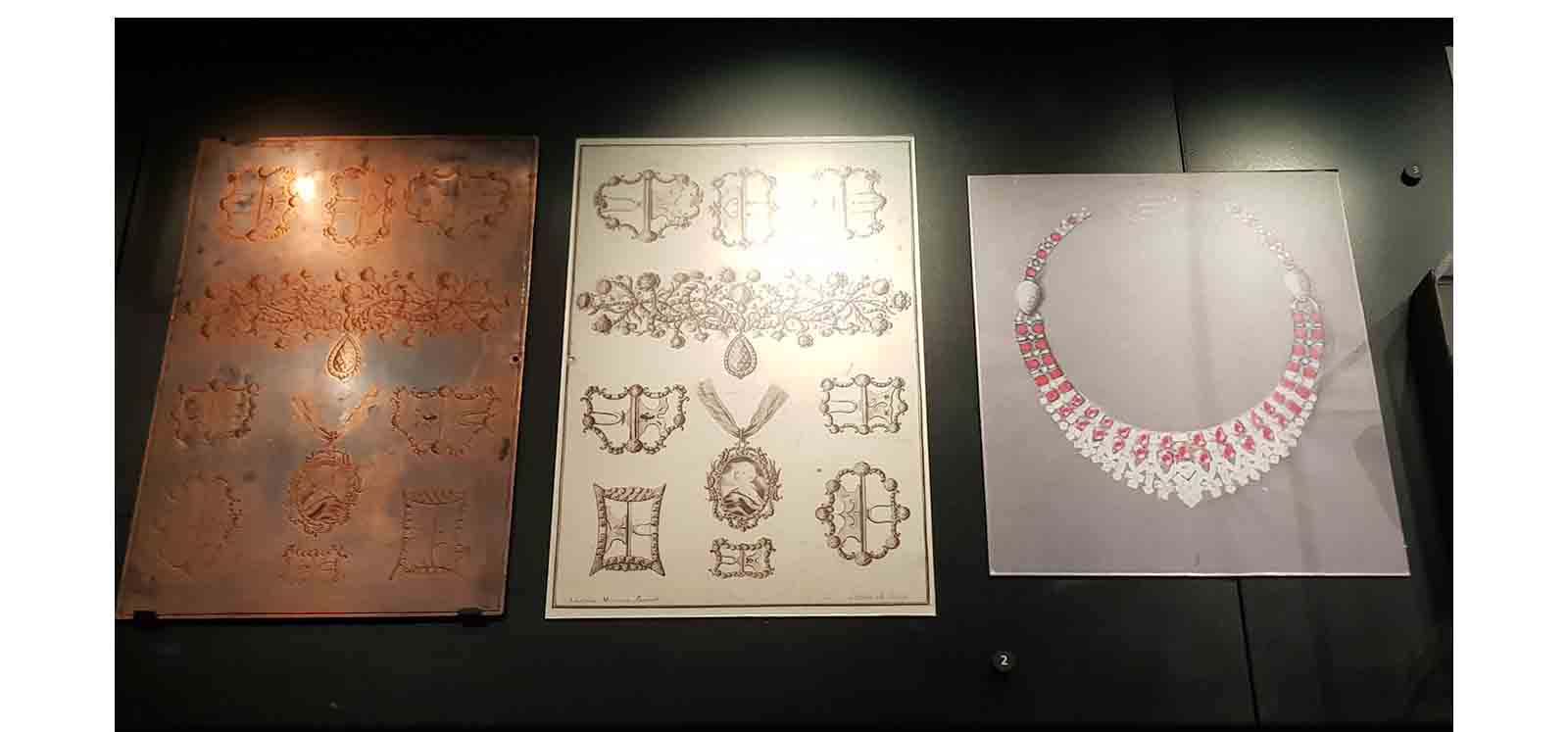
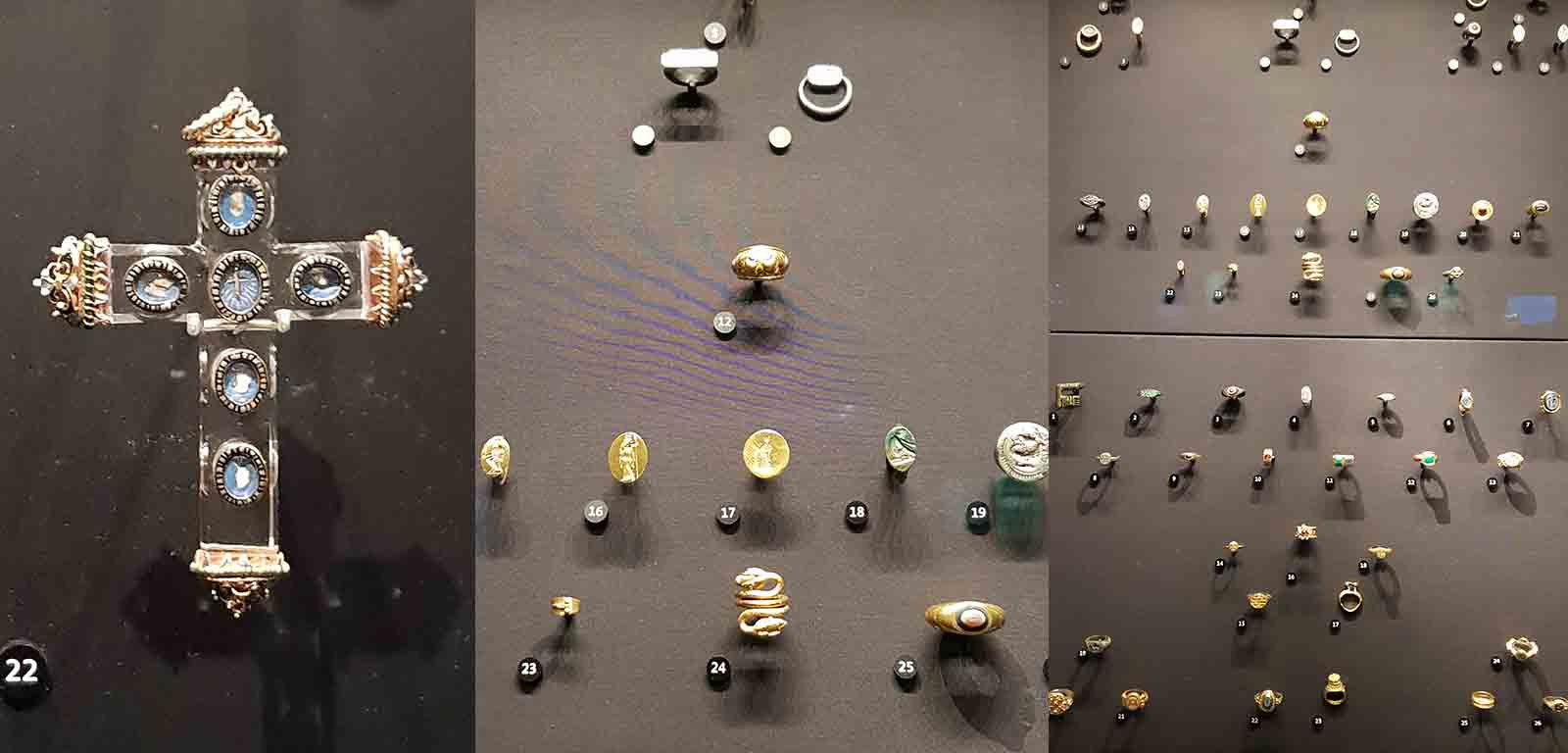
Objects of belief and veneration are present through the twinkling hall and above to the left a reliqy icon of clear crystal features the splinters of bones believed by the wearer to be of Saints. For the owner or owners this would have held great significance across time. Centre above intaglio rings from the ancient world bear symbols of venerated Gods that supported belief and stones that held meaningful symbols. What adventures and journeys did these ornaments take? We'll probably never fully know but they area as unique as the finger print of the people who wore them.
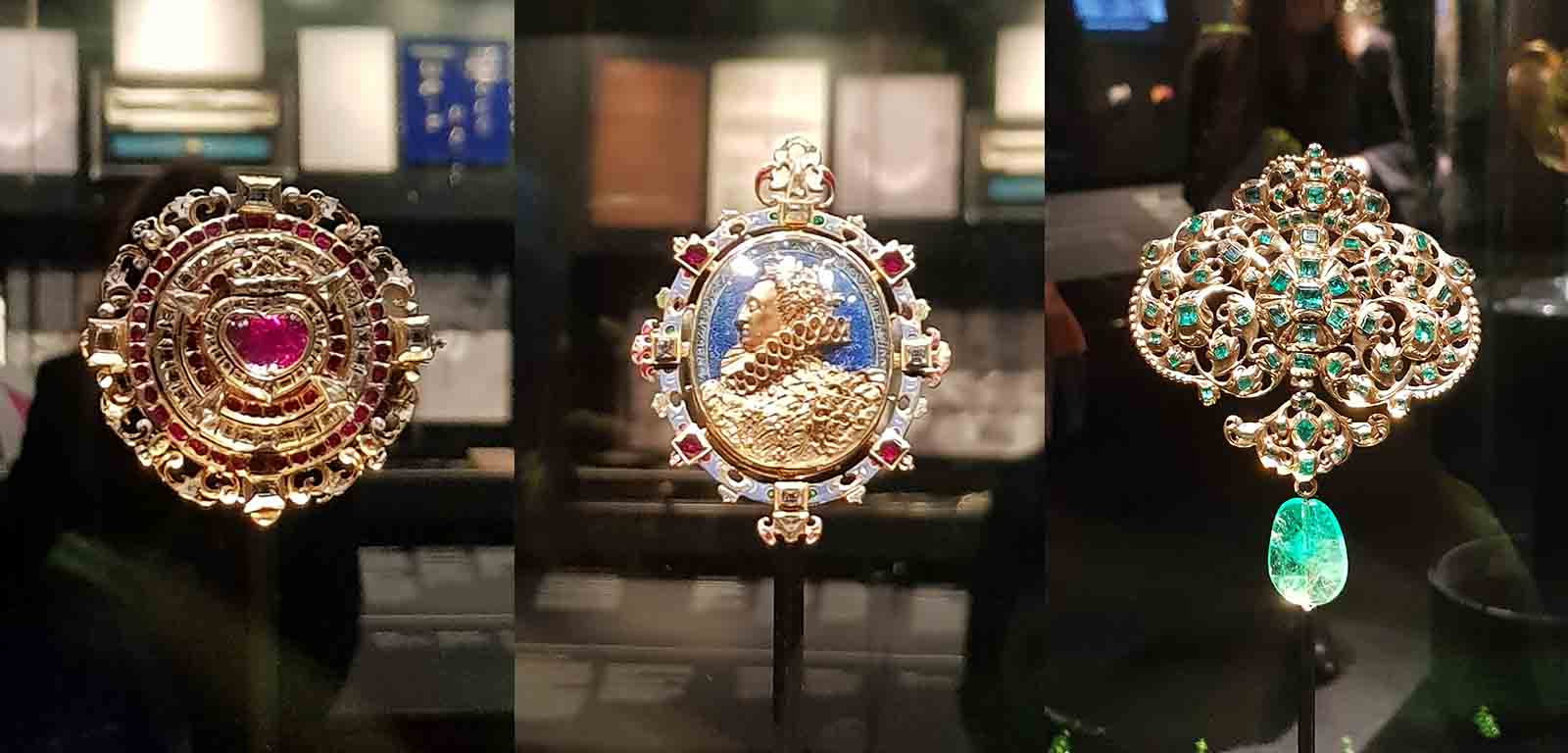
Brooches where a popular item of jewellery in the Bronze age and returned again in the renaissance era in the form of a locket and retained their popularity in several forms for centuries. Above to the left a jewelled locket from around 1610-20. The heart is pierced by two arrows. This piece is believed to originate in Bohemia and was gifted to the museum after ownership by the Countess Harley Teleki. It shows the universal language of stones in symbolism through rubies meaning love and diamonds for continuity and endurance. Centre above 'The Henage Jewel' or the 'Amada Jewel' as it is also known was created in about 1595 by Nicholas Hilliard and is typical of the jewels that would have been worn at the Court of Queen Elizabeth and into the Stuart era. On the reverse side a Golden ship on a steady sea to represent both the English fleet and also the defence of the Church of England from foreign conquest. To the right above, one of the examples of European craft made possible by Spain's Empire in South America. Colombian Emeralds, prized across the world where matched with Diamonds by a Spanish jewellery to create this pendant between 1680-1700. The reverse of the pendant shows a botanical drawing that perhaps nods to the emphasis placed on new life and fresh beginnings that the bold colour brings to mind.
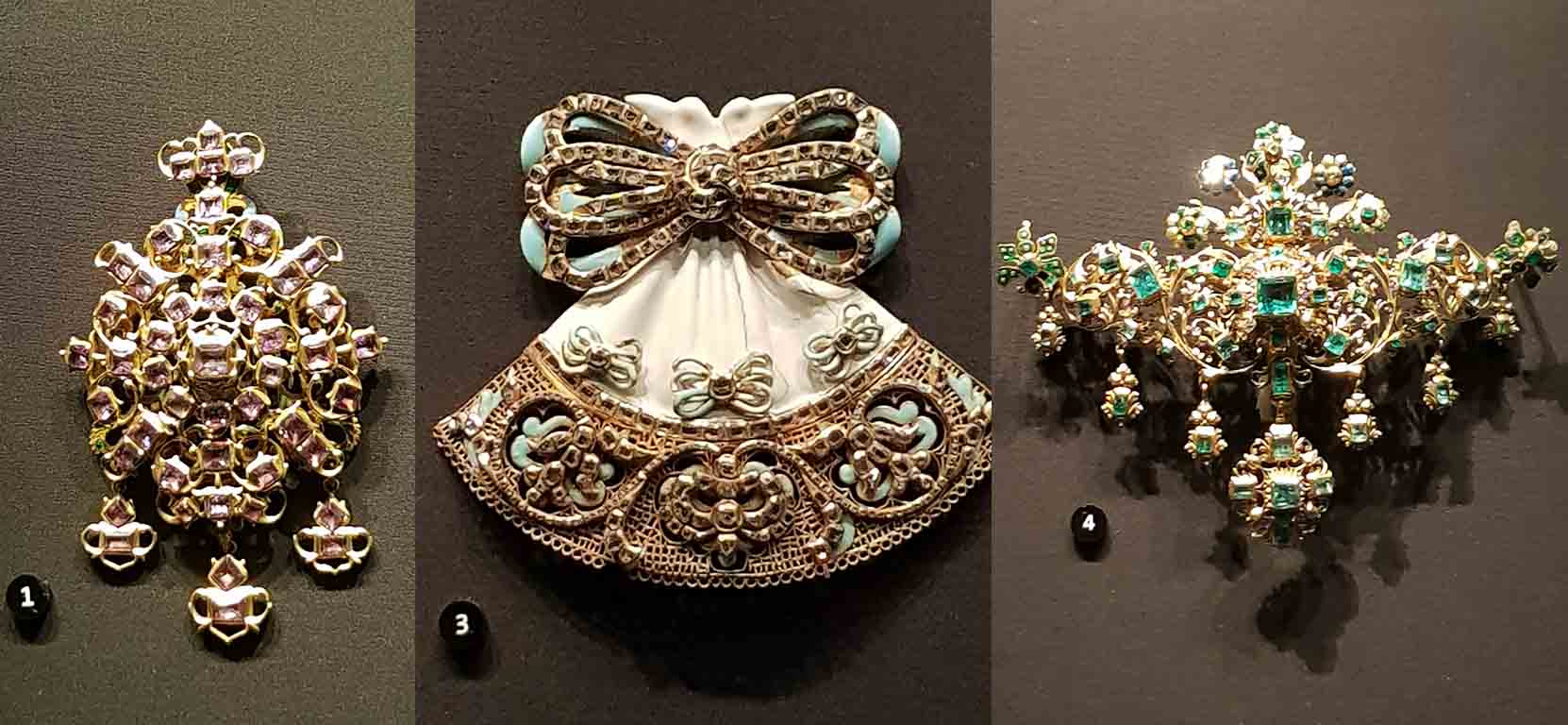
Breast ornaments where something that was easily adaptable to the wardrobe of women in the 17th and 18th century due to the style of dress. You can see above and below the shapes and jewelled metal work echoing bows and ribbon rosettes that people would also wear in fabric form on their clothes. These jewels where highly prized items and the time and dedication taken to craft them required years of training with artisans in high demand. An expression of wealth, they were also fashion items in their own right and would represent a woman's personal material wealth. As noted in the guide below in the gallery, many women in Spain donated jewels like this to church which must have proved more lucrative to the institution than for their own descendants. Jewellery was one of the few assets women could hold and pass to their daughters or grand-daughters for their future financial security. These styles, although several centuries old have never entirely gone out of fashion and each of the above three jewels could have been worn in the 20th Century. The centre jewelled piece looks slightly similar to the 'ballerina brooches' that are created by Van Cleef & Arpels today.
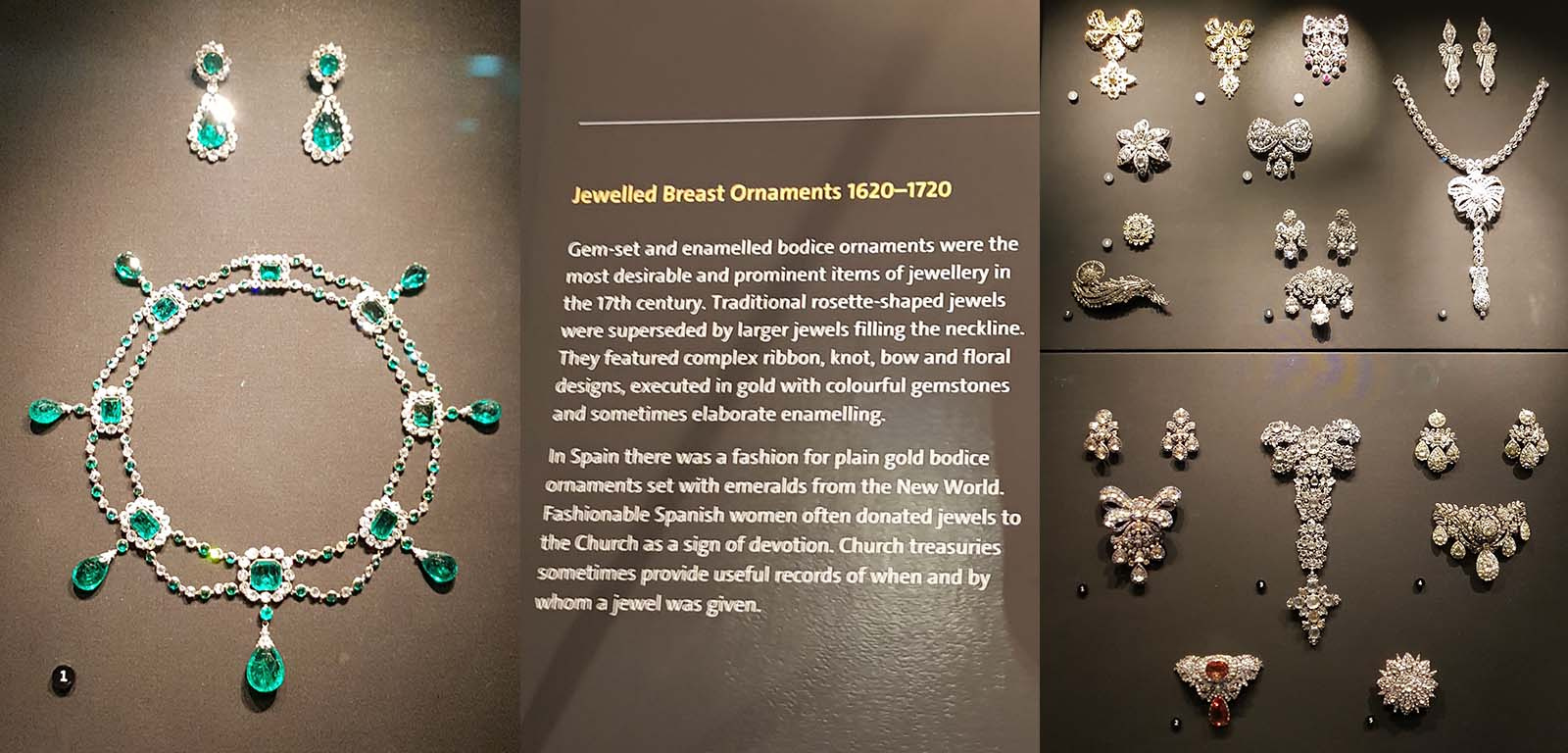
The intricacy and beauty of these pieces is exceptional and these cabinets are worth spending some real time looking at to understand the skill and meaning woven into designing the pieces. Diamonds are by far the most populous stone through the range, perhaps to show the enduring nature of the affection shown through these tokens. It's amazing to think that these pieces where owned and worn daily to grand banquets across Europe and that people and families may have owned several. Above to the left, I slotted in a diamond and emerald necklace and earring set from the display as it seems like a natural match to the brooch above it although from a different place in time.
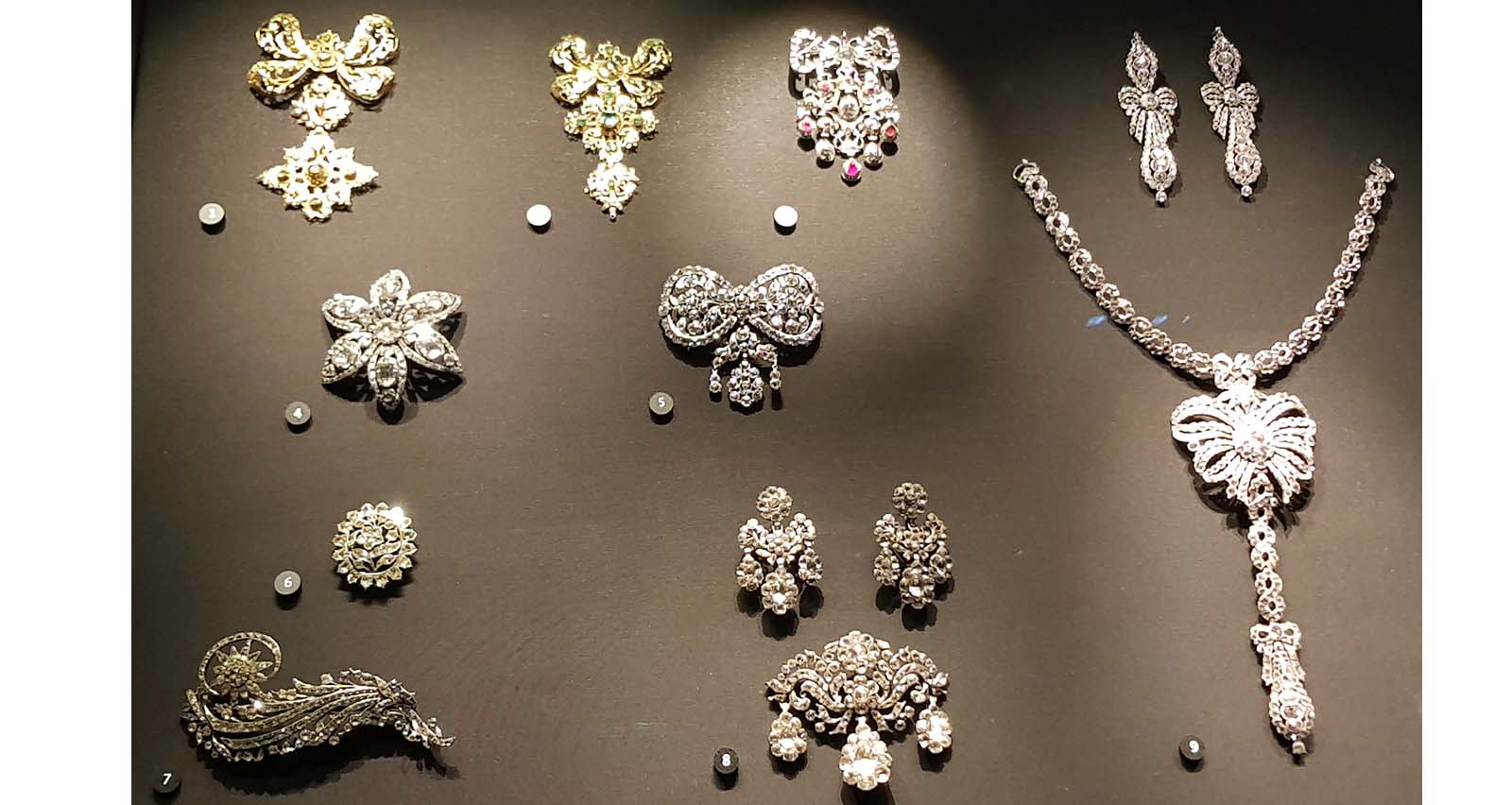
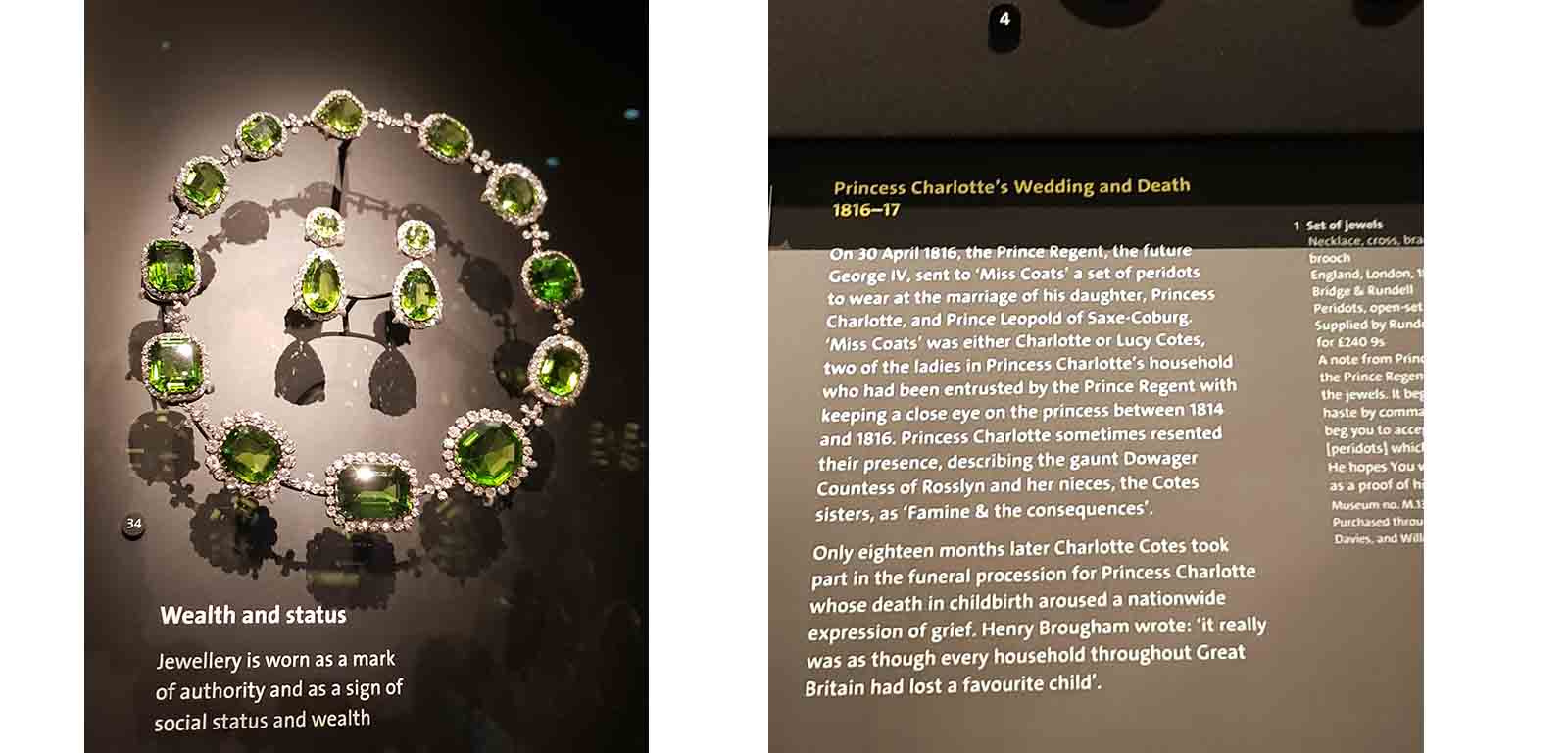
The Regency era was filled with interesting characters and none more so than the Prince Regent himself. His generosity ensured that the arts flourished in all manner of forms and for people close to him that he trusted he could be known to gift amazing pieces. The display contains a demi-perure of Peridot jewels which whilst today are unusual, where very popular in that time. They have quite a charm and later in the 19th and early 20th century this stone was teamed with Amethyst to create Suffragette rings. There is something cooling about these stones and I think, in a moment of childish memory, I'm thinking of Jelly from childhood made by Mum. But back to the sparkly things. Above a necklace with large stones and matching earrings is a memorable feature of the gallery and I think these stones would compliment many different skin tones, although they do not seem to be worn much today. Below the demi-parure, or set of jewels gifted by the Prince Regent to a young Lady of the Coats family in recognition for their chaperone duties alongside the Countess of Rosslyn to his daughter. Sadly princess Charlotte died young and didn't inherit the throne but the jewels serve to mark the bonds of friendship around the Royal Court and for many other people and families besides.
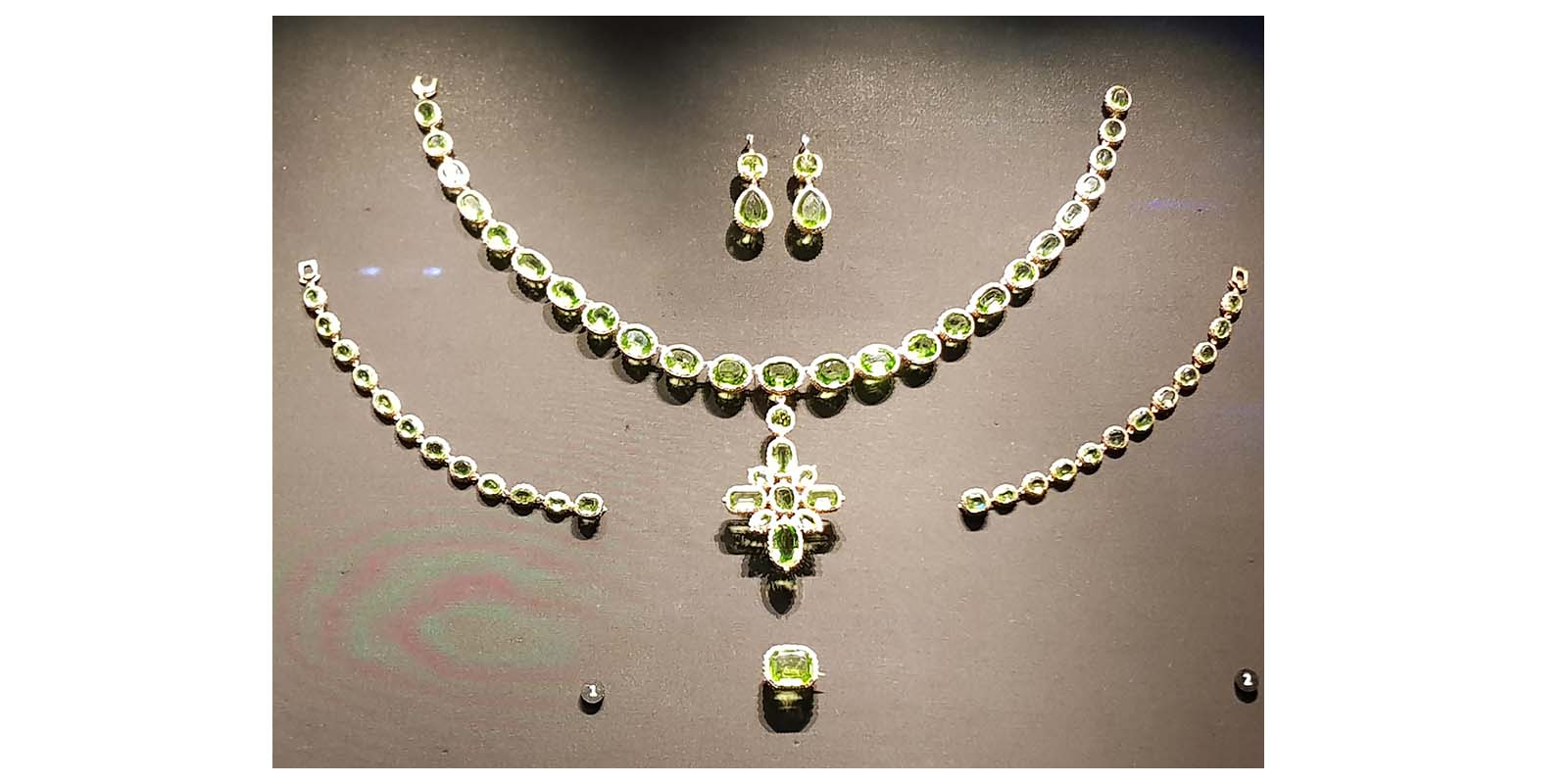
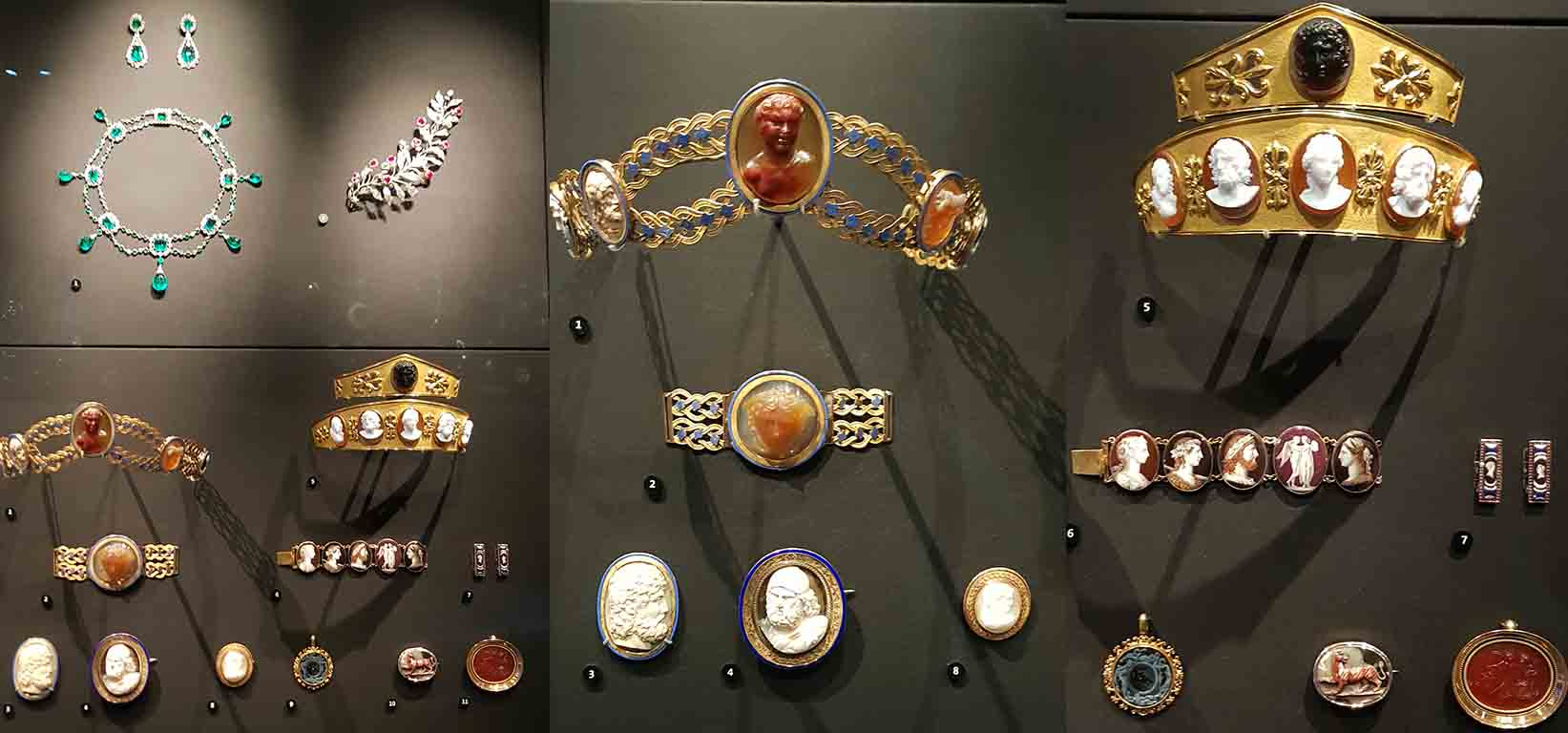
One of the most totemic overtures to the Greco-Roman age came in the form of Cameo jewellery that spanned the width of the artisans imaginations. Rings, bracelets, brooches, lockets and most memorable of all, diadems, where mounted with carved images from the past and also the portraits of loved ones and friends in the present. Later in the Victorian era the grim association with funerary 'momento- mori's' came along but initially these where works of art that may also have sparked conversations about legendary historians, philosophers and rulers. Carved Amber, marble, plaster and hardened resins where favoured and occasionally metals. When you look at these pieces above, it's vintage Josephine Beauharnais or Desiree Clary, her contemporary who married the King of Sweden. These women of the brand new Empire that appeared with such speed under Napoleon, where very quick to assimilate the trappings of the ancient world. Also by coincidence Napoleon's favourite sister Pauline Bonapart, after being gifted a huge villa near Rome sparked a renewed fashion for archaeology in the city (beyond the regular rummaging to find things to sell to rich travellers) by insisting that her estate be excavated by the gentleman antiquarians of the day. She settled near Frascati outside Rome as several of Napoleon's family did as the family was drawn to the area. Many, including some wandering Brits, flocked to roll up their sleeves alongside Napoleon's academic army bent on taking things back to France. Extant portraits of Pauline show her wearing similar jewellery to that shown in the gallery's cabinets.
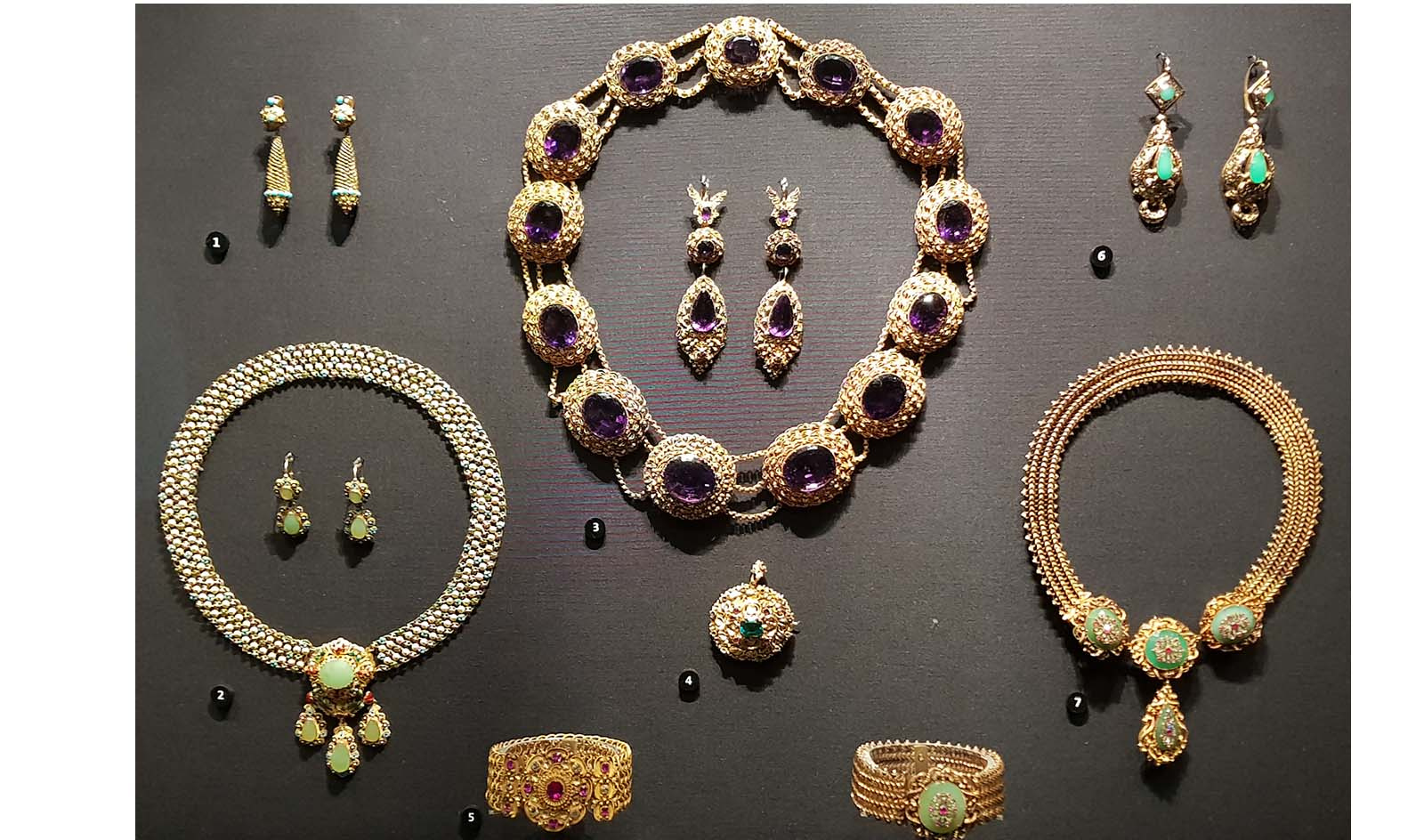
During the era of the French Revolution, 1789 to the early 1790's, the punishments for wearing any form of jewellery adornment could be serious. You could even been guillotined for wearing Silver buckles or simple Golden jewellery that had been worn for centuries by the middle classes. But times where fickle and by the late 1790's, just a few years after, they had come back into fashion again and during the reign of Napoleon the swift turn of face was complete, challenging and exceeding the heights of luxury under the older ruling families. Centre above a personal favourite of mine, an Amethyst earring and necklace set featuring large round stones set surrounded by chains of Gold melded together in a classic Romanesque style. The Napoleonic love of the classical world allowed the creativity of artisans to flow freely and conjure many different designs emulating the past to be worn by varied clients across the continent of Europe and in America. Above you can see the use of Jade and Ruby in several places that proved very popular. Jewels hanging from central necklace pendants and stones in bracelets articulated with the most dazzling metalwork. I'm also drawn to seeing a resemblance to Indian jewellery which I think I have seen in the past between ancient Rome and more recent India.
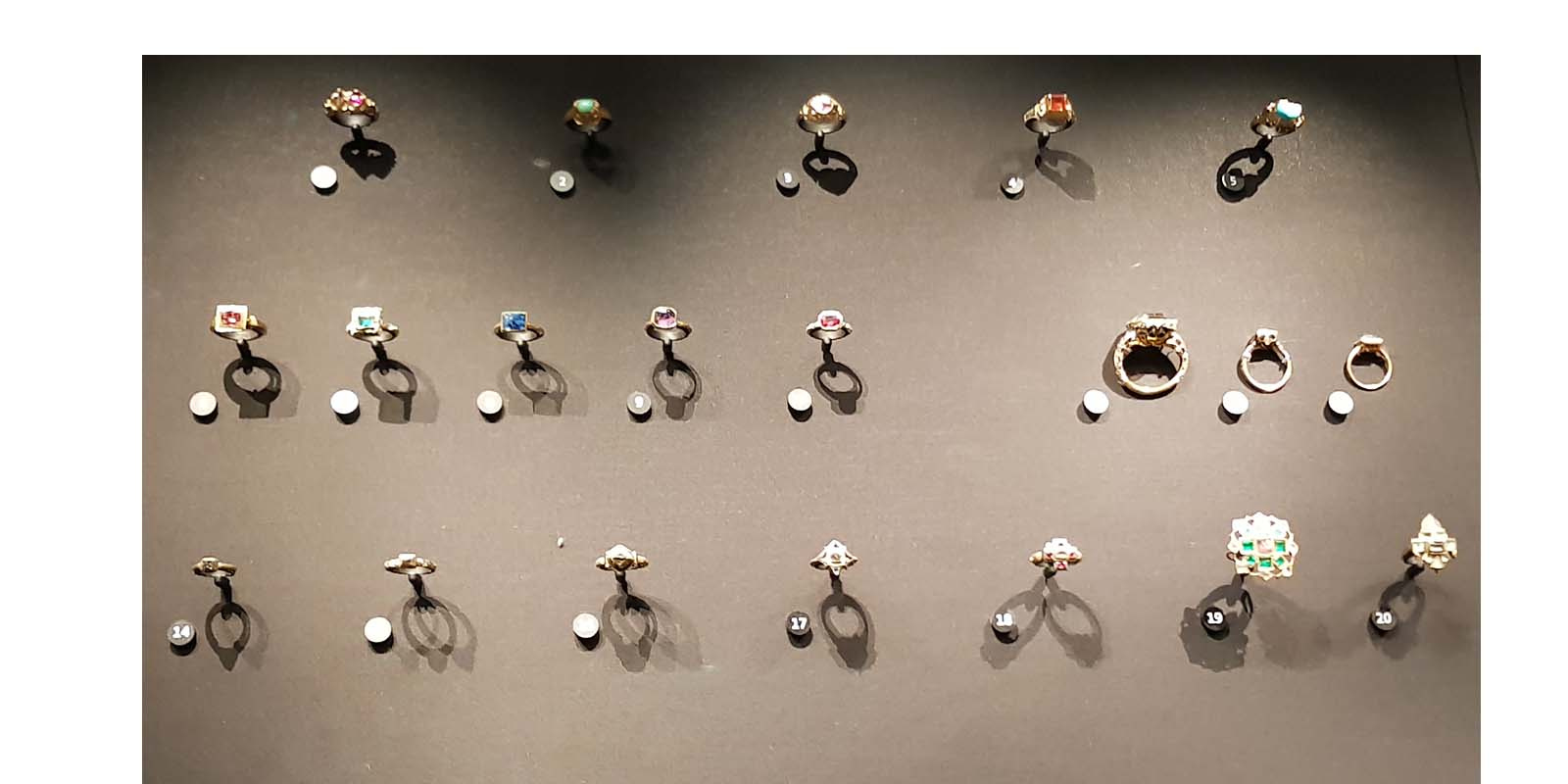
Rings are one of the most ancient and universal forms of jewellery and above a small sample of the collection that spans millennia. Rings are also the most often used form of love token and before engagement rings where commonplace in Europe they also included posey rings to symbolise affection. The coloured stones that form the heart of the rings story must have had quite a journey before they reached this cabinet to be preserved.
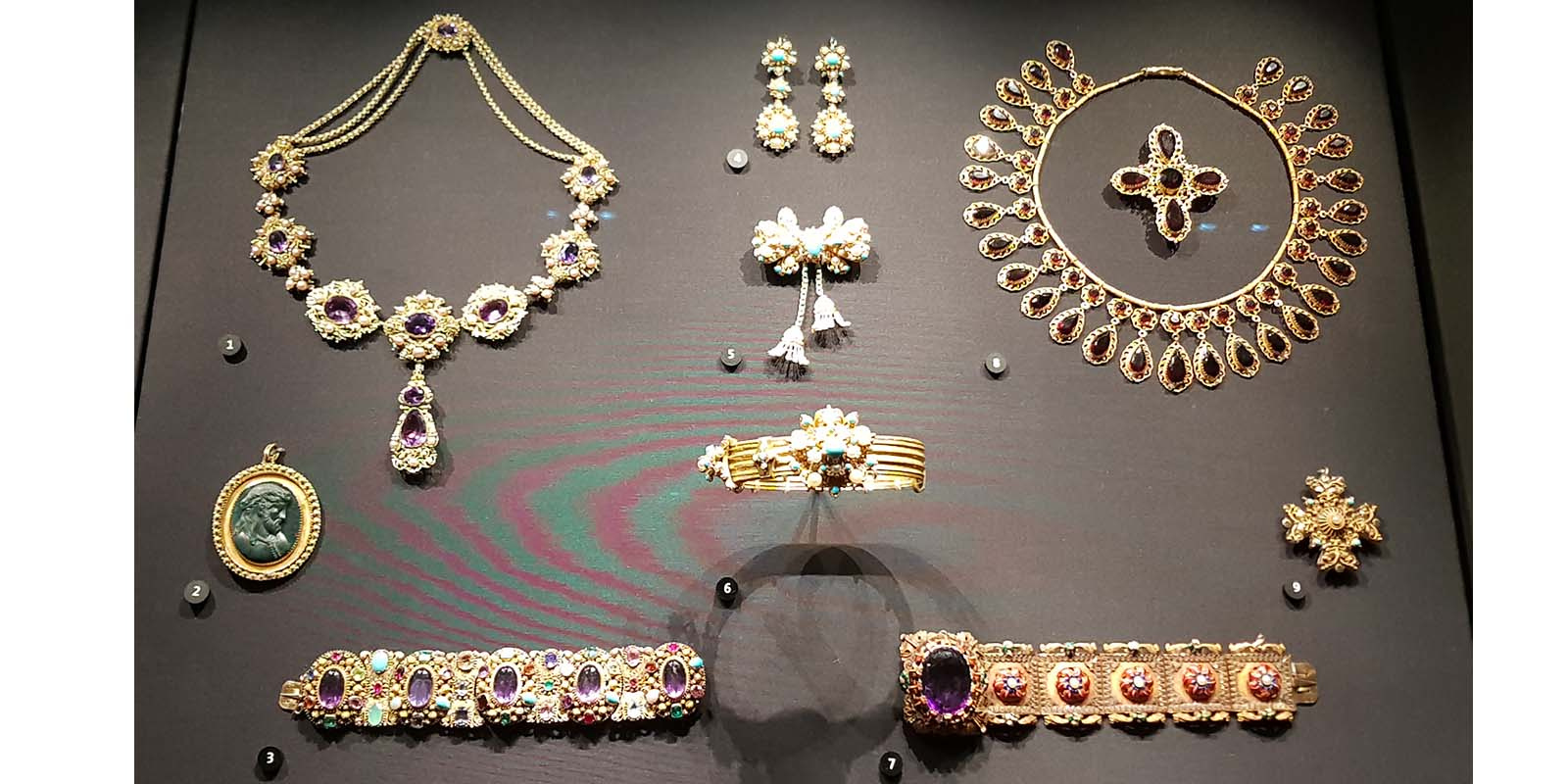
Embracing the curiosity of a new age, the pieces seem to reflect the exuberance of the new French Empire. More Amethysts, the stone I personally adore but today neglected by owners and collectors, feature in a necklace and in cuff bracelets above.The pieces look like they have just been dug from the ground with their replica antique appearance and a Golden circlet bracelet has a Bronze Age resemblance in it's metal working beneath the cluster of jewels. Two necklaces of varying styles proudly use large stones. Above to the left an Amethyst necklace features a seven point jewel design with a pendant drop at the centre featuring an eighth and ninth stone. It speaks to an Imperial age but is not too dated to be worn today. To the right a circular creation using what I believe are Rubies (or may be Garnets) features intricate filigree and spiral detail that was popular through the 1820's and 1830's. Many of the above pieces are from Europe and on the continent it was popular for a greater area of Gold to be visible to the eye.
Below a tiara that looks almost like a crown is fashioned in intricate Gold work with large Jade or related stones placed in the headband and the peak of the piece. Again this is another creation that looks like it has come from the ancient world and been recalled to life once more. Below it an Amethyst brooch accented with diamonds symbolises the devotion of a wearer whilst two more pieces placed close by signal the nod to the favourite chandelier style three-drop shape that was fashionable across decades. A pendant brooch to the right below shows another example of a popular style that moved from the Baroque to the Imperial age. To the left a necklace and earrings match to the brooch placed centre makes a captivating set. The excavation of the site of Troy by Schlieman in the second half of the nineteenth century revealed, amongst other things, many pieces of jewellery worn by the ruling families of Troy that occupied the site across millennia. A beautiful Sapphire necklace and earring set from the late Victorian era aims to capture the a legendary sense of beauty. It looks somewhat scratched in the case but with a careful polish could be brought to life again. To the right a tiara and pin from the Londonderry Jewels collection that I'll talk more about below. These pieces where evidently much worn by the family who owned them but still retain much of their allure.
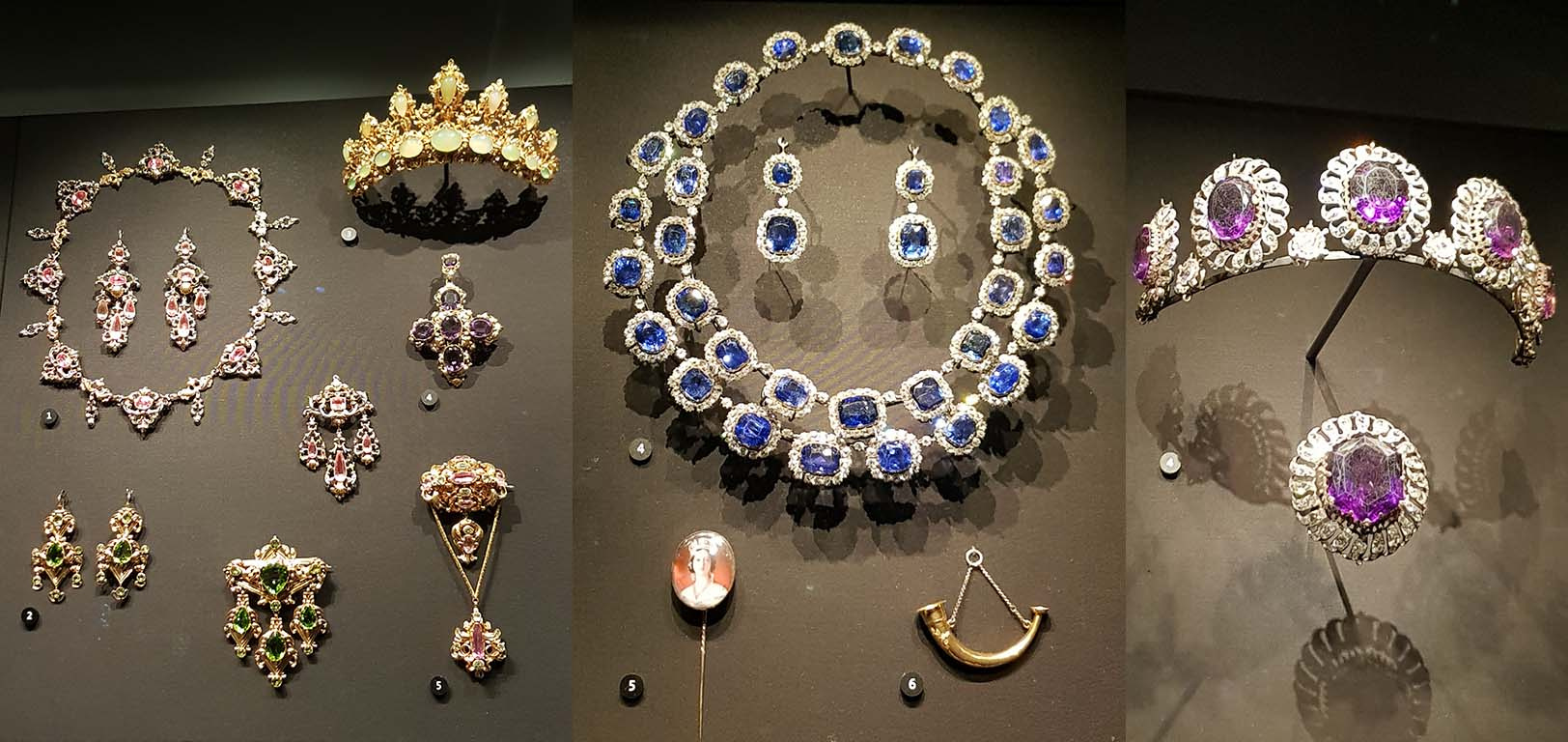
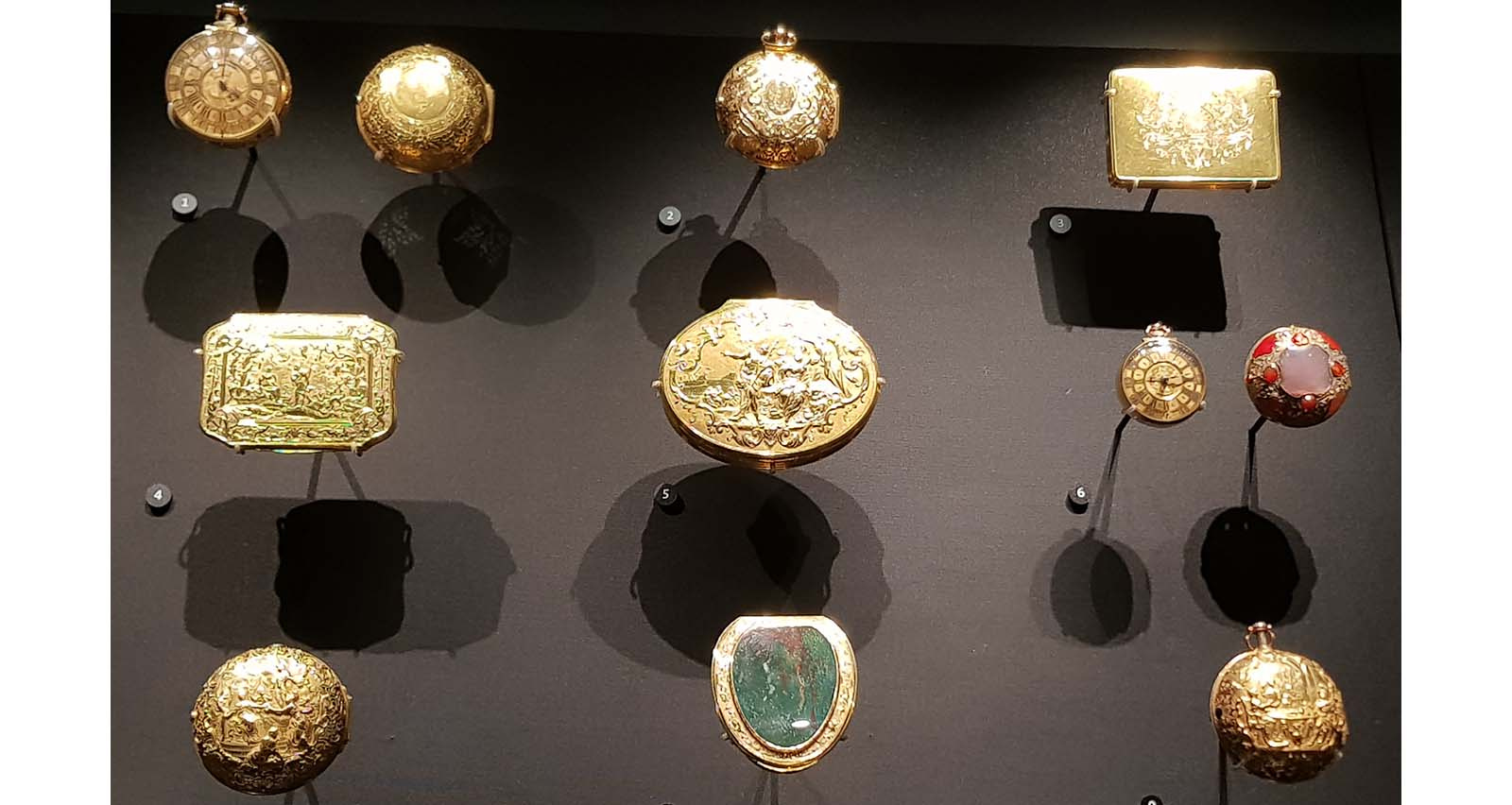
Several cases in the collection are devoted to jewelled trinket and keepsake boxes. It's a fascinating sub-set amongst the treasures on display and shows the extraordinary skill of the craftspeople working across past centuries. The images carved or moulded onto the surface of the boxes recall scenes from classical mythology often or express a jewelled design that reflected the tastes of either the crafts person or the owner. Looking through the glass paynes of the cabinet you can guess at the stories behind these special objects. Gold is used in profusion again in keeping with the preferred tastes of Continental Europe. Watches where frequently placed inside these palm sized objects and as technology advanced in London, Switzerland and Italy, clock makers were able to create smaller and smaller timepieces that had secondary and tertiary functions. These are works of genius and art.
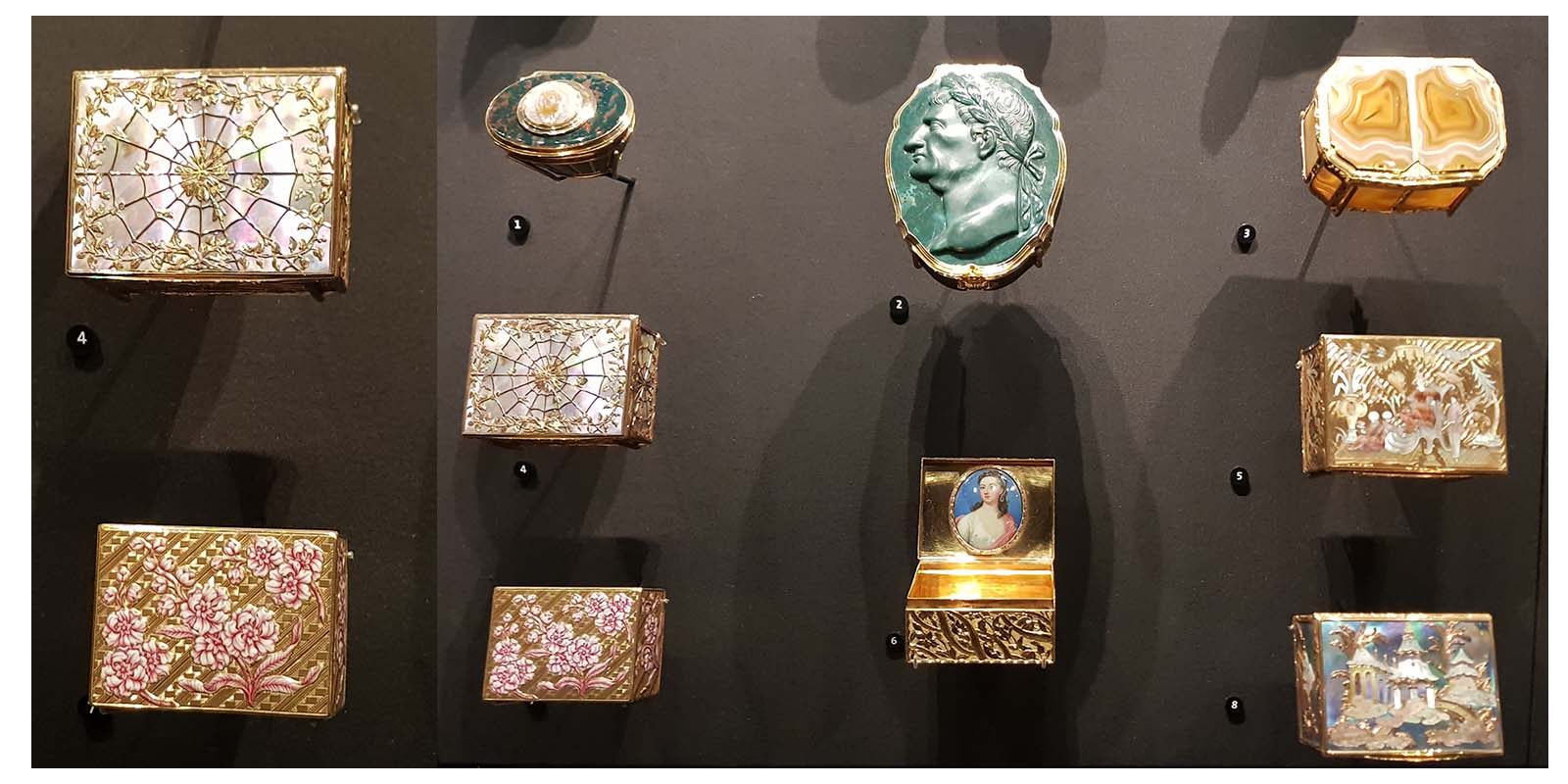
I looked these cabinets in wonder, marvelling at the beauty of the colours of the pieces and wondering how they where created. The soft Rose Pink above in the left hand side of the cabinet has a liquid iridescent light of it's own and part of the magic of enamels seems to be the way that this substance can appear to exude light from within itself. A Golden spiders web design surrounded by leaves hints at rural scenes and nature and a garden of flowers strewn across a finely designed mosaic surface creates a beautiful contrast between nature and design. These boxes often contained a 'surprise' emulated later by Faberge in Russia and in the box centre above you can see a miniature portrait of a lady who was perhaps a recipient of the box or a relative or a friend. The gentle Blue of the background and soft tones of her clothing sit in a bold contrast to the shine of the Golden box. Carved leaf shapes that the fingers would touch and feel bring the curves and life of nature into the hand. Fascination is also expressed with designs from the East in the form of Chinese or Japanese temples that appear on a box to the right above.
Jewellers had a wide source to draw their inspirations from including nature, religious scenes and familiar portraits. Below to the left thoughts of travel perhaps led to the inclusion of the peacock who originated in India but had been brought to England since the 16th century to stride across grand gardens. With the Golden backdrop catching the sunlight the Blue and Green of the birds colouring stood out all the more boldly. A scene from a religious parable appears next with the gentle colour tones used in illuminated scripts painted onto the boxes surface. To the right a small chest is composed of sheets of cut rock crystal and then overlaid with guilt set on four crystal sphere pillars. This is a case that may have contained beauty items as a necessaire but the contents now seem lost and it is itself an object to treasure for it's beauty. There is something about Pink and Gold that makes a memorable combination.
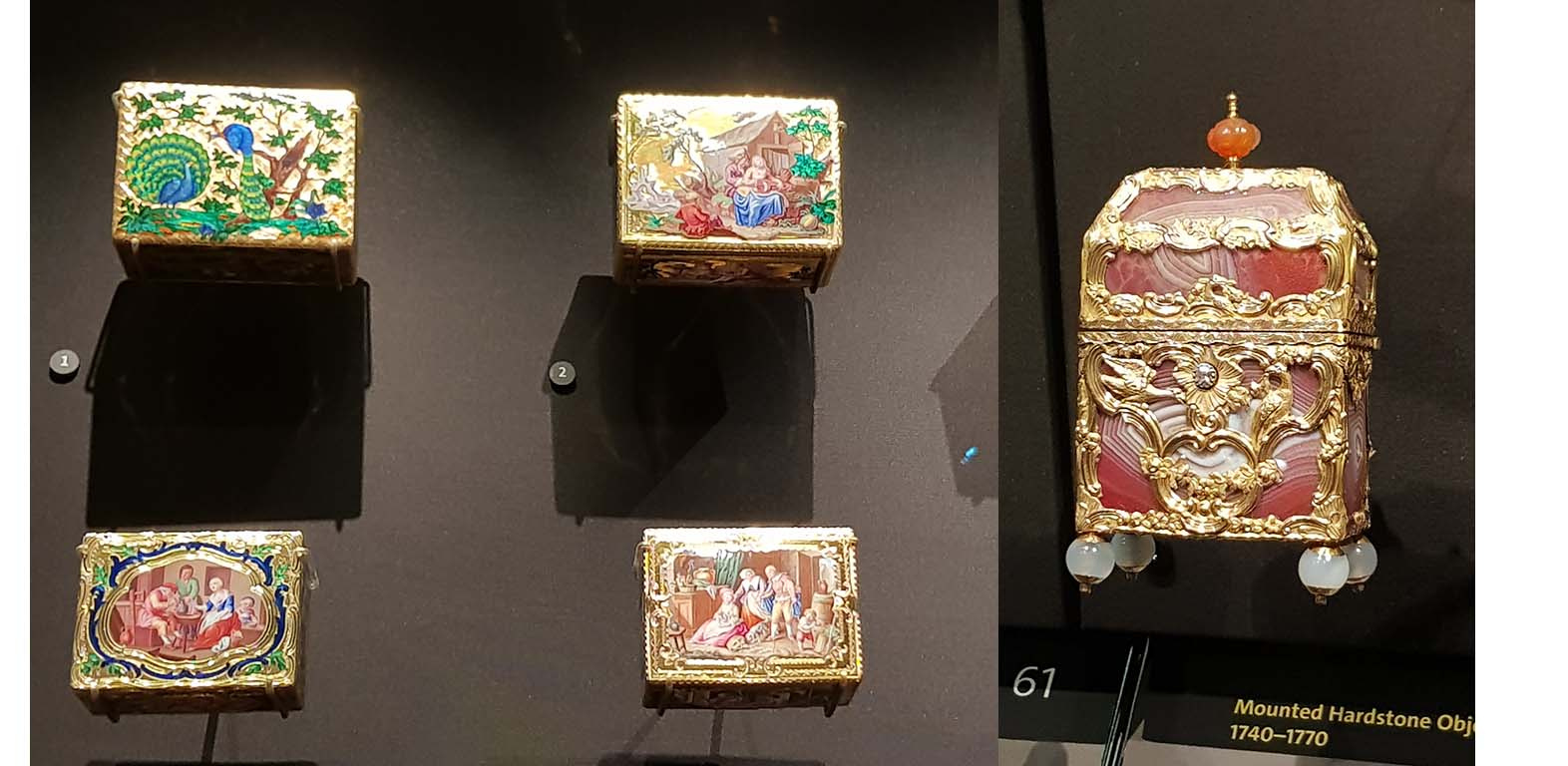
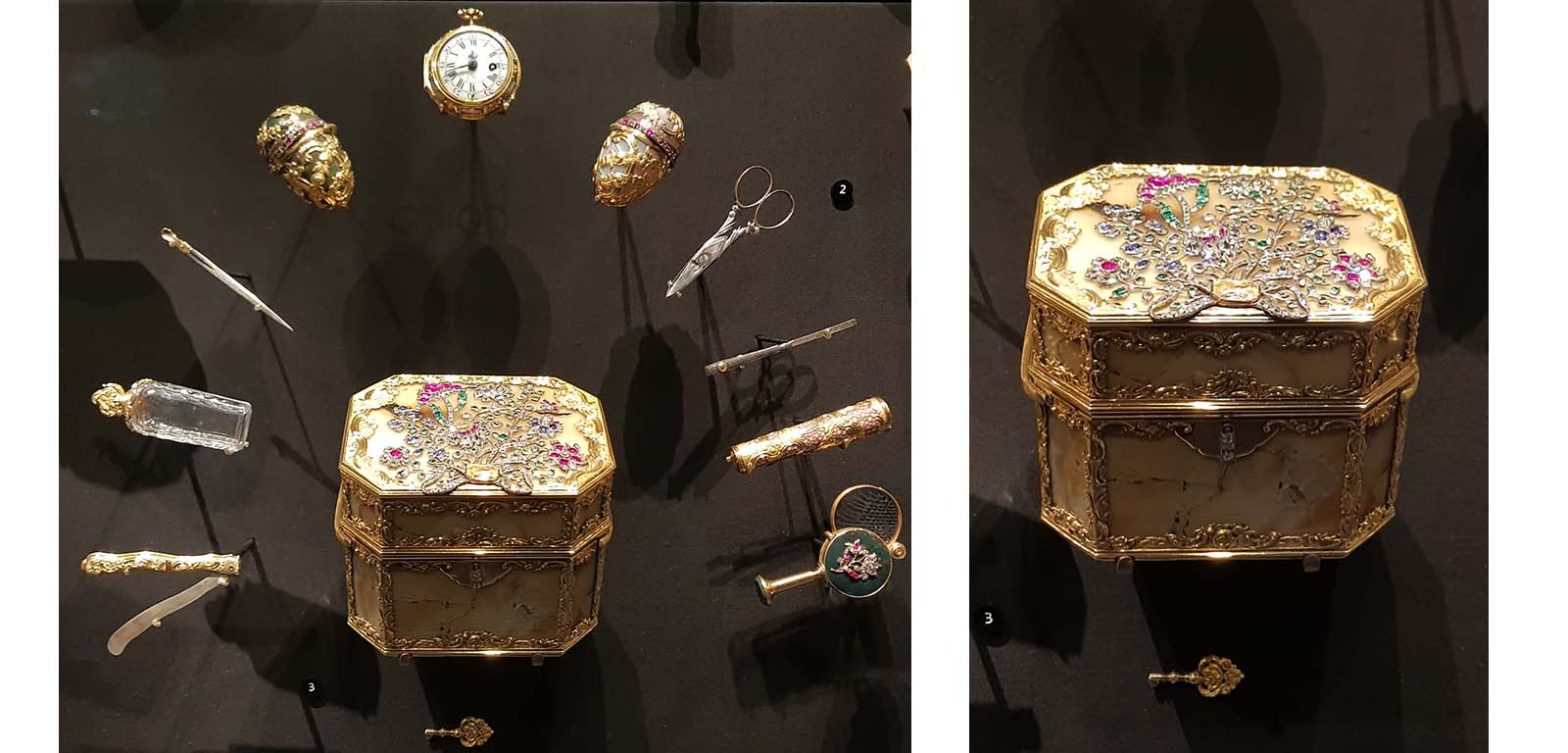
Above this jewelled 18th century French Necessaire case contains small essential items for beauty grooming. I wonder if here we can see the origin of the famous Faberge Eggs in the two small egg shaped containers at the top by the little watch. Peter Karl Faberge moved from France to Russia and brought with him the fine heritage of French enamels that had long been treasured in the circles of the Royal Court and beyond across Europe. The box itself incorporates marble and guilding set with tiny jewels that bring colour and life to the piece. It's like a golden ray of sunshine and small enough to fit in the palm of the hand. A key holds the secrets in place and it could in theory also be used to hide letters and love tokens or keep images of relatives and loved ones. Due to the size of the tiny grooming objects inside, many original contents of these boxes where lost and finding a complete box set is extremely rare.
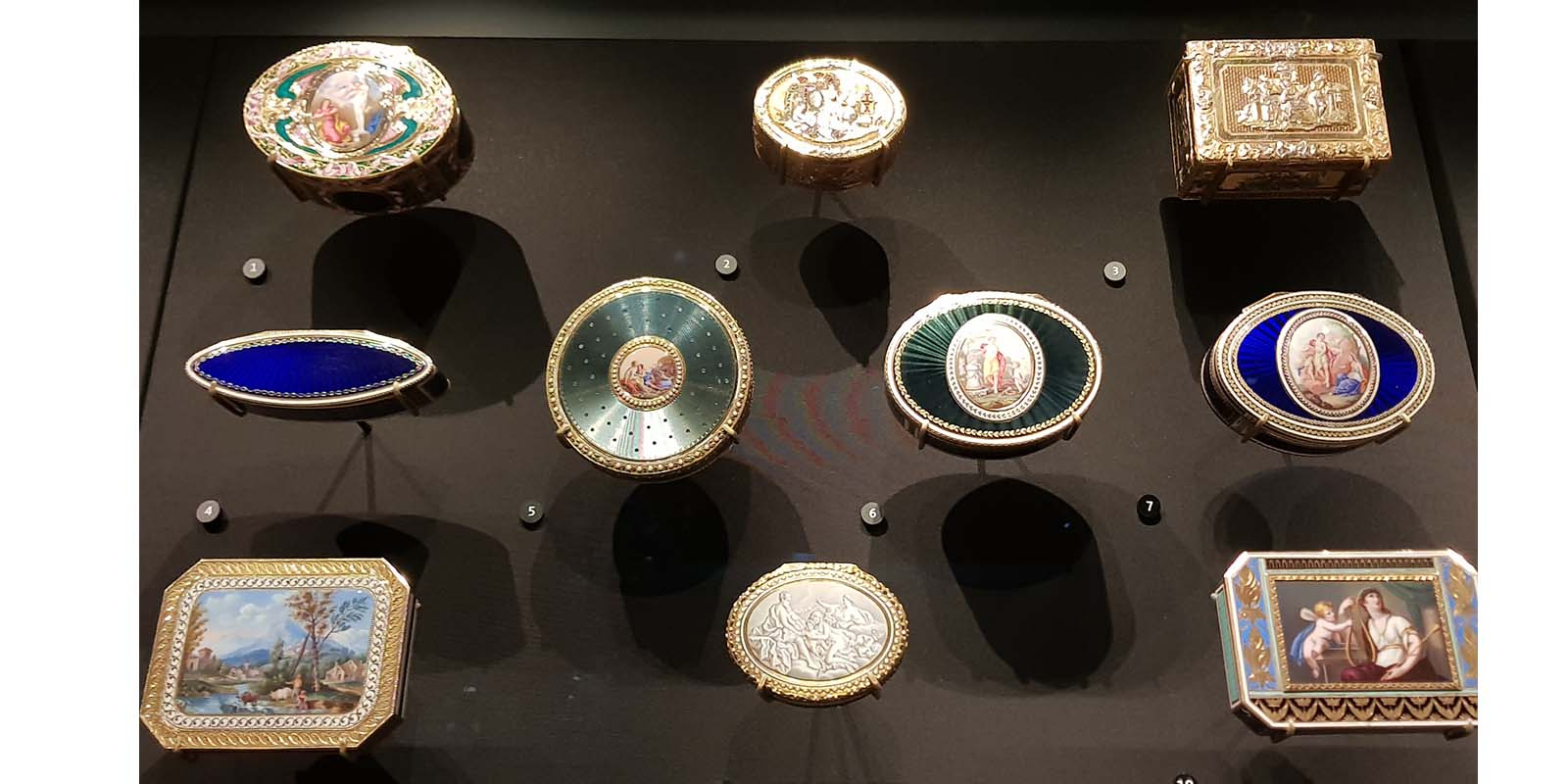
Above and below here are some of the prettiest jewelled boxes that you will ever see. It's another past the Bollinger gallery that simply takes the breath away when you look at it. Many of the boxes feature finely painted portraits or landscape scenes on their lids. Some works are devotional and feature religious figures of the bible, others are scenes from mythology that people fortunate enough to be well educated would recognise and that others could also admire simply for the beauty of their presentation.
The clear bold regal shine of the Royal Blue of the Bourbon standard is one of the most eye catching aspects of the enamels contained in this cabinet series. The clarity of the colour is simply breathtaking and in an age before television or colour printing these objects would have held fast in the memory of those who saw them. The beautiful Teal Green in two pieces centre above is a delicate colour that would have complimented many garments worn in previous centuries. These boxes where owned by both men and women and where sometimes gifted to mark special moments in their lives.
Below in the centre several pieces show the beautiful detail of intarsia set semi-precious stones carved into the lid of of jewelled boxes. This technique has also been used in furniture, most notably card and side tables in the same era and creates a very memorable object full of colour and life. Also in the centre an extraordinary goblet created from a carved shell mounted on a gold column set with semi-precious stones is a unique piece of baroque craftsmanship.
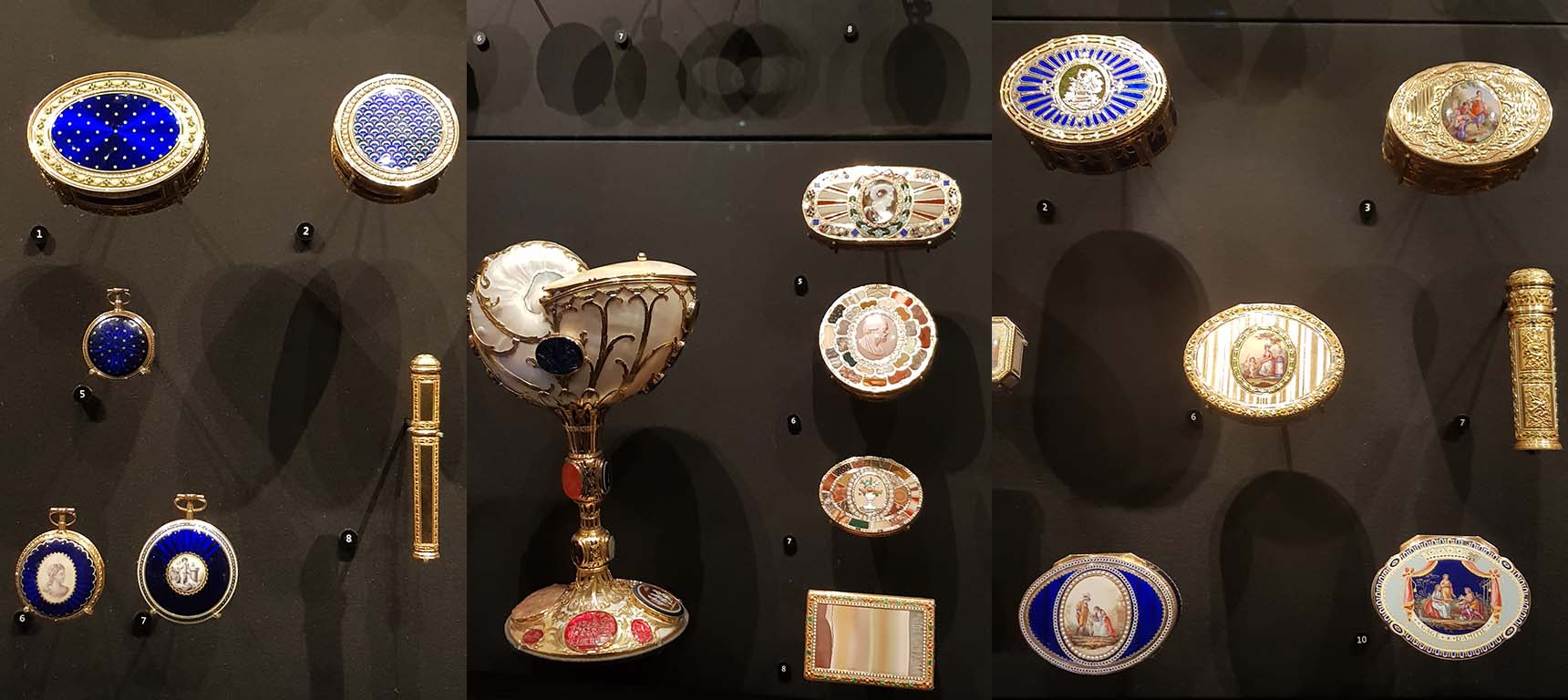

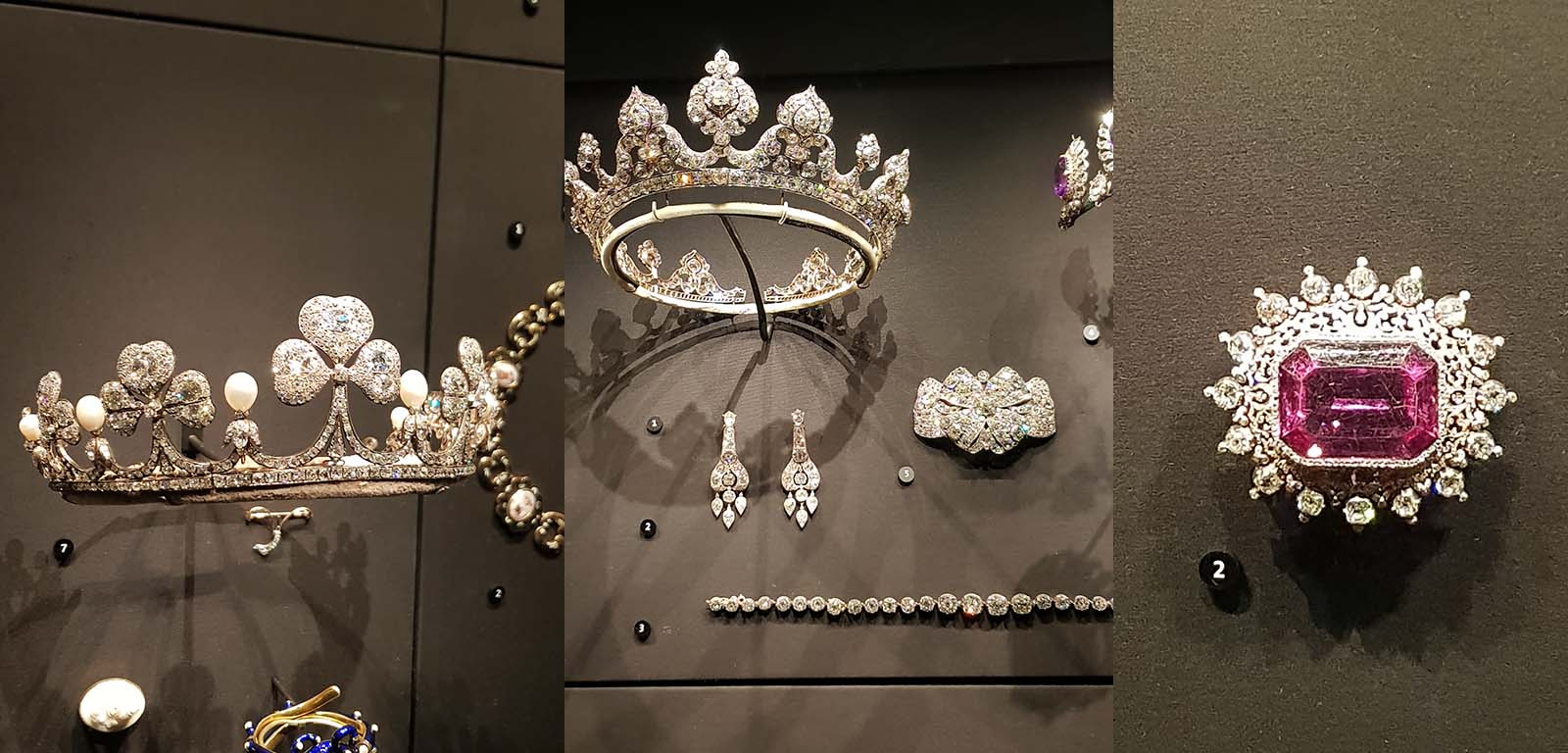
The Londonderry jewels are one of the great collections that where given to the nation, I suspect in lieu of death duties taxes from wealthy families. Below to the right is a painting of Frances Anne Vane-Tempest, a wealthy heiress who married into the Londonderry family in 1819 giving them significant wealth. Today her portrait stands at the entrance of the gallery that contains her families jewels and in her broad gown with train, she can easily be mistaken for a European Princess or Queen of the times.
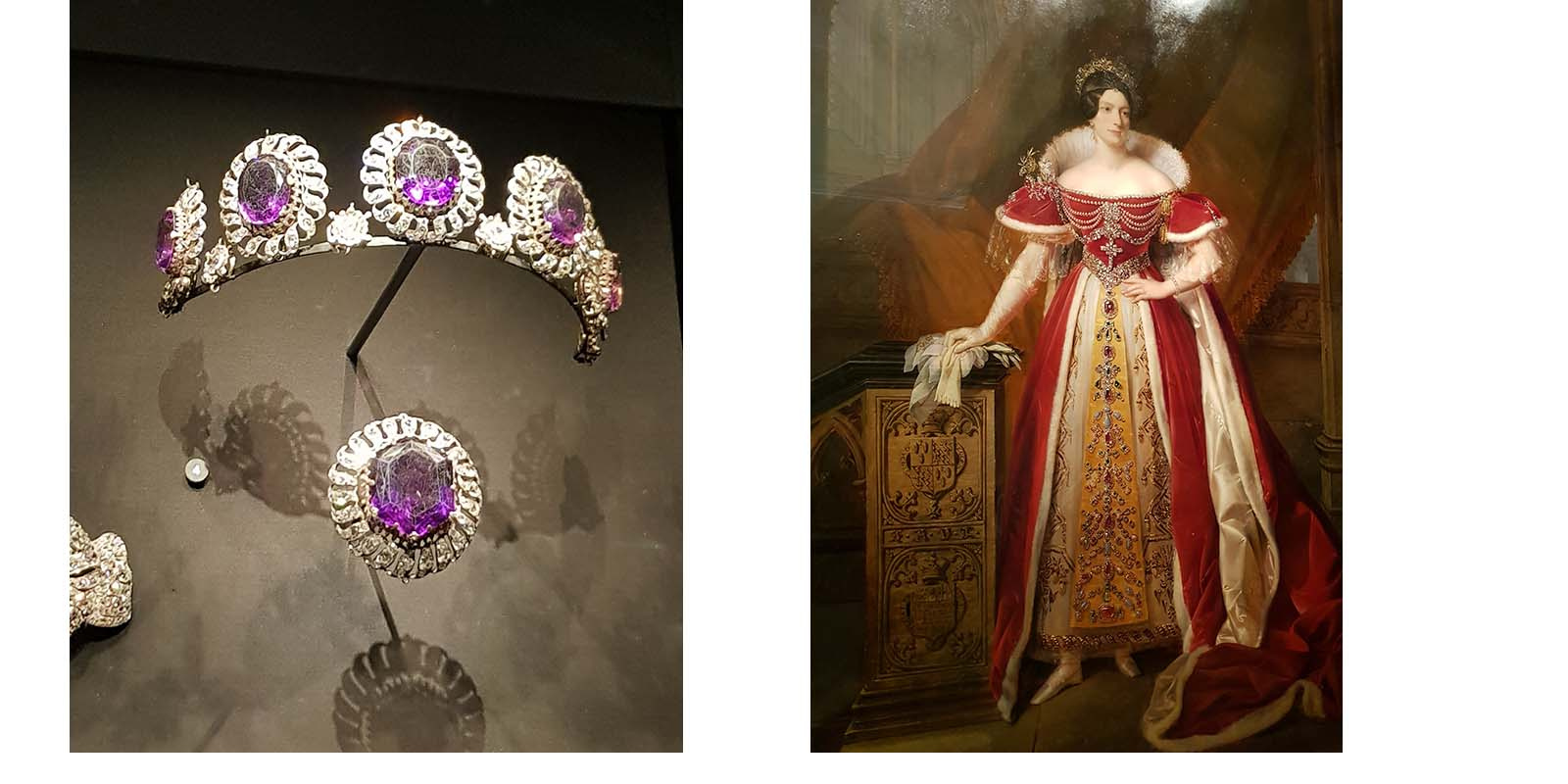
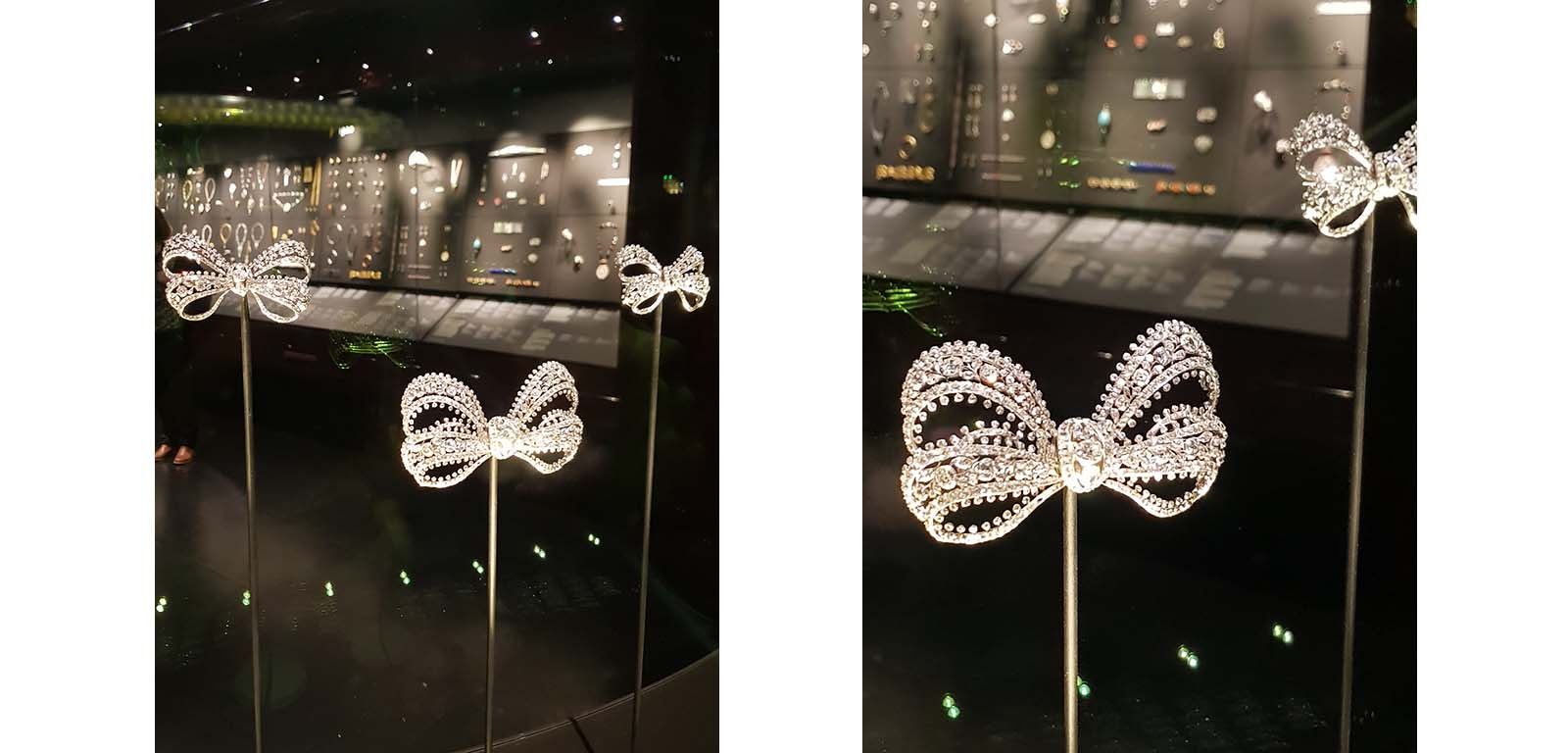
Lastly a group of my favourite pieces in the display. Several pretty Diamond bows for a beautiful set of pins that could be worn on clothing or in the hair. Many pieces of jewellery where worn in versatile ways. Necklaces could be tiaras and vice-versa. Brooches could hang as pendants or also worn in the hair. There is something timeless and pretty about the bow that shines with a delightful light. Below the Aquamarine is shown in parure that features a ring, earrings, large brooch and necklace. The clarity of the colour of the stones adds the feeling that Aquamarines have a light that shines from within them and they have a quality that reminds me personally of the clear Blue waters of the Mediterranean. Some lighter Aquamarine stones feature in a pendant centre below shaped in the form of leaves in the spring time. Venus figures and mysterious shapes show a more abstract approach to creation and exploration of design. There is so much to see in this gallery and plenty to capture the imagination. If you like drawing, I would certainly recommend taking a sketch book.

BADA Art Fair 2019
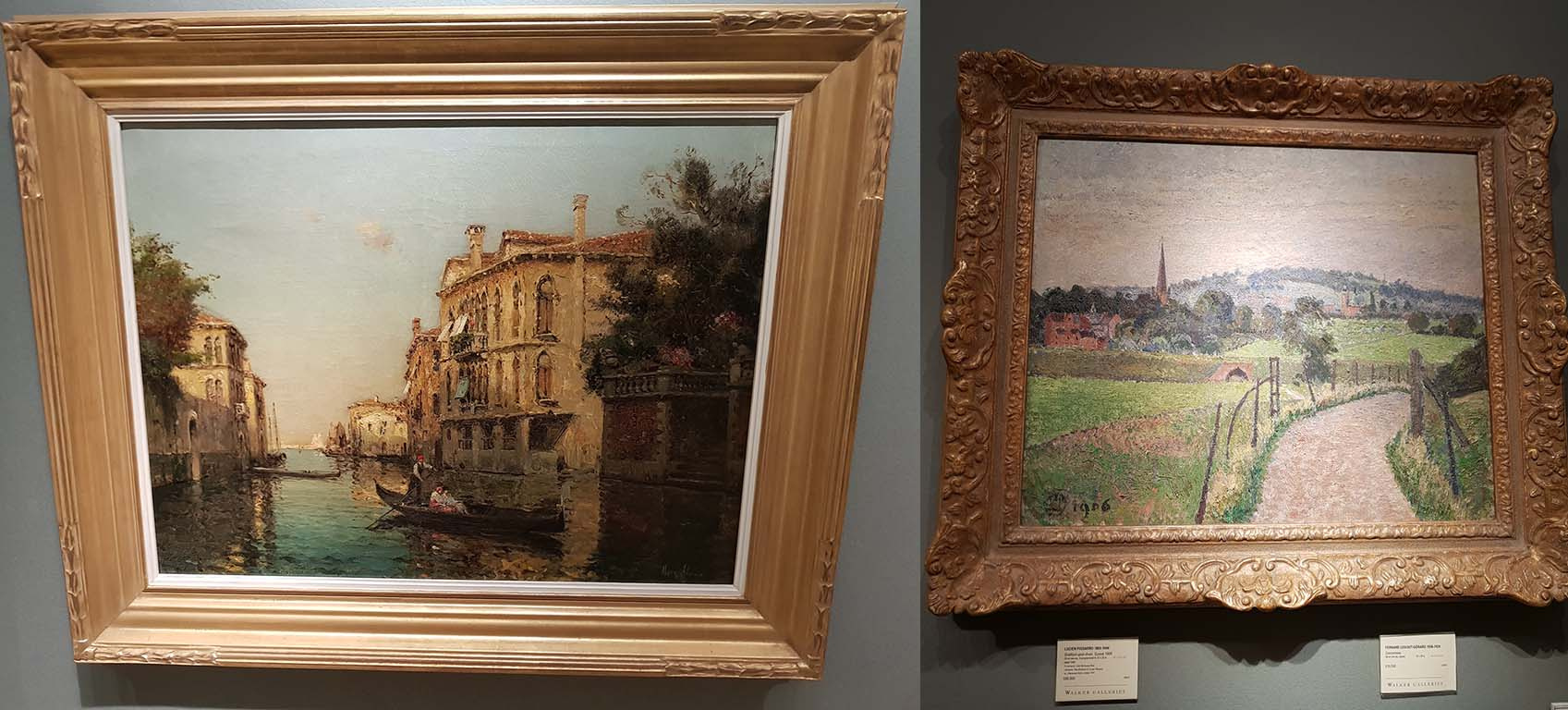
Each spring the British Antiques Dealers Association known as BADA lands in Sloane Square and hosts a wide variety of collectable objects mirroring it's sister Fair LAPADA that takes place each September in Mayfair. The fair shows all kinds of collectable antiques and art in the more classic vein. Above are two paintings shown and offered for sale by The Walker Galleries based in Harrogate in northern England. To the left a classic view of the canals of Venice, please accept my apologies for losing the caption. I last visited Venice in late childhood and was spellbound by the architecture and colours of the city. It was so unlike anywhere else my family had ever travelled. To the right a view of Stratford upon Avon at Sunset by Lucien Pissaro. Painted in the impressionist dot and small stroke style in 1906, this painting gives the feel of walking towards a small town on a hazy Summer evening.
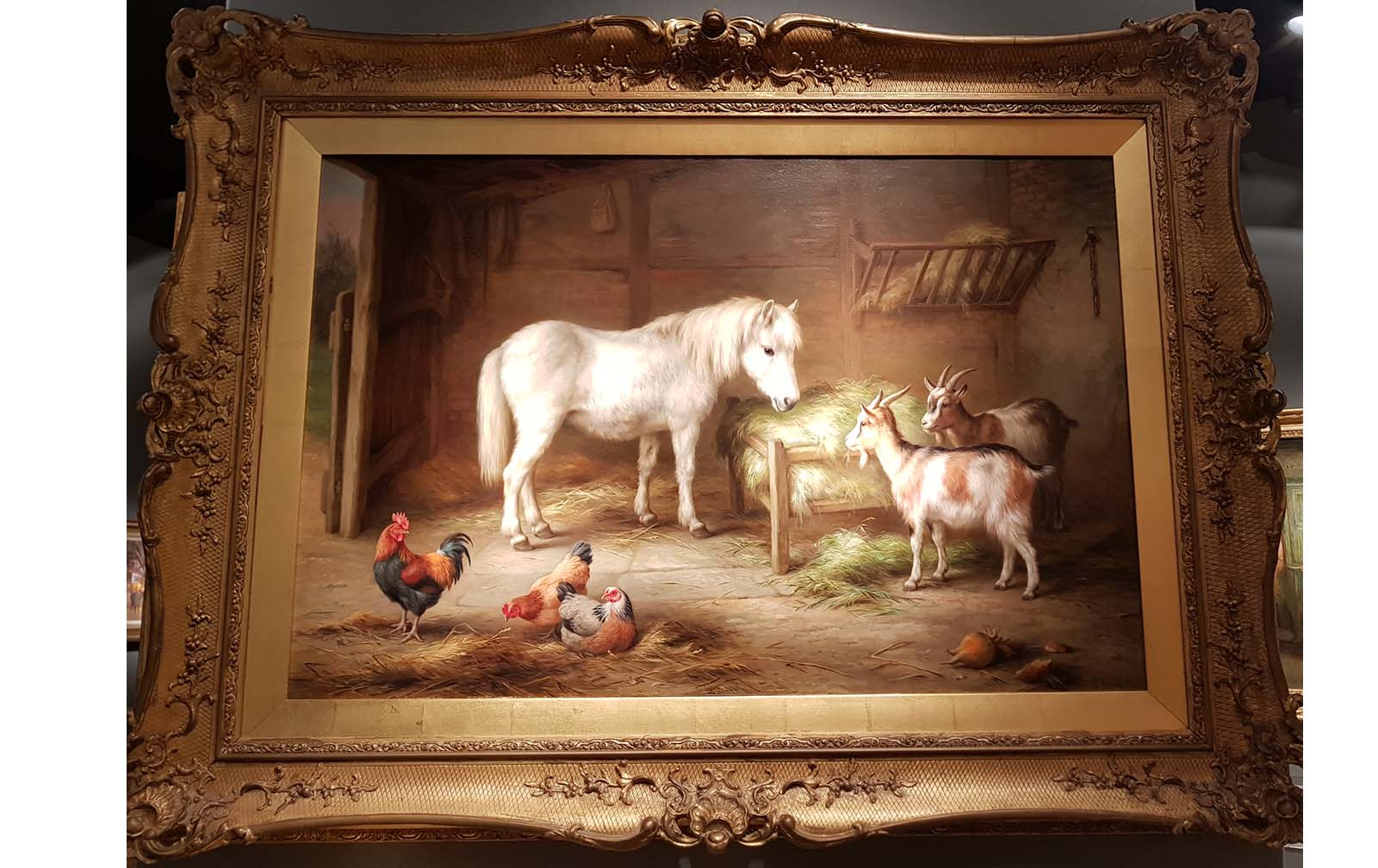
For me art is something that makes you feel relaxed and I think that pastoral scenes with animals, fields and sky are one of the most powerful ways to connect with the tranquillity of nature. When coming home from a busy world outside the door I think it's a balm for the soul. Above a painting by Edgar Hunt entitled Farmyard Companions was part of a series of rural idyll's offered by Haynes Fine Art. With soft toned light it captures the innocence of the life of farmyard animals, simply eating and making friends with their cohabitees on the farm. It's peaceful, gentle no harnesses, chains or leads. There is a sense of care in a safe environment but the animals are also free to wander as they please.
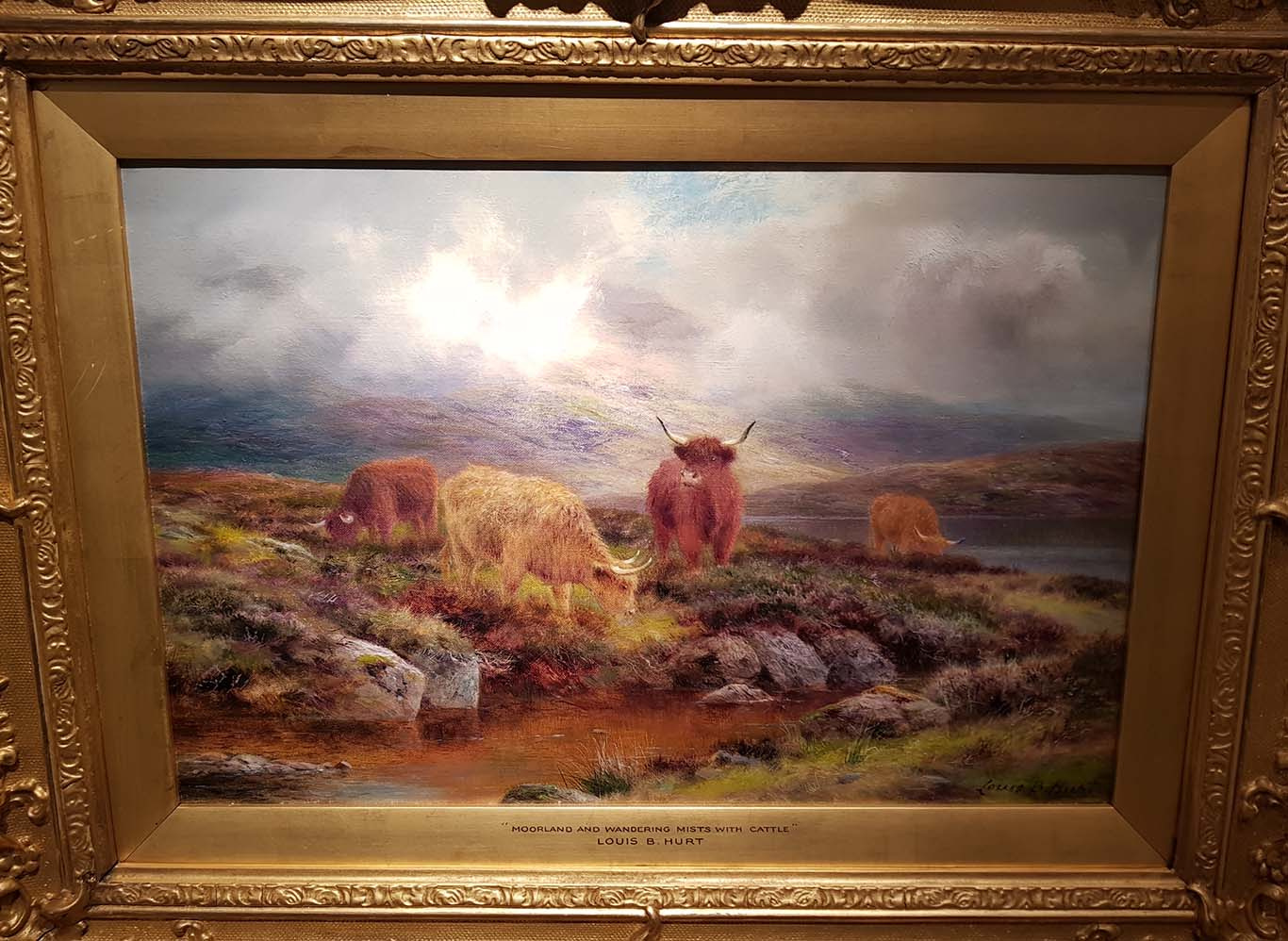
One of the places that is always in my heart is the rural expanse of Scotland. Two landscape canvases featuring Highland Cattle, who I think are the most adorable creatures, proudly sat amongst the collection offered by the gallery. The Scottish Coos are such majestic animals and I love the way that they colours of their thick fur blend in so well with their landscape. With their large horns they're like a cousin of the ancient Aurochs found across Bronze Age Europe still with us today. Even the baby ones are perfect with their Russet thick coat shining in the sun as they take their first early steps. Painted by Louis Hurt an artist from a family pursuing the same trade, these works are becoming increasingly collectable. I think it's a good thing as I believe that art can have a healing effect on people as well as calming. These scenes of wide open spaces speak of freedom, fresh air and water that can be found in the mountains in the north. At any time of year it feels like a welcoming moment to contemplate. Below the cattle appear to be moving as a family heard on to pastures new out of the mists. A shepherd speaks to a crofter in the background, keeping a watchful eye and perhaps admiring their thick fur ready for the coming winter.
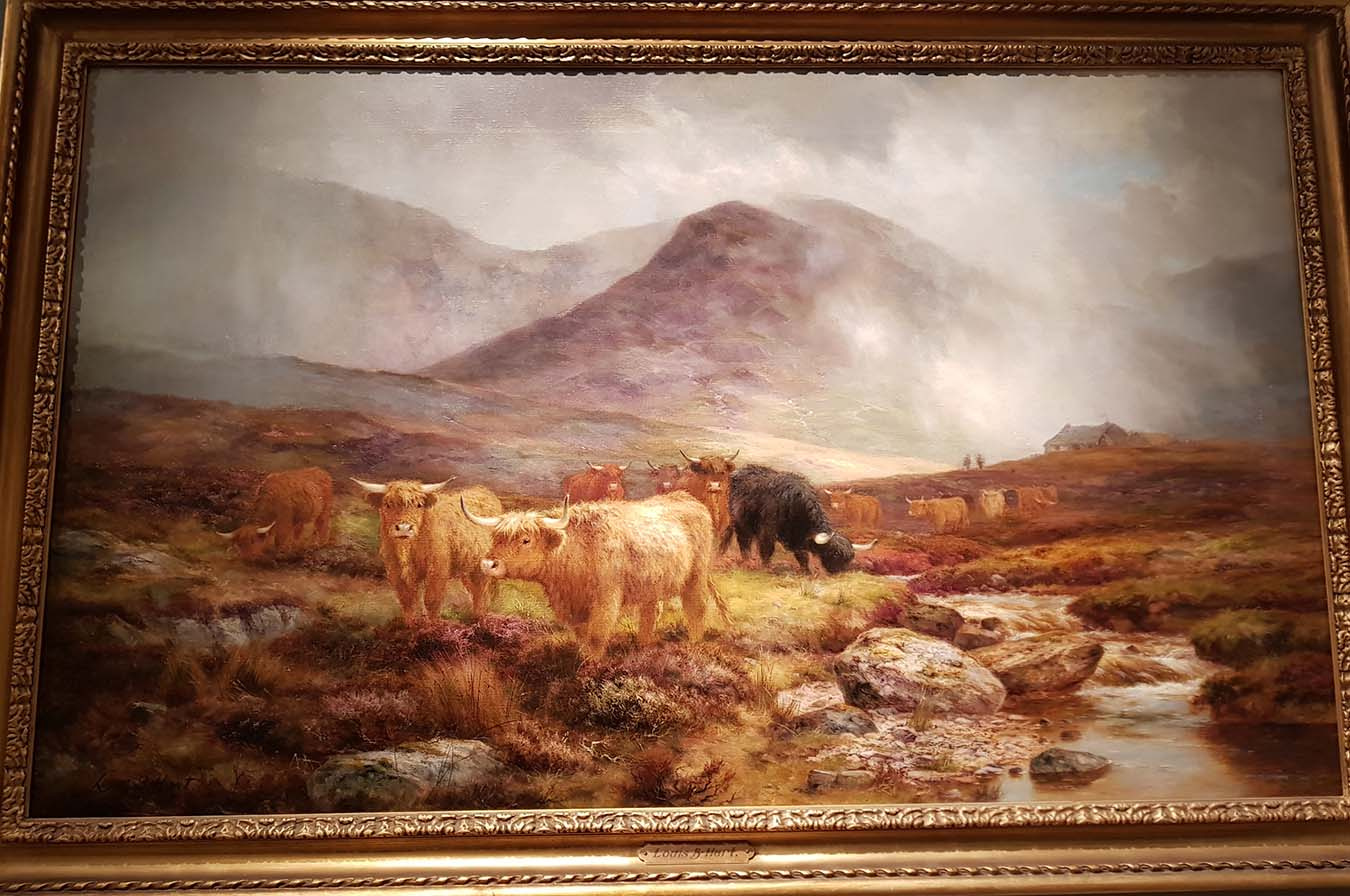
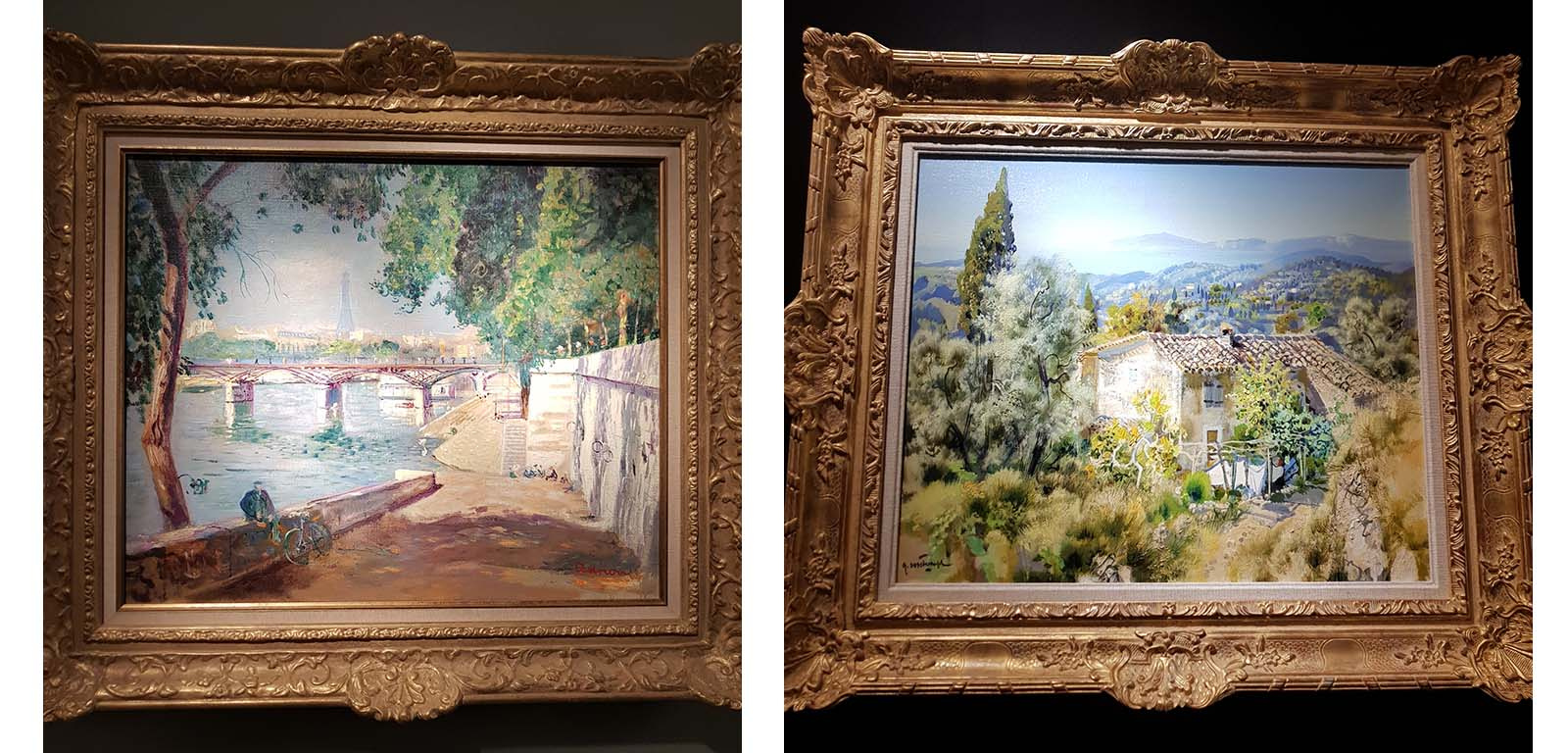
Scenes of France are always popular with clients internationally, be they views of the river or rural landscapes and Burlington Arts hosted two that particularly caught my eye. Above to the left a view of the Seine bank in Paris 'Below the Pont Des Arts' by Lucien Adrion. A view that many French and also British and international travellers would know so well. This early 20th century view of Paris was typical of the work of Adrion and other artists of the 19th and 20th centuries that was transported to walls in sitting rooms and hallways around the world. To the right a very different view of France. The France that most people living there know, rural, often tranquil and steeped in it's own myth and history. Aupres de Beaulieu by Gabriel Deschamps b.1919 captures the sweet rich colours of Southern France just nestled above the Cote d'Azur. What I love about this picture is the feeling of exploration of the un-spoilt landscape, villages, farmhouses and old manors away from the bustling populated coast. Deschamps paintings are popular all over the world and it's easy to see why his works now feature in many important collections.
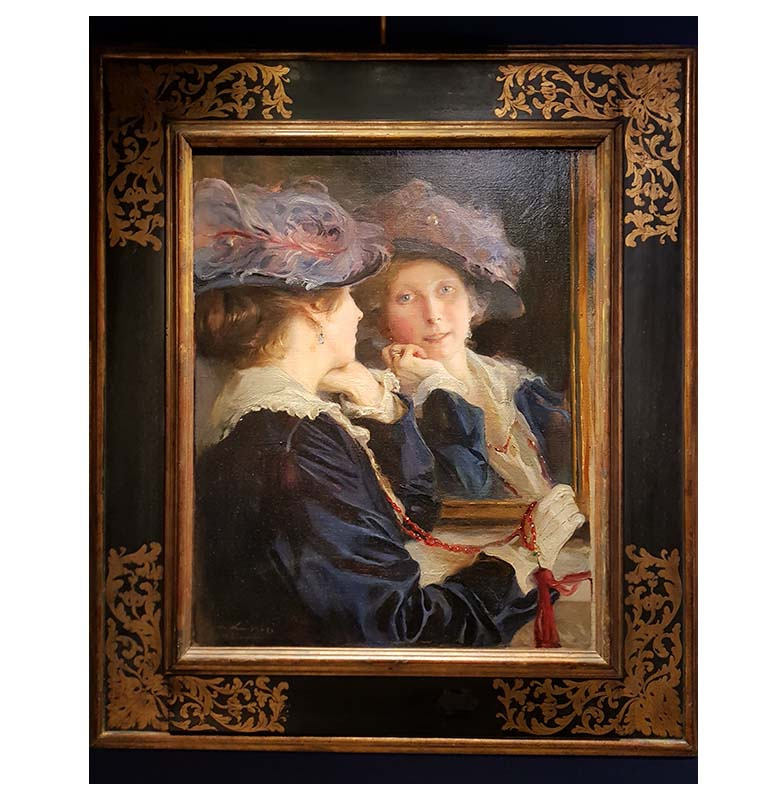
One special treat of the Art Fayre this year was to see the Bowes Museum from North East England exhibit a series of works from their and other private collections featuring the work of celebrated portrait painter Philip de Laszlo. The clarity of his work is memorable and here are just three of the special pieces that where on display. Through changing his name and creating a new identity he took himself to the top of High Society but what cannot be questioned in any way is both his talent and his strong work ethic.
He married an heiress from the Guinness family and this portrait of her, Lucy Madelaine Guiness with her classically Irish beauty is, I believe one of the most significant portraits of the 20th century. It's both the clarity and the composition that create this. A framed image within an image. Here she is both looking away from us and at us. Her gaze is casual, friendly and not coolly regarding or beckoning with curiosity. She meets you as an equal.
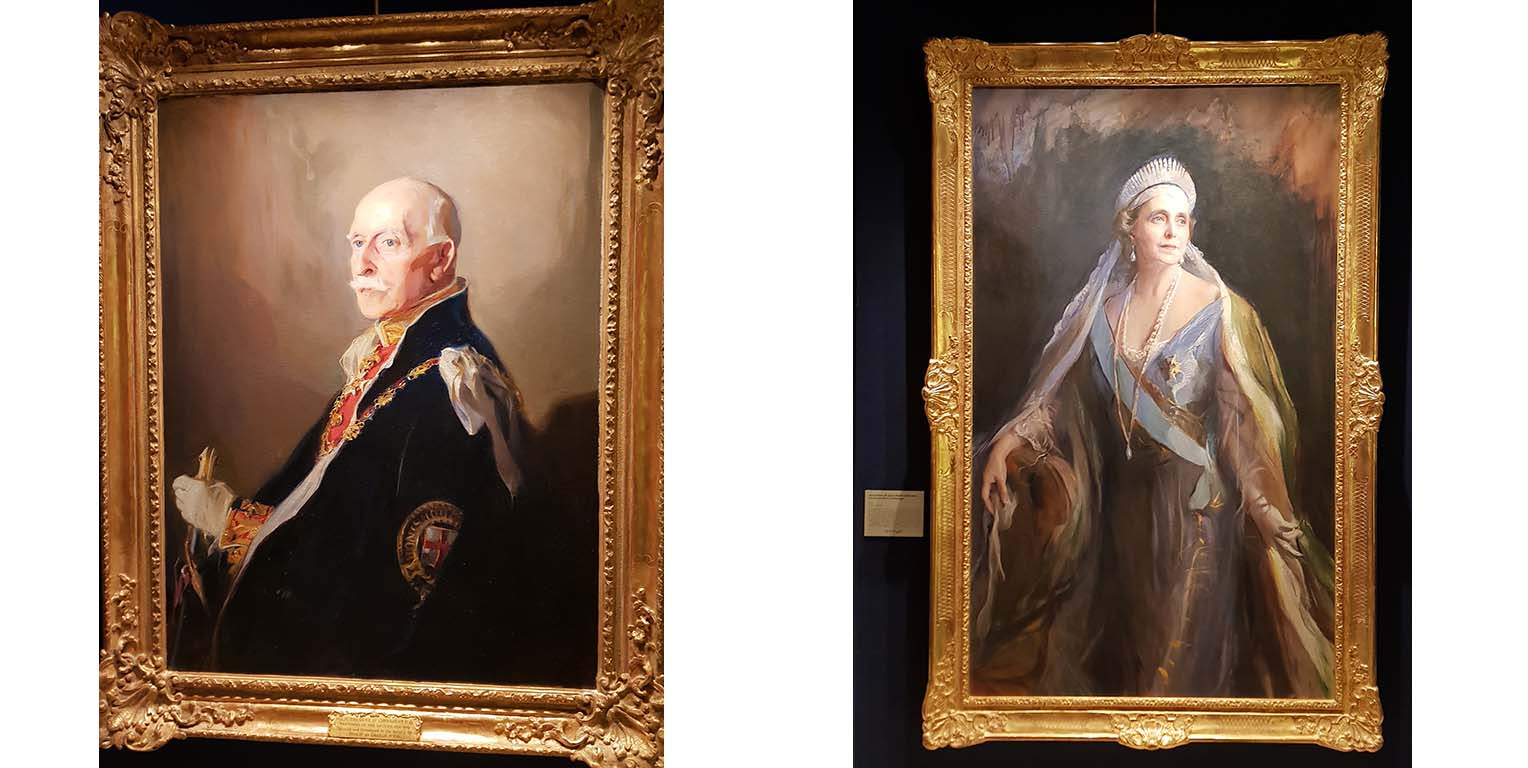
De Laslo painted an enormous number of characters from high society and numerous members of European Royal families. Here above are two paintings, to the left, I believe was one of Queen Victoria's sons Prince Arthur Duke of Connaught who lived to a very great age. Here he is shown in full ceremonial robes of the Order of the Garter. To the right a portrait of Princess Maria of Roumania shows de Laszlo's skill in painting fabric and fluidity of movement. It's something that you can see across many of his paintings beyond the set kindly shown at the fayre and I believe it's something that made me first remember the likeness of his images growing up.
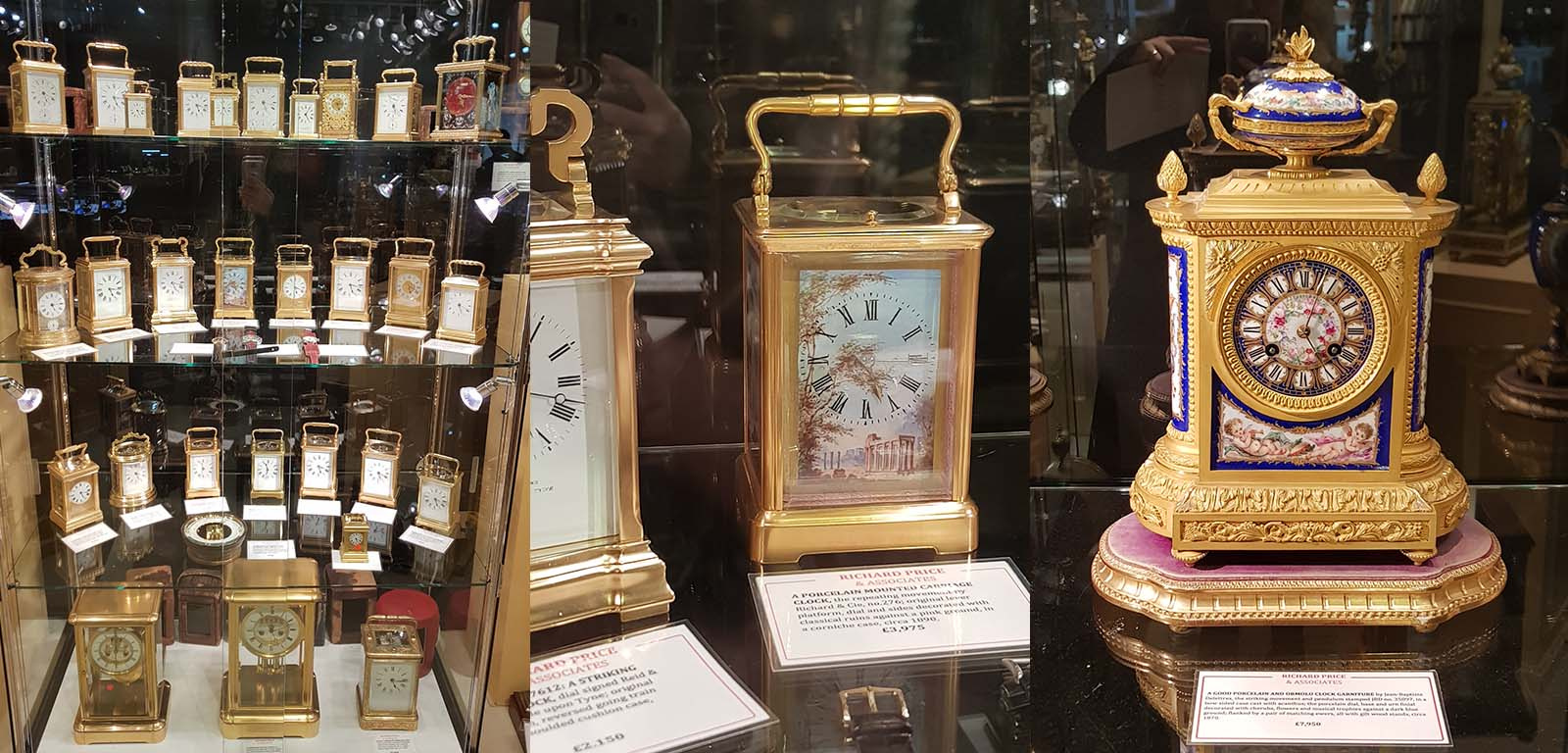
Another wonderful area of Antiques to explore are the clocks and Richard Price always gathers a fascinating array around him. These little carriage clocks give me fond memories of visiting elderly relatives when very small and above to the centre you can see a clock with a face panel illustrated with ruins of the Roman world. It's wildly romantic but also perhaps a very subtle hint that time is not to be wasted? To the right an opus of French enamel work of the 18th century and yours for less than eight thousand pounds. Given the price of contemporary pieces, cars and living costs today especially in London this seems like a tiny sum for something so precious and beautiful. When abstract pieces of art, sometimes difficult (if not impossible) to fathom seem to sell for millions, you begin to realise that there is some serious value to be found in these pieces of craft that will be still just as beautiful in five hundred years time.
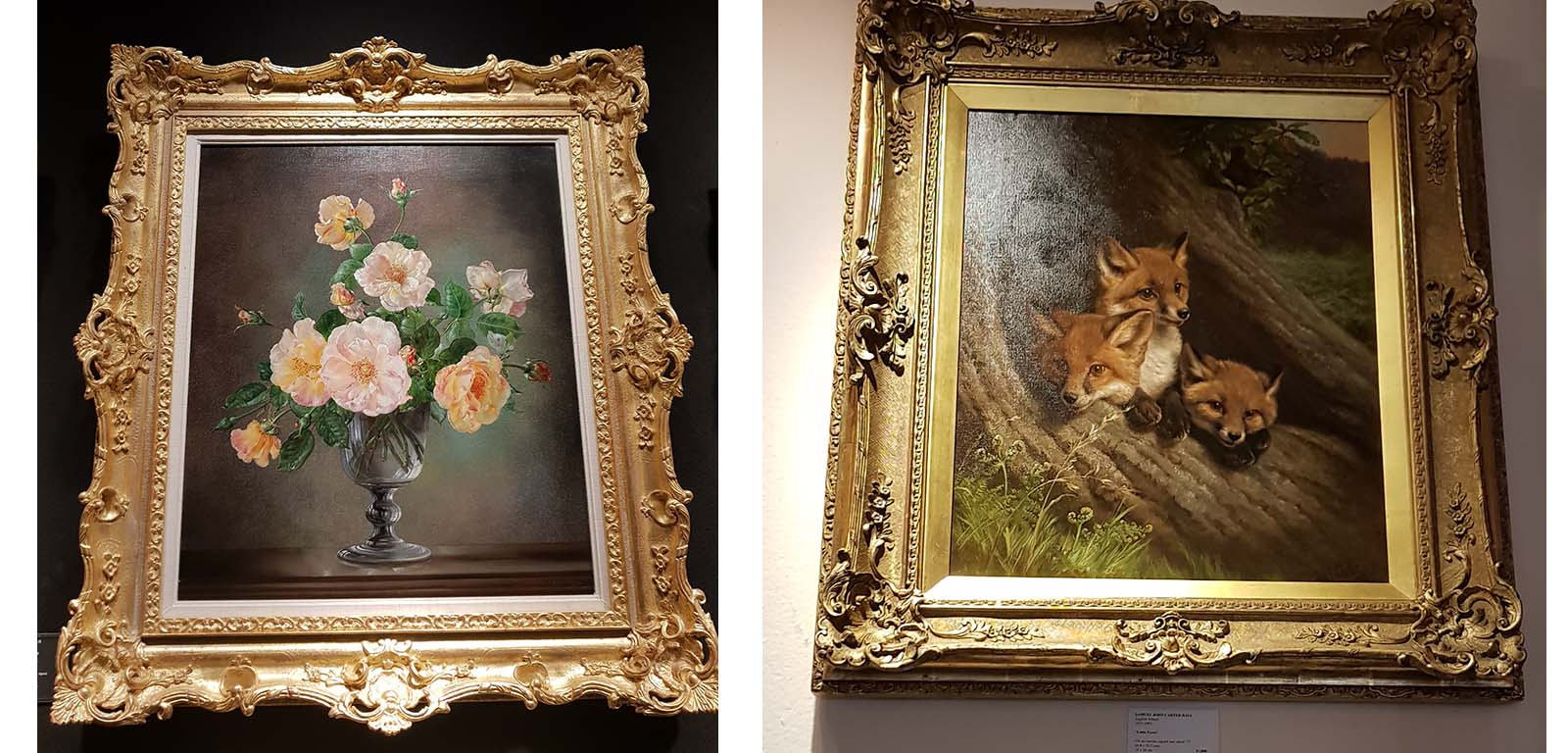
Some easy gentle viewing here also from Burlington to end the collection with some flowers, little button nosed Fox Cubs and a warren of Rabbit Kits nestled up with mum and strongly advised to 'Eat Up Your Greens'. This last painitng by Alfred Richarson Barber was a snip at £3,000 and would make a humorous corridor painting that children and grownups alike would enjoy.
